Samsung Electronics Co WB380F Digital Camera User Manual
Samsung Electronics Co Ltd Digital Camera
User manual

1
Warning—situations that could cause injury to yourself or others
Do not disassemble or attempt to repair your camera.
This may result in electric shock or damage to the camera.
Do not use your camera near ammable or explosive gases and liquids.
This may cause a fire or explosion.
Do not insert ammable materials into the camera or store these materials
near the camera.
This may cause a fire or electric shock.
Do not handle your camera with wet hands.
This may result in electric shock.
Prevent damage to subjects’ eyesight.
Do not use the ash in close proximity (closer than 1 m/3 ft) to people or animals.
If you use the ash too close to your subject’s eyes, you can cause temporary or
permanent eyesight damage.
Keep your camera away from small children and pets.
Keep your camera and all accessories out of the reach of small children and animals.
Small parts may cause choking or serious injury if swallowed. Moving parts and
accessories may present physical dangers as well.
Do not expose the camera to direct sunlight or high temperatures for an
extended period of time.
Prolonged exposure to sunlight or extreme temperatures can cause permanent
damage to your camera’s internal components.
Health and safety information
Always comply with the following precautions and usage tips to avoid dangerous situations and ensure peak performance of your camera.

2
Health and safety information
Avoid covering the camera or charger with blankets or clothes.
The camera may overheat, which may distort the camera or cause a re.
Do not handle the power supply cord or go near the charger during a
thunderstorm.
This may result in electric shock.
If liquid or foreign objects enter your camera, immediately disconnect all
power sources, such as the battery or charger, and then contact a Samsung
service center.
Comply with any regulations that restrict the use of a camera in a certain area.
Avoid interference with other electronic devices.
Turn o the camera when in an aircraft. Your camera can cause interference with
aircraft equipment. Follow all airline regulations and turn o your camera when
directed by airline personnel.
Turn o the camera near medical equipment. Your camera can interfere with
medical equipment in hospitals or health care facilities. Follow all regulations,
posted warnings, and directions from medical personnel.
Avoid interference with pacemakers.
Maintain the distance between this camera and all pacemakers to avoid potential
interference, as recommended by the manufacturer and research groups. If you
have any reason to suspect that your camera is interfering with a pacemaker
or other medical device, turn o the camera immediately and contact the
manufacturer of the pacemaker or medical device for guidance.

3
Health and safety information
Caution—situations that could cause damage to your camera or other
equipment
Remove the batteries from your camera when storing it for an extended period
of time.
Installed batteries may leak or corrode over time and cause serious damage to your
camera.
Use only authentic, manufacturer-recommended, Lithium-ion replacement
batteries. Do not damage or heat the battery.
Inauthentic, damaged, or heated batteries may cause a re or personal injury.
Use only Samsung-approved batteries, chargers, cables and accessories.
Using unauthorized batteries, chargers, cables or accessories can cause batteries
to explode, damage your camera, or cause injury.
Samsung is not responsible for damage or injuries caused by unapproved
batteries, chargers, cables or accessories.
Use the battery only for its intended purpose.
Misusing the battery may cause a fire or electric shock.
Do not touch the ash while it res.
The ash is very hot when red and may burn your skin.
When you use the AC charger, turn o the camera before you disconnect the
power to the AC charger.
Failing to do so may result in re or electric shock.
Disconnect the charger from the wall socket when not in use.
Failing to do so may result in re or electric shock.
Do not use a damaged power supply cord, plug, or loose outlet when you
charge batteries.
This may cause a fire or electric shock.
Do not allow the AC charger to come in contact with the +/- terminals on the
battery.
This may cause a re or electric shock.

4
Health and safety information
Do not drop or subject the camera to strong impacts.
Doing so may damage the screen or external or internal components.
Exercise caution when you connect cables or adapters and install batteries and
memory cards.
If you force the connectors, improperly connect cables, or improperly install
batteries and memory cards, you can damage ports, connectors, and accessories.
Keep cards with magnetic strips away from the camera case.
Information stored on the card may be damaged or erased.
Never use a damaged charger, battery, or memory card.
This may result in electric shock or camera malfunction or cause a re.
Do not place the camera in or near magnetic elds.
Doing so may cause the camera to malfunction.
Do not use the camera if the screen is damaged.
If the glass or acrylic parts are broken, visit a Samsung Electronics Service Center to
have the camera repaired.
Check that the camera is operating properly before use.
The manufacturer takes no responsibility for any loss of les or damage that may
result from camera malfunction or improper use.
You must plug the small end of the USB cable into your camera.
If the cable is reversed, it may damage your files. The manufacturer is not
responsible for any loss of data.
Avoid interference with other electronic devices.
Your camera emits radio frequency (RF) signals that may interfere with unshielded
or improperly shielded electronic equipment, such as pacemakers, hearing aids,
medical devices, and other electronic devices in homes or vehicles. Consult the
manufacturers of your electronic devices to solve any interference problems you
experience. To prevent unwanted interference, use only Samsung-approved devices
or accessories.
Use your camera in the normal position.
Avoid contact with your camera’s internal antenna.
Data transference and your responsibilities
Data transferred via WLAN can be hacked, so avoid transferring sensitive data in
public areas or on open networks.
The camera manufacturer is not liable for any data transfers that infringe on
copyrights, trademarks, intellectual property laws, or public decency ordinances.

5
Outline of the User Manual
Basic functions 19
Learn about your camera’s layout, icons, and basic functions for
shooting.
Extended functions 43
Learn how to capture a photo and record a video by selecting a
mode.
Shooting options 63
Learn how to set the options in Shooting mode.
Playback/Editing 86
Learn how to play back photos or videos, and edit photos. Also, learn
how to connect your camera to your computer or TV.
Wireless network 110
Learn how to connect to wireless local area networks (WLANs) and
use functions.
Settings 129
Refer to options to congure your camera’s settings.
Appendixes 135
Get information about error messages, specications, and
maintenance.
Copyright information
Microsoft Windows and the Windows logo are registered trademarks of the
Microsoft Corporation.
Mac and Apple App Store are registered trademarks of the Apple Corporation.
Google Play Store is a registered trademark of Google, Inc.
microSD™, microSDHC™, and microSDXC™ are registered trademarks of the SD
Association.
Wi-Fi®, the Wi-Fi CERTIFIED logo, and the Wi-Fi logo are registered trademarks of
the Wi-Fi Alliance.
Trademarks and trade names used in this manual are the property of their
respective owners.
Camera specications or contents of this manual may be changed without
prior notice due to an upgrade of the camera's functions.
We recommend using your camera within the country where you purchased it.
Use this camera responsibly and adhere to all laws and regulations concerning
its use.
You are not allowed to reuse or distribute any part of this manual without prior
permission.

6
Indicators used in this manual
Mode Indicator
Smart Auto
T
Program
p
Aperture Priority, Shutter Priority, Manual
G
Smart
s
Best Face
i
Magic Plus
g
Settings
n
Wi-Fi
w
Shooting mode icons
These icons appear in the text when a function is available in a mode. See the
example below.
Note: The
s
or
g
mode may not support functions for all scenes or modes.
For example:
Available in Program,
Aperture Priority, and
Shutter Priority modes
Icons used in this manual
Icon Function
Additional information
Safety warnings and precautions
[] Camera buttons. For example, [Shutter] represents the shutter button.
() Page number of related information
→
The order of options or menus you must select to perform a step; for
example: Select Face Detection → Normal (represents Select Face
Detection, and then select Normal).
*Annotation
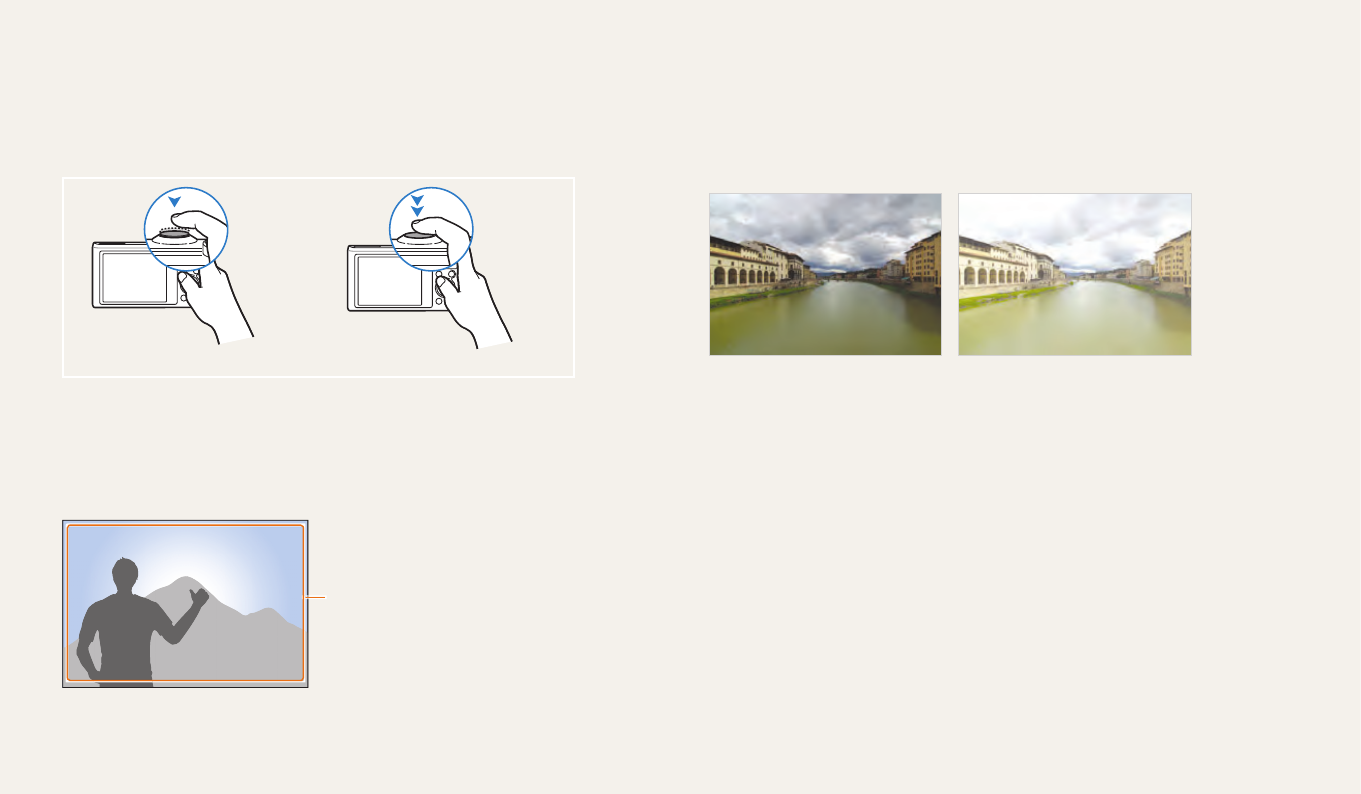
7
Pressing the shutter
Half-press [Shutter]: Press the shutter halfway down
Press [Shutter]: Press the shutter all the way down
Half-press [Shutter] Press [Shutter]
Subject, background, and composition
Subject: The main object in a scene, such as a person, animal, or still life
Background: The objects around the subject
Composition: The combination of a subject and background
Composition
Background
Subject
Exposure (Brightness)
The amount of light that enters your camera determines the exposure. You can alter
the exposure by changing the shutter speed, aperture value, or ISO sensitivity.
By altering the exposure, your photos will be darker or lighter.
S
Normal exposure
S
Overexposure (too bright)
Expressions used in this manual
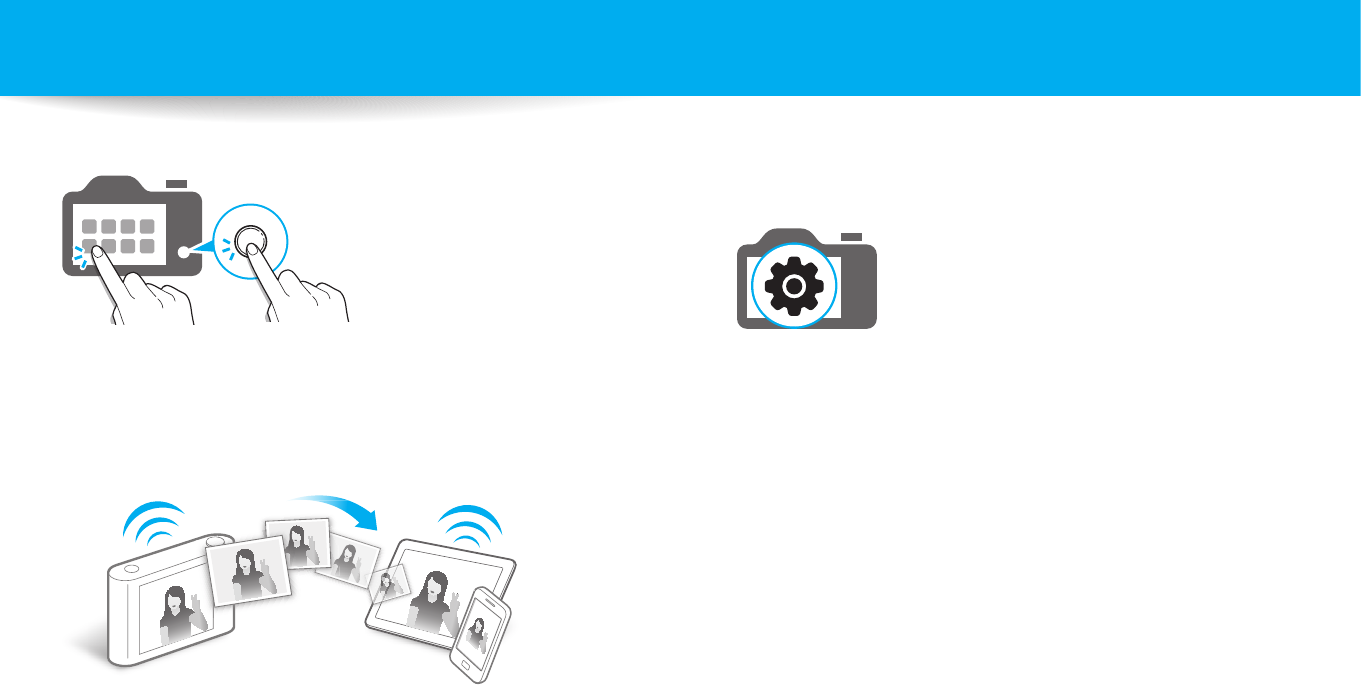
8
Special features of your camera
Setting a DIRECT LINK button option
You can select a Wi-Fi function to launch when you press the DIRECT LINK button.
1 Access Settings.
2 Access the DIRECT LINK button option.
3 Select a Wi-Fi feature from the list.
Using the Touch screen and camera buttons
You can operate the camera by either touching the screen or pressing the camera
buttons.
Using the DIRECT LINK button
Press the DIRECT LINK button to activate the Wi-Fi function that you have
designated.
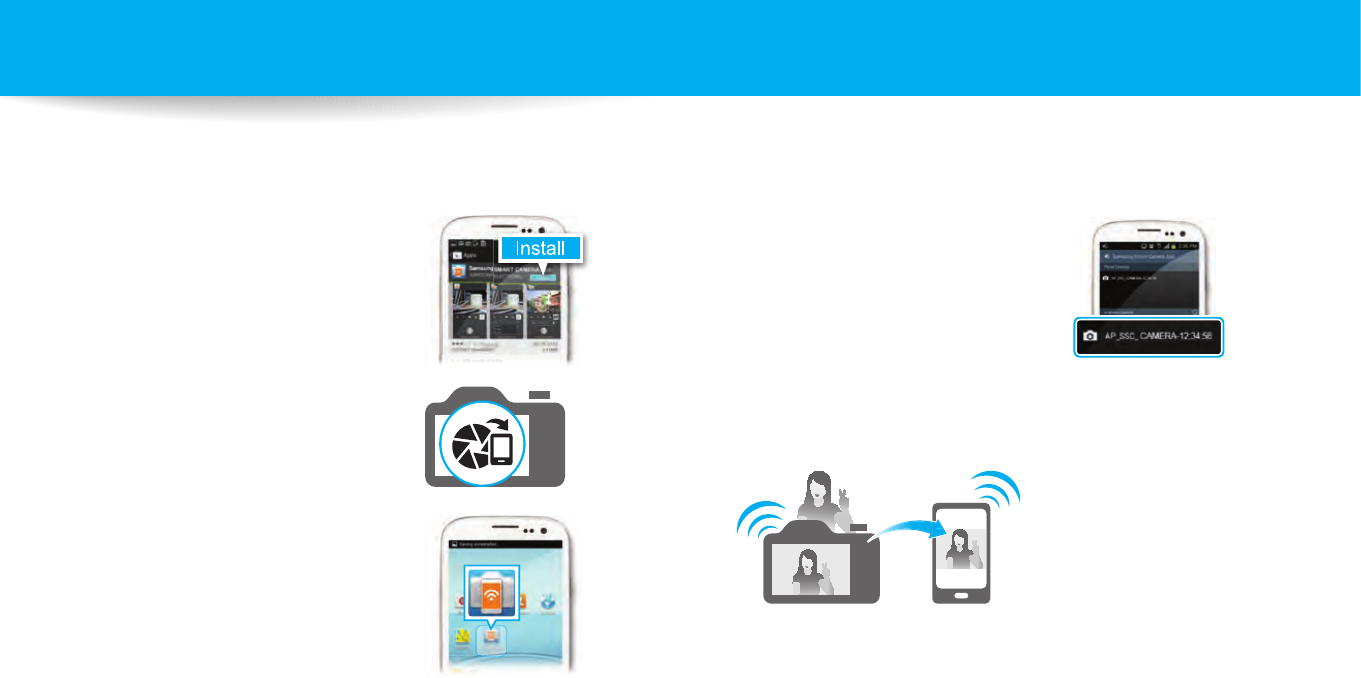
9
Special features of your camera
Using AutoShare
When you capture a photo with your camera, the photo is saved to the smart phone automatically. The camera connects to a smart phone wirelessly.
4 Select the camera from the list and
connect the smart phone to the
camera.
If a pop-up message appears on your
camera, allow the smart phone to
connect to your camera.
5 Capture a photo.
The captured photo is saved to the camera, and then transferred to the
smart phone.
1 Install Samsung SMART CAMERA
App on the smart phone.
2 Turn on the AutoShare feature.
3 Launch Samsung SMART CAMERA
App on the smart phone.

10
Special features of your camera
Using MobileLink
You can send les easily from your camera to a smart phone. The camera connects wirelessly to smart phones that support the MobileLink feature.
4 Select the camera from the list and
connect the smart phone to the
camera.
If a pop-up message appears on your
camera, allow the smart phone to
connect to your camera.
5 On the smart phone or camera,
select les to transfer from the
camera.
6 On the smart phone, touch the copy
button or on the camera, select
Share.
1 Install Samsung SMART CAMERA
App on the smart phone.
2 Access the MobileLink mode.
If a pop-up message appears, select an
option.
3 Launch Samsung SMART CAMERA
App on the smart phone.
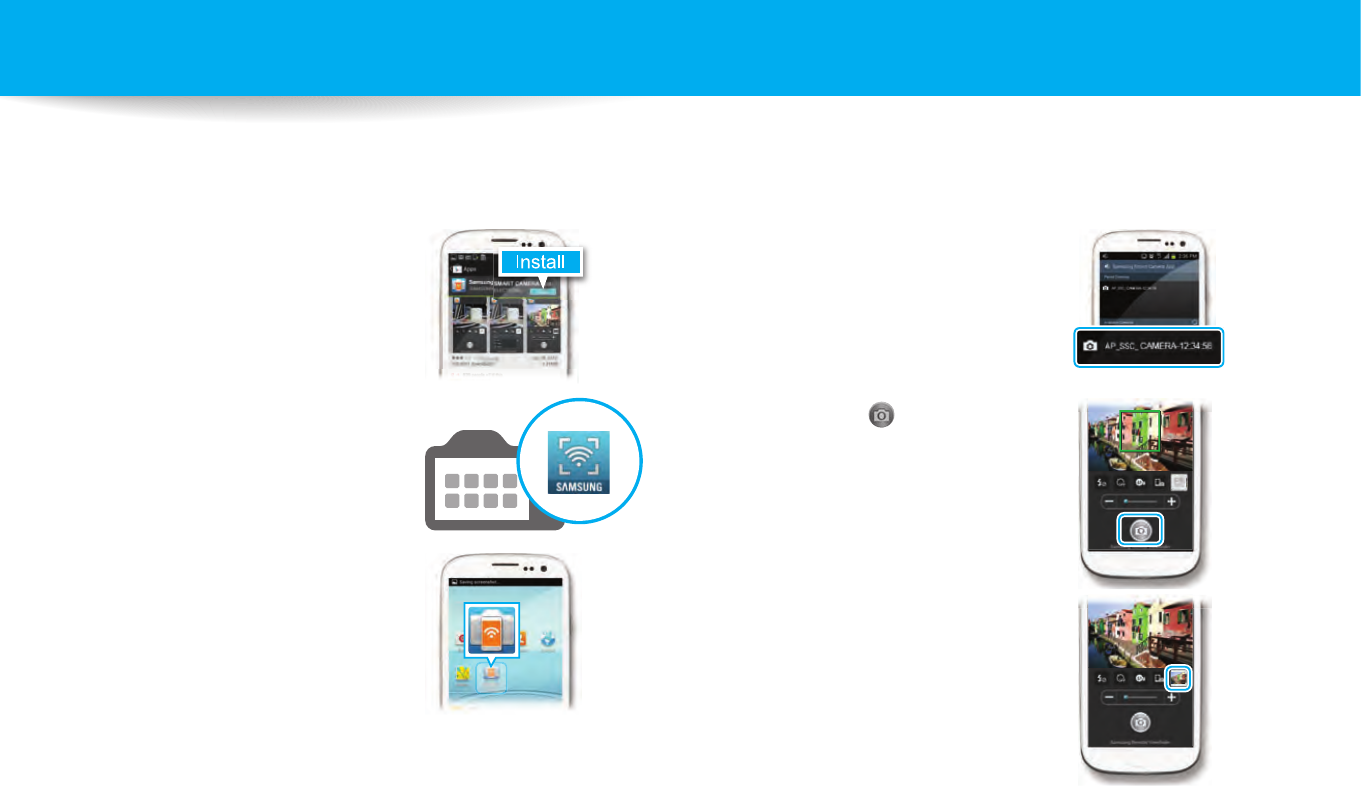
11
Special features of your camera
Using Remote Viewnder
You can remotely control your camera from a smart phone. The camera connects to a smart phone wirelessly. Use the smart phone as a remote shutter release with the Remote
Viewnder feature. The captured photo will appear on the smart phone.
4 Select the camera from the list and
connect the smart phone to the
camera.
If a pop-up message appears on your
camera, allow the smart phone to
connect to your camera.
5 Touch and hold to focus, and
then release it to capture a photo.
6 Touch the thumbnail to view the
photo.
1 Install Samsung SMART CAMERA
App on the smart phone.
2 Access the Remote Viewnder
mode.
3 Launch Samsung SMART CAMERA
App on the smart phone.
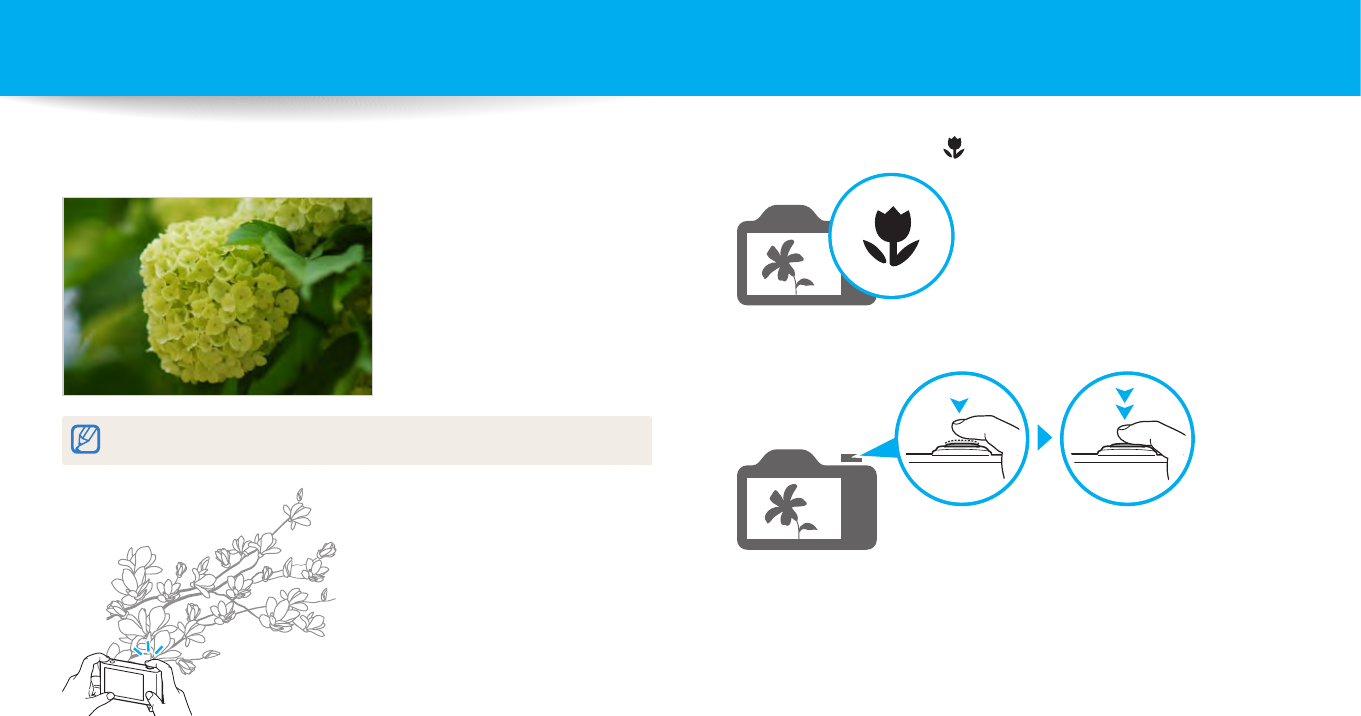
12
Shooting samples – Macro
You can capture close up shots of small subjects, such as owers or insects.
The example image may dier from the actual photo that you capture.
1 Select the macro option ( ).
2 Capture a photo.
Special features of your camera

13
Basic troubleshooting
Learn to solve common problems by setting shooting options.
The subject’s eyes
appear red.
Red eye occurs when the subject's eyes reect light from the camera ash.
Set the ash option to Red-eye or Red-eye Fix. (p. 66)
If the photo has already been captured, select Red-eye Fix in the edit menu. (p. 99)
Photos have dust spots. If dust particles are present in the air, you may capture them in photos when you use the ash.
Turn o the ash or avoid capturing photos in a dusty place.
Set ISO sensitivity options. (p. 69)
Photos are blurred. Blurring can occur if you capture photos in low light conditions or hold the camera incorrectly.
Use the OIS function or half-press [Shutter] to ensure the subject is in focus. (p. 41)
Photos are blurred when
shooting at night.
As the camera tries to let in more light, the shutter speed slows. This can make it dicult to hold the camera steady long
enough to capture a clear photo and may result in camera shake.
Select Low Light Shot in
s
mode. (p. 51)
Turn on the ash. (p. 67)
Set ISO sensitivity options. (p. 69)
Use a tripod to prevent your camera from shaking.
Subjects come out
too dark because of
backlighting.
When the light source is behind the subject or when there is a high contrast between light and dark areas, the subject may
appear too dark.
Avoid shooting toward the sun.
Set the ash option to Fill in. (p. 67)
Adjust the exposure. (p. 77)
Set the Auto Contrast Balance (ACB) option. (p. 78)
Set the metering option to Spot if a subject is in the center of the frame. (p. 78)

14
Quick reference
Capturing photos of people
s
mode > Beauty Face
f
51
i
mode
f
54
Red-eye/Red-eye Fix (to prevent or correct red-eye)
f
66
Face Detection
f
75
Self-Portrait
f
75
Capturing photos at night or in the dark
s
mode > Silhouette, Fireworks, Light Trace,
Low Light Shot
f
51
Flash options
f
67
ISO sensitivity (to adjust the sensitivity to light)
f
69
Capturing action photos
Shutter Priority mode
f
49
s
mode > Action Freeze, Continuous Shot
f
51
Continuous
f
82
Capturing photos of text, insects, or
owers
s
mode > Macro
f
51
Macro
f
70
Adjusting the exposure (brightness)
s
mode > Rich Tones
f
51
ISO sensitivity (to adjust the sensitivity to light)
f
69
EV (to adjust exposure)
f
77
ACB (to compensate for subjects against bright
backgrounds)
f
78
Metering
f
78
AE Bracket (to capture 3 photos of the same scene with
dierent exposures)
f
83
Capturing photos of scenery
s
mode > Landscape, Waterfall
f
51
s
mode > Panorama
f
52
Applying eects to photos
g
mode > My Magic Frame
f
55
g
mode > Motion Photo
f
57
g
mode > Photo Filter
f
58
Image Adjust (to adjust Sharpness, Contrast, or
Saturation)
f
84
Applying eects to videos
g
mode > Movie Filter
f
59
Reducing camera shake
Optical Image Stabilization (OIS)
f
40
Viewing les as thumbnails
f
89
Viewing les by category
f
89
Deleting all les on the memory
f
91
Viewing les as a slide show
f
93
Viewing les on a TV
f
100
Connecting your camera to a computer
f
101
Sending photos or videos via email
f
123
Using photo or video sharing websites
f
124
Adjusting sound and volume
f
131
Adjusting the brightness of the display
f
131
Changing the display language
f
133
Setting the date and time
f
133
Before contacting a service center
f
147

15
Contents
Extended functions
....................................................................................................... 43
Using the Smart Auto mode ................................................................................. 44
Using the Program mode ...................................................................................... 46
Using the Aperture Priority, Shutter Priority, or Manual mode ............... 47
Using the Aperture Priority mode ....................................................................... 48
Using the Shutter Priority mode .......................................................................... 49
Using the Manual mode ........................................................................................ 50
Using the Smart mode ............................................................................................ 51
Using the Panorama mode ................................................................................... 52
Using the Best Face mode ..................................................................................... 54
Using the Magic Plus mode .................................................................................. 55
Using the My Magic Frame mode ........................................................................ 55
Using the Motion Photo mode ............................................................................ 57
Using the Photo Filter mode ................................................................................ 58
Using the Movie Filter mode ................................................................................ 59
Recording a video .................................................................................................... 60
Recording a video with the Smart Scene Detection function ........................ 61
Basic functions
................................................................................................................. 19
Unpacking ................................................................................................................... 20
Camera layout ............................................................................................................ 21
Using the DIRECT LINK button ............................................................................. 23
Inserting the battery and memory card .......................................................... 24
Charging the battery and turning on your camera ..................................... 25
Charging the battery ............................................................................................. 25
Turning on your camera ........................................................................................ 25
Performing the initial setup ................................................................................. 26
Learning icons ........................................................................................................... 28
Selecting modes ....................................................................................................... 29
Icons on the Mode screen ..................................................................................... 29
Selecting options or menus .................................................................................. 31
Selecting with buttons .......................................................................................... 31
Selecting by touch ................................................................................................. 32
Using Smart Panel .................................................................................................. 34
Setting the display and sound ............................................................................. 35
Setting the display type ........................................................................................ 35
Setting the sound ................................................................................................... 36
Capturing photos ..................................................................................................... 37
Zooming .................................................................................................................. 38
Reducing camera shake (OIS) ............................................................................... 40
Tips for getting a clearer photo ........................................................................... 41

16
Contents
Shooting options
............................................................................................................ 63
Selecting a resolution and quality ..................................................................... 64
Selecting a resolution ............................................................................................ 64
Selecting a photo quality ...................................................................................... 65
Shooting in the dark ................................................................................................ 66
Preventing red-eye ................................................................................................. 66
Using the ash ........................................................................................................ 66
Setting a ash option ............................................................................................. 67
Adjusting the ISO sensitivity ................................................................................. 69
Changing the camera’s focus ............................................................................... 70
Using macro ............................................................................................................ 70
Using auto focus ..................................................................................................... 70
Adjusting the focus area ....................................................................................... 72
Adjusting the focus by touch ............................................................................... 72
Using Face Detection .............................................................................................. 75
Detecting faces ....................................................................................................... 75
Capturing a self portrait shot ............................................................................... 75
Capturing a smile shot ........................................................................................... 76
Tips for detecting faces ......................................................................................... 76
Adjusting brightness and color ........................................................................... 77
Adjusting the exposure manually (EV) ............................................................... 77
Compensating for backlighting (ACB) ................................................................ 78
Changing the metering option ............................................................................ 78
Selecting a White Balance setting ....................................................................... 79
Using burst modes ................................................................................................... 82
Capturing continuous photos .............................................................................. 82
Using the timer ....................................................................................................... 83
Capturing bracketed photos ................................................................................ 83
Adjusting images ..................................................................................................... 84
Reducing the sound of the zoom ....................................................................... 85

17
Contents
Playback/Editing
............................................................................................................. 86
Viewing photos or videos in Playback mode ................................................. 87
Starting Playback mode ........................................................................................ 87
Viewing photos ....................................................................................................... 92
Playing a video ........................................................................................................ 94
Editing a photo .......................................................................................................... 96
Resizing photos ...................................................................................................... 96
Rotating a photo .................................................................................................... 96
Cropping a photo ................................................................................................... 97
Applying Smart Filter eects ................................................................................ 97
Adjusting your photos ........................................................................................... 98
Viewing les on a TV ............................................................................................. 100
Transferring les to the computer ................................................................... 101
Transferring les to your Windows OS computer ........................................... 101
Transferring les to your Mac OS computer .................................................... 102
Using programs on a computer ........................................................................ 104
Installing i-Launcher ............................................................................................ 104
Using i-Launcher .................................................................................................. 105
Wireless network
..........................................................................................................110
Connecting to a WLAN and conguring network settings ..................... 111
Connecting to a WLAN ........................................................................................ 111
Using the login browser ...................................................................................... 112
Network connection tips .................................................................................... 113
Entering text .......................................................................................................... 114
Saving les to a smart phone automatically ................................................ 115
Sending photos or videos to a smart phone ................................................ 116
Using a smart phone as a remote shutter release ...................................... 117
Using Auto Backup to send photos or videos .............................................. 119
Installing the program for Auto Backup on your PC ....................................... 119
Sending photos or videos to a PC ..................................................................... 119
Sending photos or videos via email ................................................................ 121
Changing email settings ..................................................................................... 121
Sending photos or videos via email .................................................................. 123
Using photo or video sharing websites ......................................................... 124
Accessing a website ............................................................................................. 124
Uploading photos or videos ............................................................................... 124
Using AllShare Play to send les ....................................................................... 126
Uploading photos to online storage ................................................................. 126
Viewing photos or videos on devices that support Samsung Link. ............. 127

18
Contents
Settings
............................................................................................................................. 129
Settings menu ......................................................................................................... 130
Accessing the settings menu ............................................................................. 130
Sound ..................................................................................................................... 131
Display .................................................................................................................... 131
Connectivity .......................................................................................................... 132
General ................................................................................................................... 133
Appendixes
.....................................................................................................................135
Error messages ........................................................................................................ 136
Camera maintenance ............................................................................................ 138
Cleaning your camera .......................................................................................... 138
Using or storing the camera ............................................................................... 139
About memory cards ........................................................................................... 140
About the battery ................................................................................................. 143
Before contacting a service center ................................................................... 147
Camera specications ........................................................................................... 150
Glossary ..................................................................................................................... 154
Index ........................................................................................................................... 159

Unpacking
……………………………………… 20
Camera layout
…………………………………… 21
Using the DIRECT LINK button
………………… 23
Inserting the battery and memory card
……… 24
Charging the battery and turning on
your camera
……………………………………… 25
Charging the battery
…………………………… 25
Turning on your camera
……………………… 25
Performing the initial setup
…………………… 26
Learning icons
…………………………………… 28
Selecting modes
………………………………… 29
Icons on the Mode screen
……………………… 29
Selecting options or menus
…………………… 31
Selecting with buttons
………………………… 31
Selecting by touch
……………………………… 32
Using Smart Panel
……………………………… 34
Setting the display and sound
………………… 35
Setting the display type
………………………… 35
Setting the sound
……………………………… 36
Capturing photos
……………………………… 37
Zooming
……………………………………… 38
Reducing camera shake (OIS)
………………… 40
Tips for getting a clearer photo
………………… 41
Basic functions
Learn about your camera’s layout, icons, and basic functions for shooting.

Basic functions
20
Unpacking
The following items are included in your product box.
Camera AC adapter/USB cable
Rechargeable battery Strap
Quick Start Guide
Optional accessories
Camera case A/V cable
Battery charger Memory card/
Memory card adapter
The illustrations may dier slightly from the items shipped with your product.
The items included in the box may dier depending on the model.
You can purchase optional accessories at a retailer or a Samsung service center.
Samsung is not responsible for any problems caused by using unauthorized
accessories.
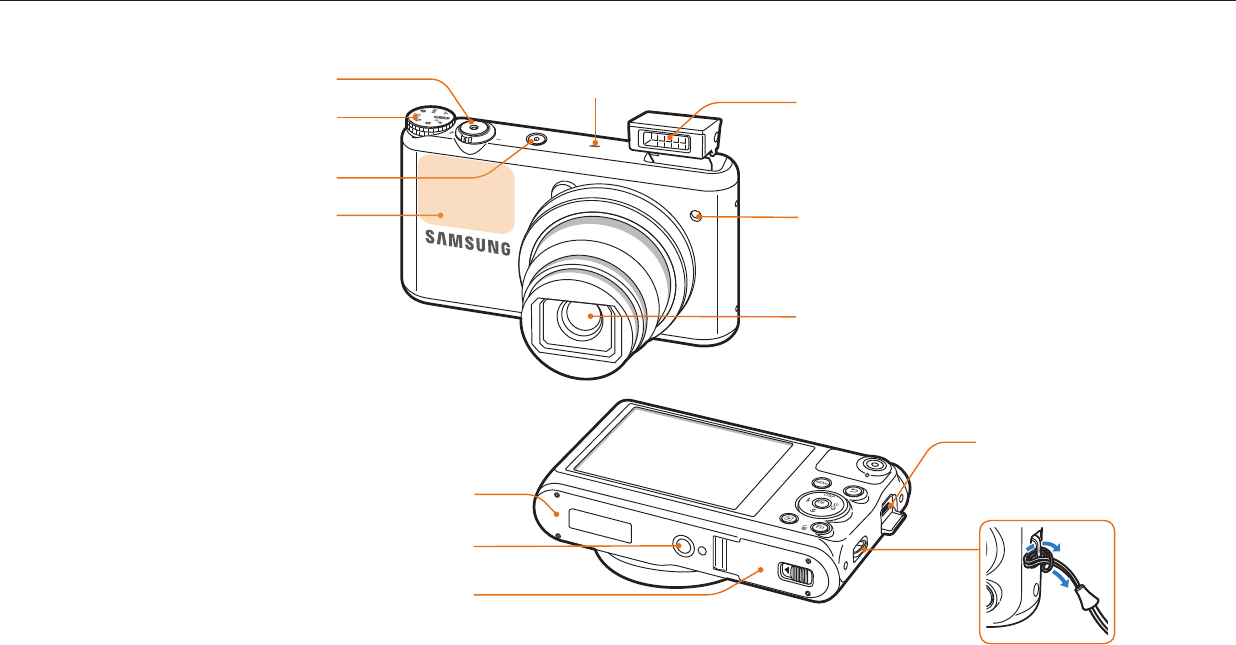
Basic functions
21
Camera layout
Before you start, familiarize yourself with your camera’s parts and their functions.
Tripod mount
Power button
Internal antenna*
* Avoid contact with the internal
antenna while using the wireless
network.
Lens
Shutter button
AF-assist light/Timer lamp
Flash*
* While not in use, keep the ash unit closed to prevent damage.
Forcing to open the ash unit may cause damage to your camera.
USB and A/V port
Accepts USB cable and A/V cable
Microphone
Battery chamber cover
Insert a memory card and battery
Mode dial
(p. 29)
Attaching the strap
x
y
Speaker

Camera layout
Basic functions
22
Buttons
(p. 23)
Status lamp
Blinking: When the camera is saving a photo or video,
being read by a computer, when the image is out of focus,
there is a problem charging the battery, or when the
camera is connecting to WLAN or sending a photo
Steady: When the camera is connected to a computer,
charging the battery, or when the image is in focus
Display
Zoom button
In Shooting mode: Zoom in or out
In Playback mode: Zoom in on part of a photo or view
les as thumbnails, or adjust the volume
DIRECT LINK button
Start a preset Wi-Fi function
NFC tag
Flash pop-up button
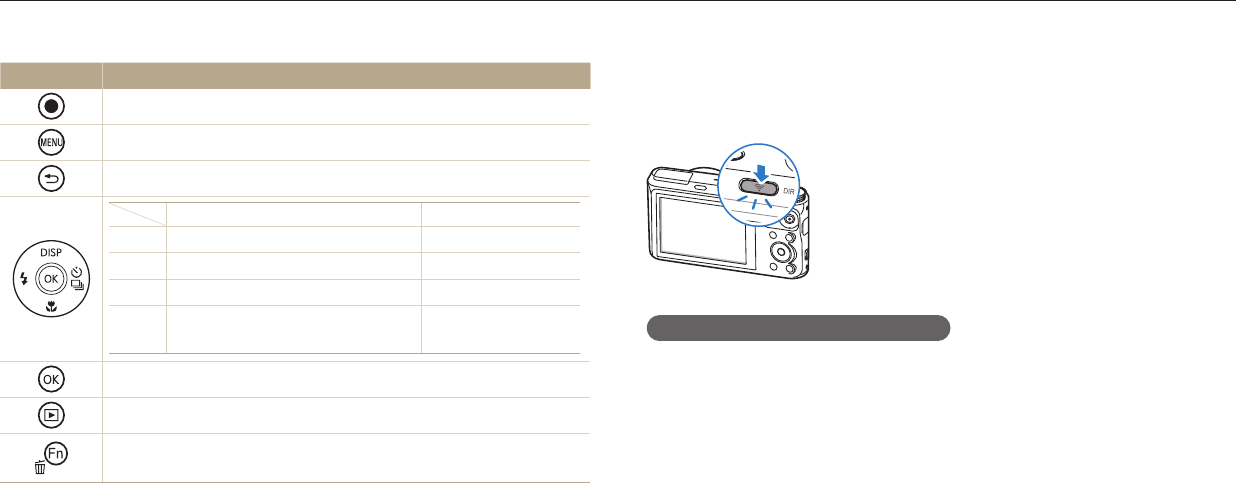
Camera layout
Basic functions
23
Buttons
Button Description
Start recording a video.
Access options or menus.
Go back.
Basic functions Other functions
D
Change the display option. Move up
c
Change the macro option. Move down
F
Change the ash option. Move left
t
Change the timer and burst
options. Move right
Conrm the highlighted option or menu.
Enter Playback mode.
Open Smart Panel in Shooting mode.
Delete les in Playback mode.
Using the DIRECT LINK button
You can turn on the Wi-Fi feature conveniently with [DIRECT LINK].
Press [DIRECT LINK] to activate the Wi-Fi function that you have designated.
Press [DIRECT LINK] again to return to the previous mode.
Setting a DIRECT LINK button option
You can select a Wi-Fi function to launch when you press [DIRECT LINK].
1 Rotate the mode dial to
n
.
2 Select General → DIRECT LINK (Wi-Fi Button).
3 Select a Wi-Fi feature. (p. 134)
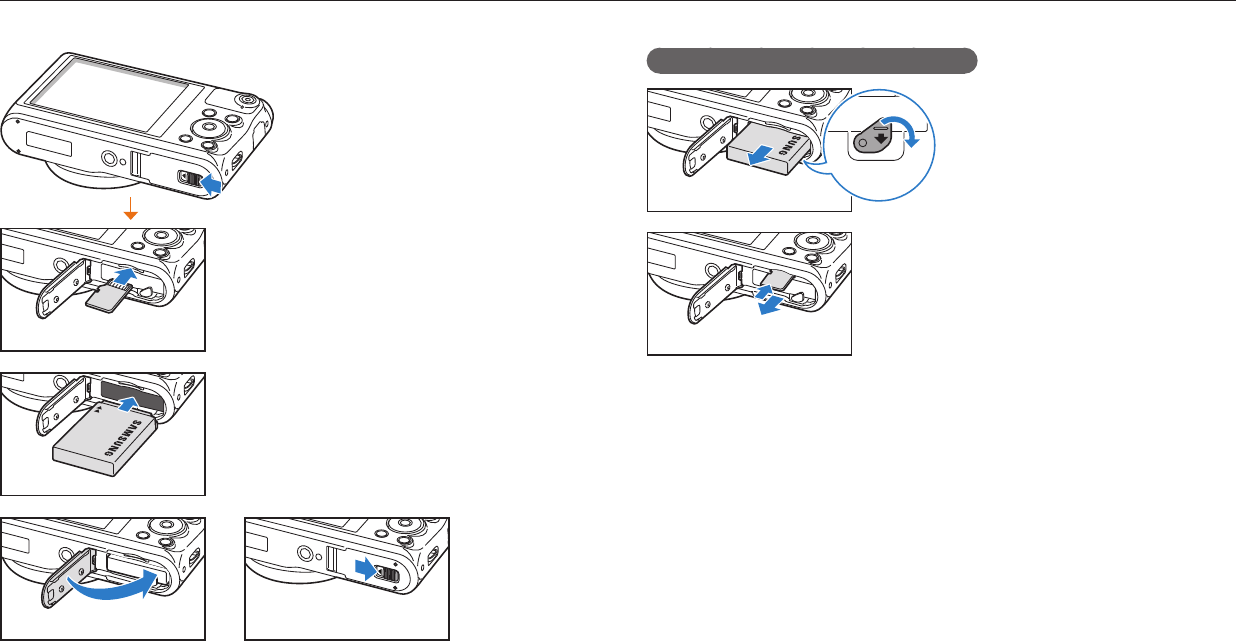
Basic functions
24
Inserting the battery and memory card
Learn how to insert the battery and an optional memory card into the camera.
Removing the battery and memory card
Rechargeable battery
Battery lock
Slide the lock down to release
the battery.
Memory card
Push the card gently until it disengages
from the camera, and then pull it out of
the slot.
Memory card
Insert a memory card with the gold-
colored contacts facing up.
Rechargeable battery
Insert the battery with the Samsung
logo facing up.
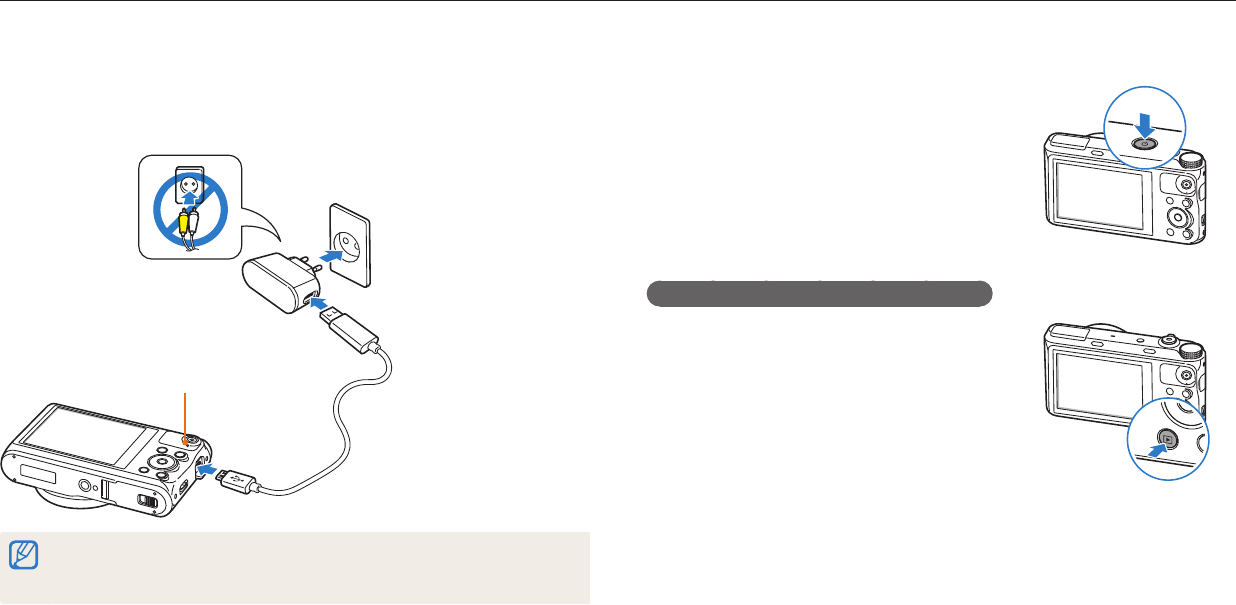
Basic functions
25
Charging the battery and turning on your camera
Turning on your camera
Press [
X
] to turn your camera on or o.
The initial setup screen appears when you turn on
the camera for the rst time. (p. 26)
Turning on your camera in Playback mode
Press [
P
]. The camera turns on and immediately
accesses Playback mode.
Charging the battery
Before you use the camera for the rst time, you must charge the battery. Plug the
small end of the USB cable into your camera, and then plug the other end of the
USB cable into the AC adapter.
Status lamp
Red light on: Charging
Red light o: Fully charged
Red light blinking: Error
Use only the AC adapter and USB cable supplied with your camera. If you use
another AC adapter (such as SAC-48), the camera battery may not charge or work
properly.
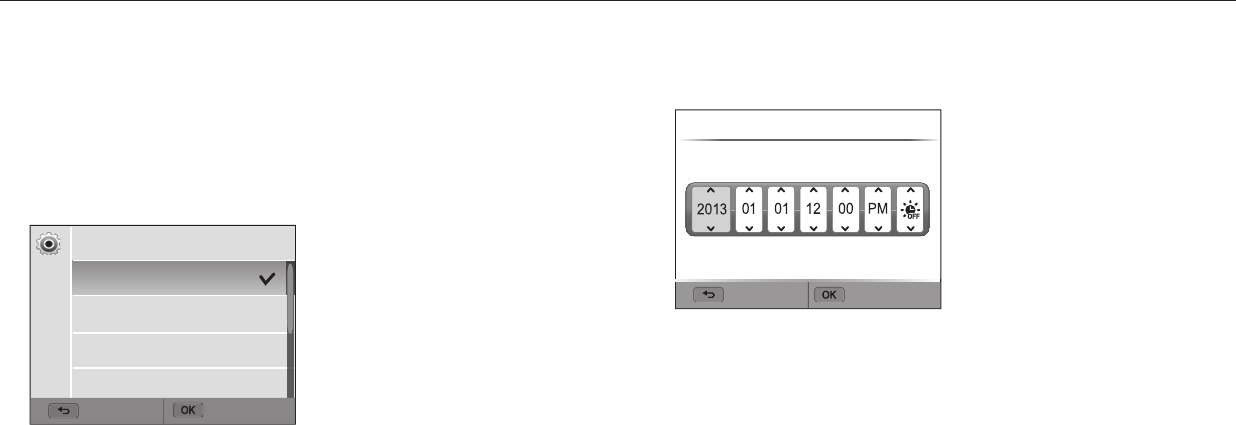
Basic functions
26
Performing the initial setup
When you turn on your camera for the rst time, the initial setup screen appears. Follow the steps below to congure the camera’s basic settings. The language is preset for the
country or region where the camera is sold. You can change the language as desired. You can also select an item by touching it on the screen.
5 Press [
c
] to select Date/Time Set, and then press [
t
] or [
o
].
Cancel Set
Date/Time Set
Year Month Day Hr Min DST
The screen may dier depending on the language selected.
6 Press [
F
/
t
] to select an item.
7 Press [
D
/
c
] to set the date, time, and daylight-saving time, and
then press [
o
].
1 Press [
c
] to select Time Zone, and then press [
t
] or [
o
].
2 Press [
D
/
c
] to select Home, and then press [
o
].
When you travel to another country, select Visit, and then select a new time
zone.
3 Press [
D
/
c
] to select a time zone, and then press [
o
].
Time Zone
Back Set
[GMT +00:00] London
[GMT +01:00] Berlin, Paris, Rome
[GMT +02:00] Athens, Helsinki
[GMT +03:00] Moscow
4 Press [
b
].

Performing the initial setup
Basic functions
27
8 Press [
c
] to select Date Type, and then press [
t
] or [
o
].
9 Press [
D
/
c
] to select a date type, and then press [
o
].
10
Press [
c
] to select Time Type, and then press [
t
] or [
o
].
11
Press [
D
/
c
] to select a time type, and then press [
o
].
12
Press [
b
] to nish the initial setup.
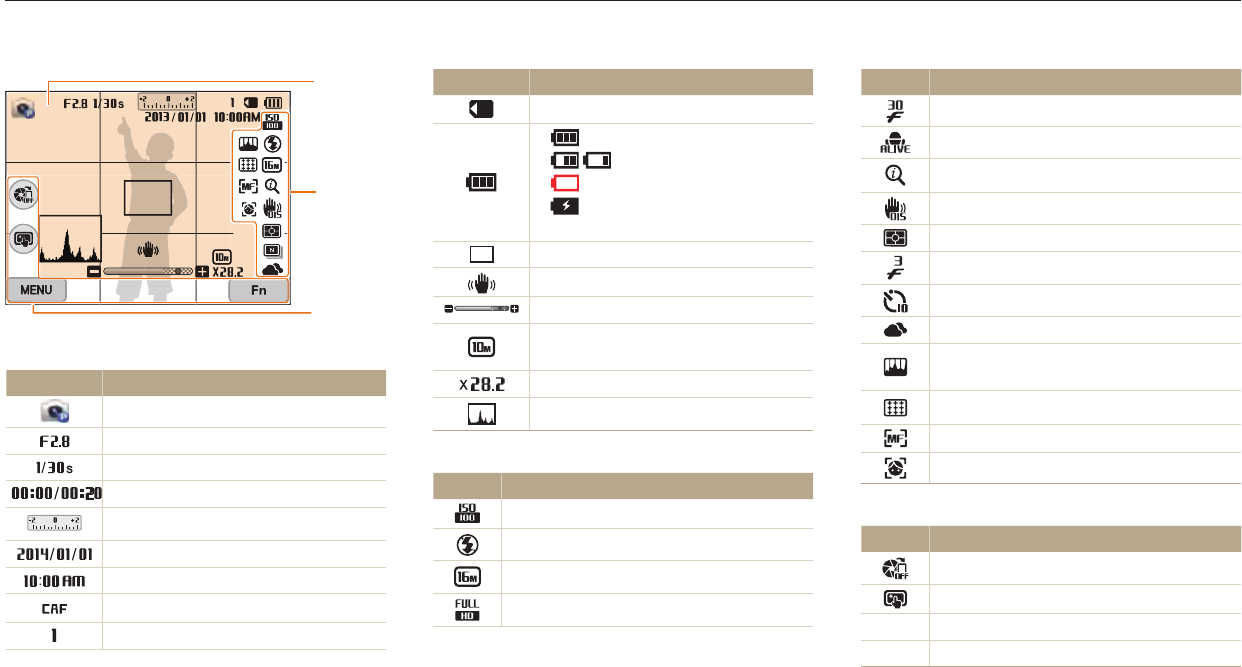
Basic functions
28
Learning icons
The icons the camera displays on the screen change according to the mode you select or the options you set. If you change a shooting option, the corresponding icon will blink
briey in yellow.
1
2
3
Icon Description
Frame rate (per second)
Sound Alive on
Intelli zoom on
Optical Image Stabilization (OIS)
Metering
Burst option
Timer
White balance
Image adjustment (sharpness, contrast,
and saturation)
Focus area
Focus option
Face detection
3
Shooting option (touch)
Icon Description
AutoShare On
Touch AF option
m
Shooting options
f
Open Smart Panel
Icon Description
Memory card inserted
: Fully charged
: Partially charged
: Empty (Recharge)
: Charging (Connected with the
charger)
Auto focus frame
Camera shake
Zoom indicator
Photo resolution when the
Intelli zoom is on
Zoom ratio
Histogram (p. 35)
2
Shooting option
Icon Description
ISO sensitivity
Flash
Photo resolution
Video resolution
1
Shooting information
Icon Description
Shooting mode
Aperture value
Shutter speed
Available recording time
Exposure value
Current date
Current time
Continuous auto focus activated
Available number of photos
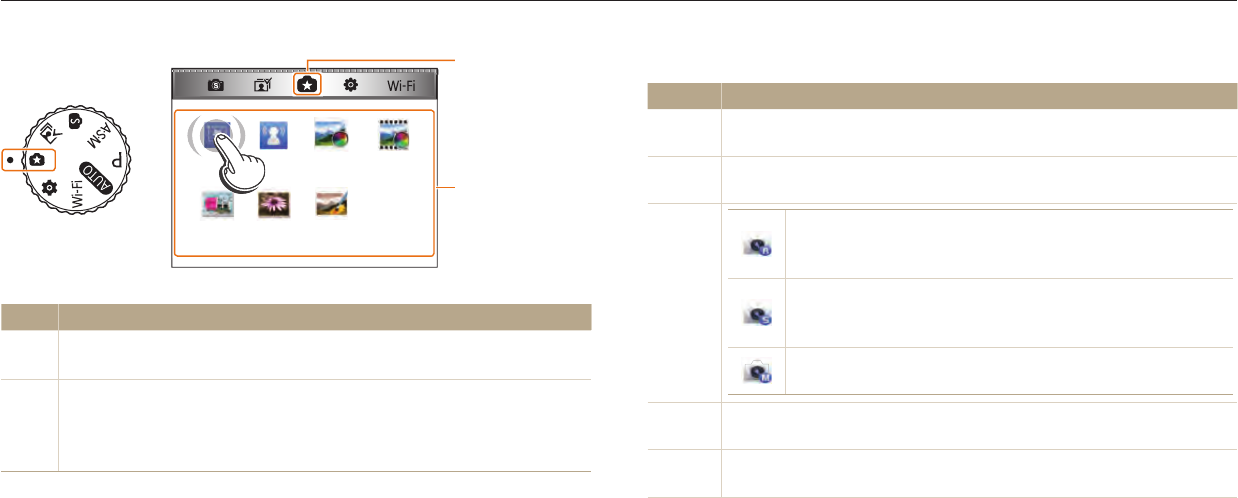
Basic functions
29
Selecting modes
Use the mode dial to select a shooting mode or function. Rotate the mode dial to a desired mode. You can also select an icon on the Mode screen in some modes.
Icons on the Mode screen
Icon Description
T
Smart Auto: Capture a photo with a Scene mode selected
automatically by the camera. (p. 44)
p
Program: Capture a photo with settings you have adjusted manually.
(p. 46)
G
Aperture Priority: Set the aperture value manually while the
camera automatically selects an appropriate shutter speed.
(p. 48)
Shutter Priority: Set the shutter speed manually while the
camera automatically selects an appropriate aperture value.
(p. 49)
Manual: Adjust both the aperture value and the shutter
speed manually. (p. 50)
s
Smart: Capture a photo with options that are preset for a specic
scene. (p. 51)
i
Best Face: Capture multiple photos and replace faces to create the best
possible image. (p. 54)
My Magic
Frame
Photo
Filter
Split Shot
Movie
Filter
Photo
Editor
Motion
Photo
2
1
My
Ma
Fra
m
P
h
o
t
o
Fil
ter
Split Shot
Mov
ie
Fil
ter
P
ho
to
E
d
it
o
r
Mo
t
ion
P
h
o
to
My
My
Ÿ
For example: When you select My Magic Frame in Magic Plus mode
No. Description
1
Current Mode screen
Rotate the mode dial to go to another mode screen.
2
Mode icons
Press [
D
/
c
/
F
/
t
] to scroll to a desired mode, and then press [
o
]
to access the mode.
Touch an icon to access a mode or function.

Selecting modes
Basic functions
30
Icon Description
w
MobileLink: Send photos or videos to a smart phone. (p. 116)
Remote Viewnder: Use a smart phone as a remote shutter
release and see a preview on your smart phone of an image
from your camera. (p. 117)
Baby Monitoring
Auto Backup: Send photos or videos that you captured with
the camera to a PC wirelessly. (p. 119)
Email: Send photos or videos stored on the camera via email.
(p. 121)
SNS & Cloud: Upload photos or videos to le sharing
websites. (p. 124)
Samsung Link: Upload photos to AllShare Play online storage
or view les on other AllShare Play supported devices. (p. 126)
Icon Description
g
My Magic Frame: Capture a photo and select an area to
make it transparent. Overlay a newly captured photo onto the
area. (p. 55)
Motion Photo: Capture and combine a series of photos, and
then select an area to be animated to create a GIF animation.
(p. 57)
Photo Filter: Capture a photo with various lter eects.
(p. 58)
Movie Filter: Record a video with various lter eects. (p. 59)
Eect Artist
Color Brush
Photo Editor: Edit photos with various eects. (p. 96)
n
Settings: Adjust settings to match your preferences. (p. 129)
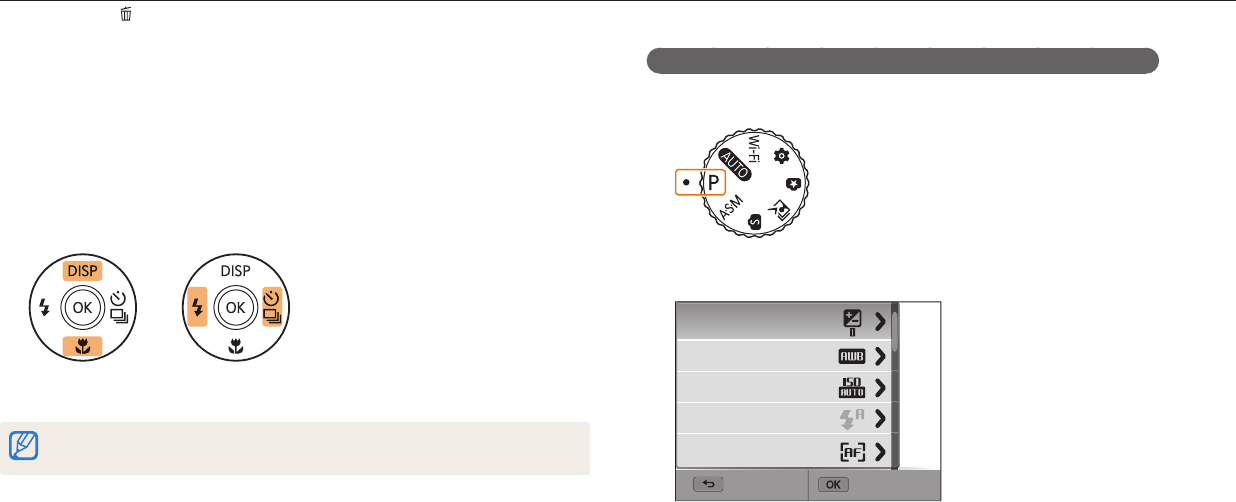
Basic functions
31
Selecting options or menus
Press [
m
] or [ /
f
] to select an option or a menu. You can also touch the screen to select an option or a menu.
For example, to select a White Balance option in Program mode:
1 Rotate the mode dial to
p
.
2 Press [
m
].
Exit Select
EV
White Balance
ISO
Flash
Focus
Selecting with buttons
Press [
m
], and then press [
D
/
c
/
F
/
t
] or [
o
] to select an option or a
menu.
1 In Shooting or Playback mode, press [
m
].
2 Scroll to an option or a menu.
To move up or down, press [
D
] or [
c
].
To move left or right, press [
F
] or [
t
].
3 Press [
o
] to conrm the highlighted option or menu.
Press [
b
] to go back to the previous menu. Half-press [Shutter] to return to
Shooting mode.
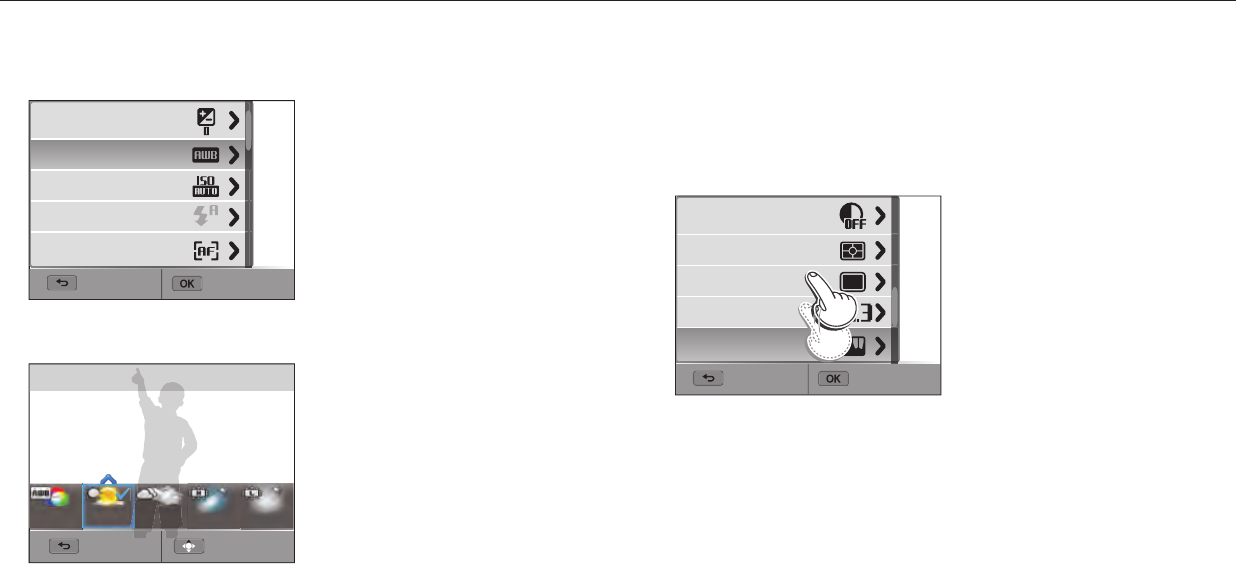
Selecting options or menus
Basic functions
32
3 Press [
D
/
c
] to select White Balance, and then press [
t
] or
[
o
].
EV
White Balance
ISO
Flash
Focus
Exit Select
4 Press [
F
/
t
] to select a White Balance option.
Back Adjust
White Balance : Daylight
5 Press [
o
] to save your settings.
Selecting by touch
Touch
m
on the screen, drag the option list up or down, and then touch an
option to select it.
1 In Shooting or Playback mode, touch
m
on the screen.
2 Drag the option list up or down, and then touch an option.
ACB
Metering
Drive/Timer
AE Bracket Set
Image Adjust
Exit Select
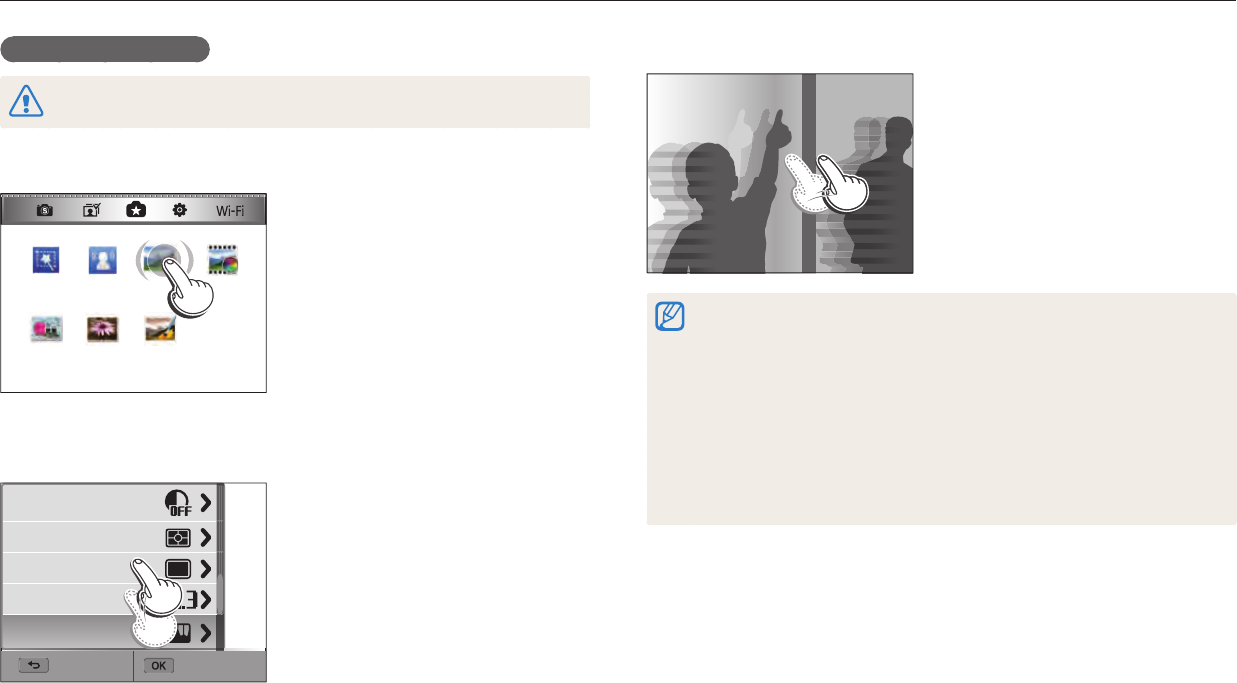
Selecting options or menus
Basic functions
33
Flicking: Gently ick your nger across the screen.
The touch screen may not recognize your inputs if you touch multiple items at
the same time.
When you touch or drag the screen, discolorations may occur. This is not a
malfunction, but a characteristic of the touch screen. Touch or drag lightly to
minimize the discolorations.
The touch screen may not work properly if you use the camera in extremely
humid environments.
The touch screen may not work properly if you apply screen protection lm or
other accessories to the screen.
Depending on the viewing angle, the screen may appear dim. Adjust the
brightness or viewing angle to improve the resolution.
Learning touch gestures
Do not use sharp objects, such as pens or pencils, to touch the screen. You can
damage the screen.
Touching: Touch an icon to select a menu or option.
My Magic
Frame
Photo
Filter
Split Shot
Movie
Filter
Photo
Editor
Motion
Photo
M
n
n
Mo
Dragging: Touch and hold an area on the screen, and then drag your
nger.
ACB
Metering
Drive/Timer
AE Bracket Set
Image Adjust
Exit Select
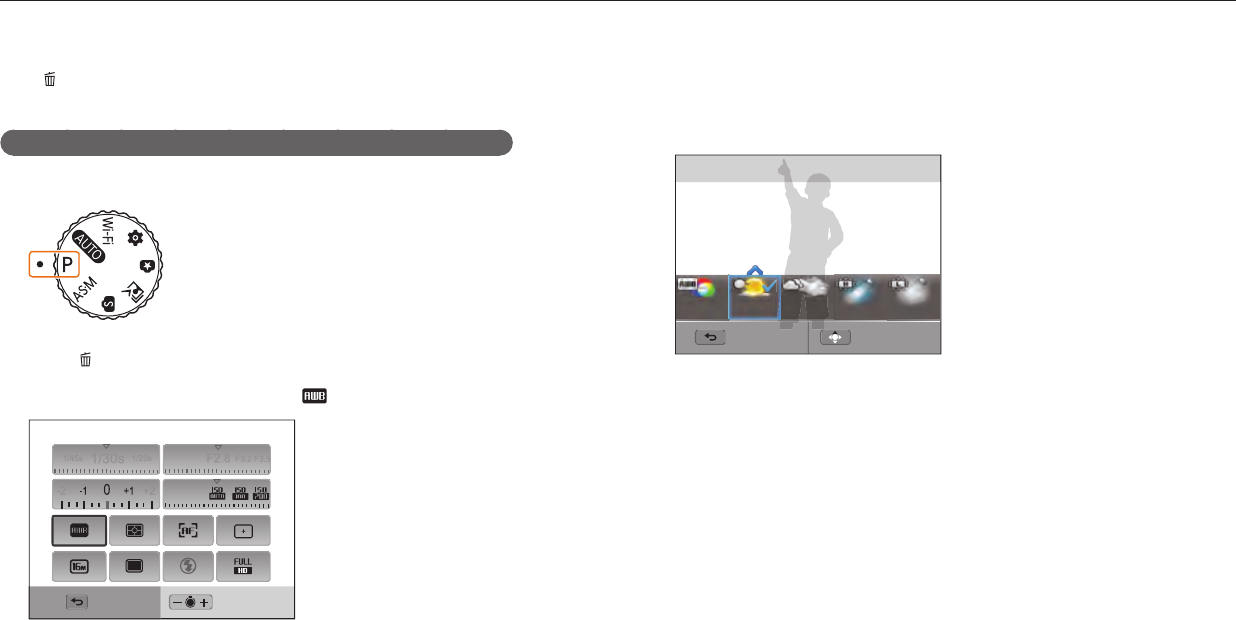
Selecting options or menus
Basic functions
34
Using Smart Panel
Press [ /
f
] or touch
f
on the screen to select an option or a menu. Some options
are not available depending on the menu you select.
For example, to select a White Balance option in Program mode:
1 Rotate the mode dial to
p
.
2 Press [ /
f
] or touch
f
on the screen.
3 Press [
D
/
c
/
F
/
t
] to scroll to .
White Balance : Auto WB
Exit Adjust
4 Press [
o
].
For some items, you can directly select an option by rotating [Zoom] to the
left or right without having to press [
o
].
5 Press [
F
/
t
] to select a White Balance option.
White Balance : Daylight
Back Adjust
6 Press [
o
] to save your settings.
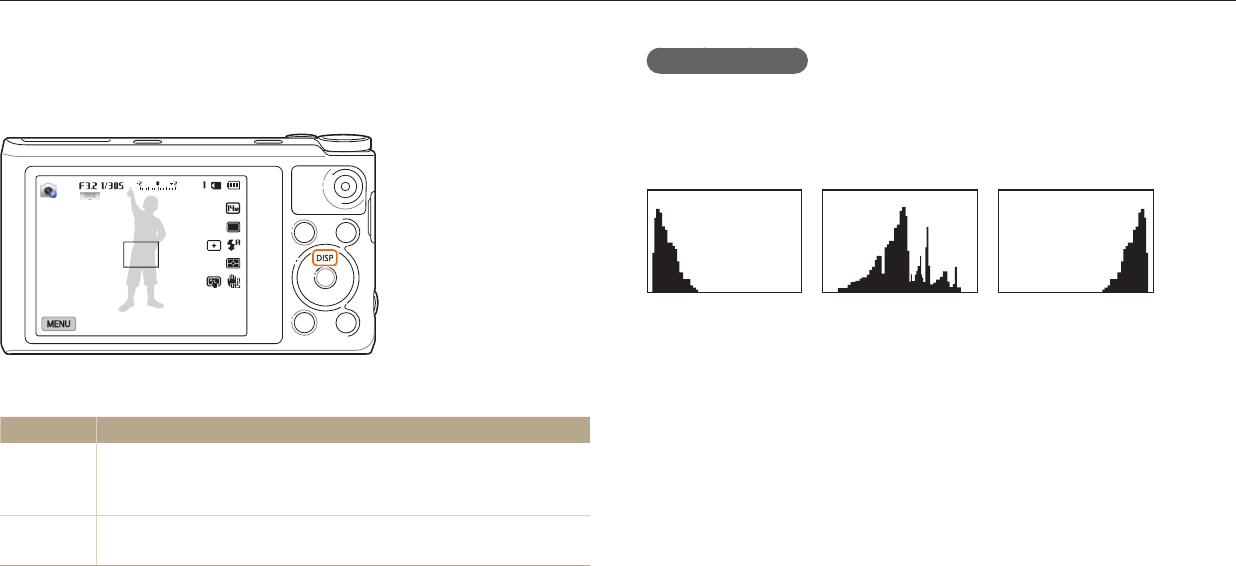
Basic functions
35
Setting the display type
You can select a display type for the Shooting or Playback mode. Each type displays
dierent shooting or playback information. See the table below.
Press [
D
] repeatedly to change the display type.
Mode Display type
Shooting
Hide all information about shooting options.
Show all information about shooting options.
Show all information about shooting options and a histogram.
Playback
Show information except shooting information and histogram.
Show all information about the current le.
About histograms
A histogram is a graph that illustrates how light is distributed in your photo. If the
histogram has a high peak on the left, the photo is underexposed and will appear
dark. A peak on the right of the graph means that the photo is overexposed and
will appear washed out. The height of the peaks is related to color information. The
more of a particular color, the taller the peak.
S
Under-exposed
S
Well-exposed
S
Over-exposed
Setting the display and sound
Learn how to change the basic display information and sound settings.

Setting the display and sound
Basic functions
36
Setting the option display view
You can hide or show the option display appearing in some modes.
Press [
o
] repeatedly.
Hide the option display.
Show the option display.
Option display
OK: Panel O
▲ For example, in Photo Filter mode
Setting the sound
Turn on or o the sound your camera emits when you perform functions.
1 Rotate the mode dial to
n
.
2 Select Sound → Beep Sound.
3 Select an option.
Option Description
O The camera does not emit any sounds.
On The camera emits sounds.
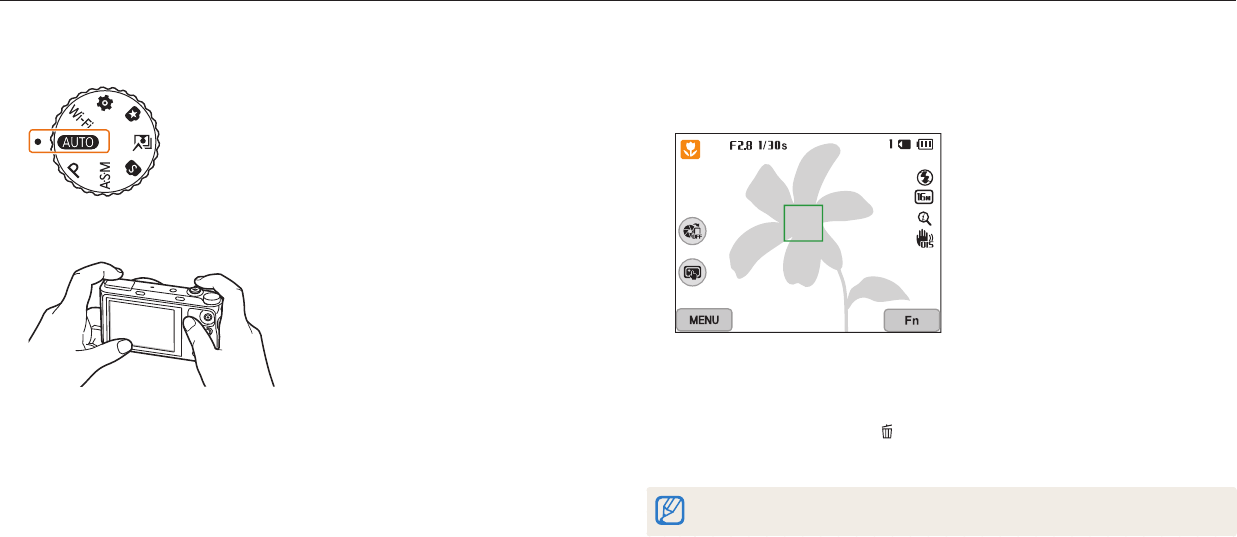
Basic functions
37
1 Rotate the mode dial to
T
.
2 Align your subject in the frame.
3 Half-press [Shutter] to focus.
A green frame means the subject is in focus.
A red frame means the subject is out of focus.
4 Press [Shutter] to capture a photo.
5 Press [
P
] to view the captured photo.
To delete the photo, press [ /
f
], and then select Ye s.
6 Press [
P
] to return to Shooting mode.
See page 41 for tips to get clearer photos.
Capturing photos
Learn how to capture photos easily and quickly in Smart Auto mode.
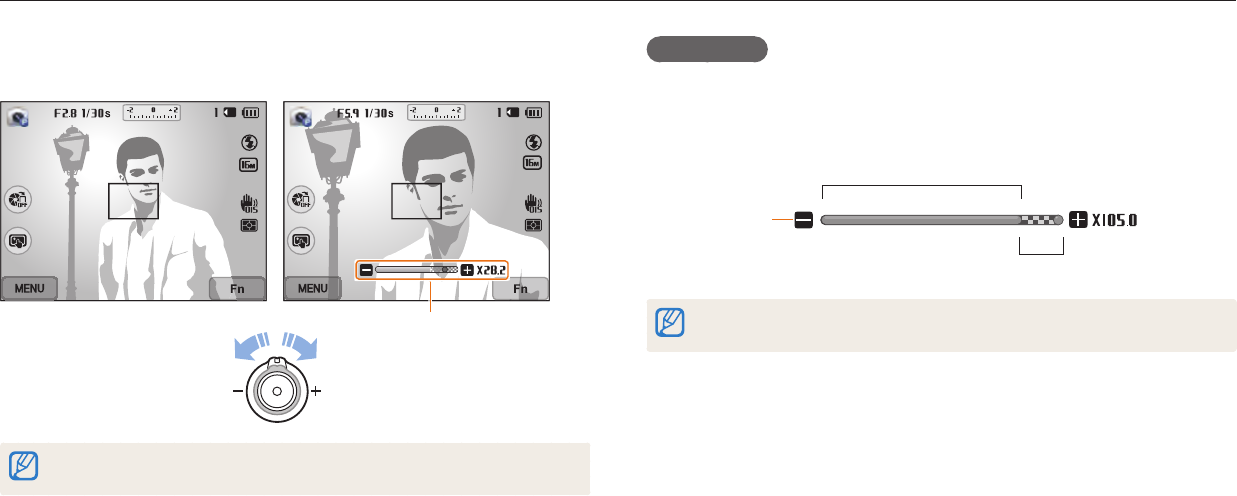
Capturing photos
Basic functions
38
Zooming
You can capture close-up photos by adjusting the zoom.
Zoom out Zoom in
Zoom ratio
When you rotate the zoom button, the zoom ratio shown on the screen may
change inconsistently.
Digital zoom
The Digital zoom is supported by default in Shooting mode. If you zoom in on
a subject in Shooting mode and the zoom indicator is in the digital range, your
camera is using the Digital zoom. By using both the 21X Optical zoom and 5X
Digital zoom, you can zoom in up to 105 times.
Zoom indicator
Optical range
Digital range
If you capture a photo with the Digital zoom, the photo quality may be lower than
normal.
pAhM

Capturing photos
Basic functions
39
Intelli zoom
If the zoom indicator is in the Intelli range, your camera is using the Intelli zoom.
Photo resolution varies according to the zoom rate if you use the Intelli zoom. By
using both the Optical zoom and Intelli zoom, you can zoom in up to 42 times.
Zoom indicator
Optical range
Intelli range
Photo resolution
when the Intelli
zoom is on
The Intelli zoom helps you capture a photo with less quality deterioration than
the Digital zoom. However, the photo quality may be lower than when you use
the Optical zoom.
The Intelli zoom is available only when you set a 4:3 resolution ratio. If you set
another resolution ratio with Intelli zoom on, the Intelli zoom will be turned o
automatically.
The Intelli zoom is always on in Smart Auto mode.
TpAhM
Setting Intelli zoom
1 In Shooting mode, press [
m
].
2 Select Intelli Zoom.
3 Select an option.
Icon Description
O: The Intelli zoom is deactivated.
On: The Intelli zoom is activated.

Capturing photos
Basic functions
40
Reducing camera shake (OIS)
Reduce camera shake optically in Shooting mode.
S
Before correction
S
After correction
1 In Shooting mode, press [
m
].
2 Select OIS.
3 Select an option.
Icon Description
O: OIS is deactivated.
On: OIS is activated.
pAhM
OIS may not function properly when:
-
you move your camera to follow a moving subject
-
you use the Digital zoom
-
there is too much camera shake
-
the shutter speed is slow (for example, when you capture night scenes)
-
the battery is low
-
you capture a close-up shot
If you use the OIS function with a tripod, your images may be blurred by the
vibration of the OIS sensor. Deactivate the OIS function when you use a tripod.
If the camera is hit or dropped, the display will be blurry. If this occurs, turn o
the camera, and then turn it on again.
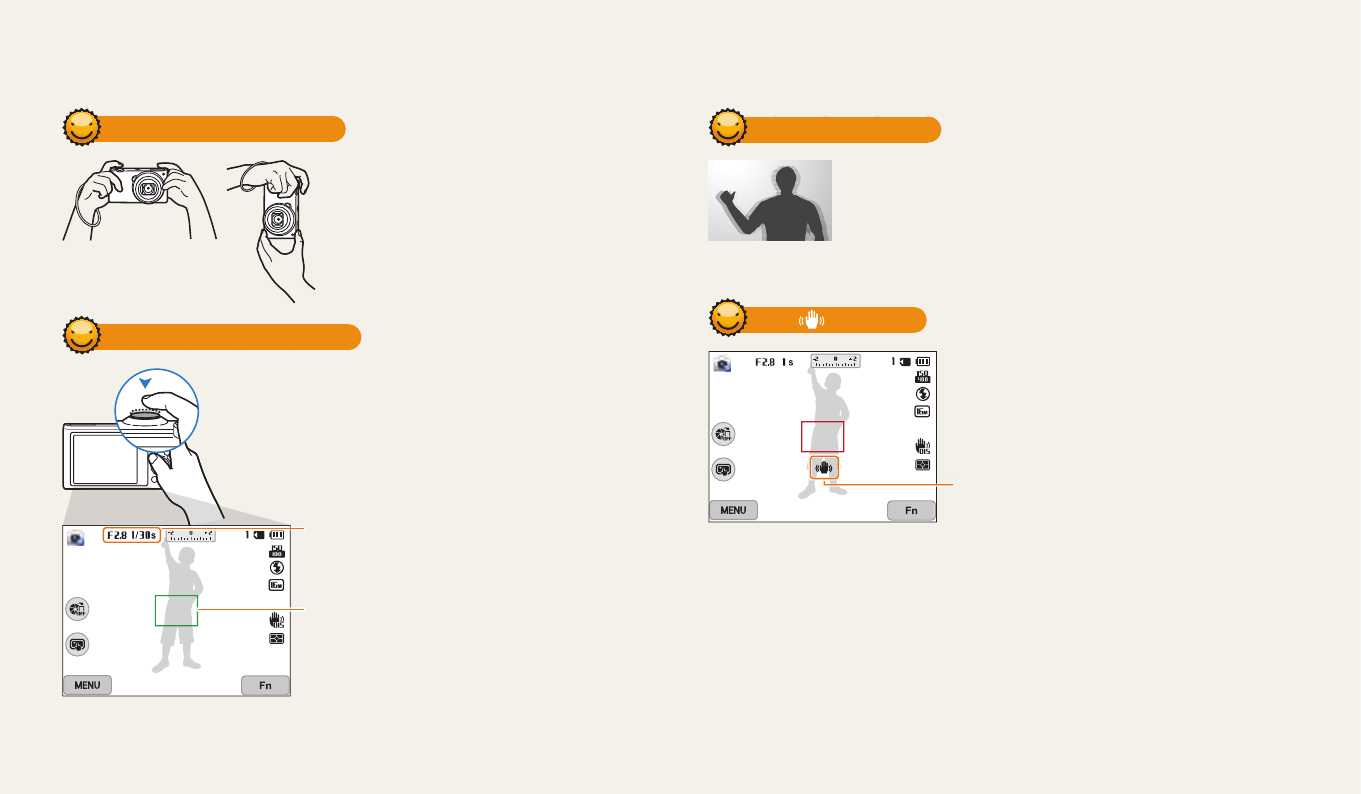
Basic functions
41
Holding your camera correctly
Ensure nothing is blocking the lens,
ash, or microphone.
Half-pressing the shutter button
Half-press [Shutter] and adjust the focus. The camera
adjusts the focus and exposure automatically.
The camera sets the aperture value and shutter
speed automatically.
Focus frame
Press [Shutter] to capture the photo if the
focus frame appears in green.
Change the composition and half-press
[Shutter] again if the focus frame appears in
red.
Reducing camera shake
Set the Optical Image Stabilization option to reduce camera
shake optically. (p. 40)
When is displayed
Camera shake
When you shoot in the dark, avoid setting the ash option to Slow Sync or O.
The aperture remains open longer and it may be harder to hold the camera steady
long enough to capture a clear photo.
Use a tripod or set the ash option to Fill in. (p. 67)
Set ISO sensitivity options. (p. 69)
Tips for getting a clearer photo
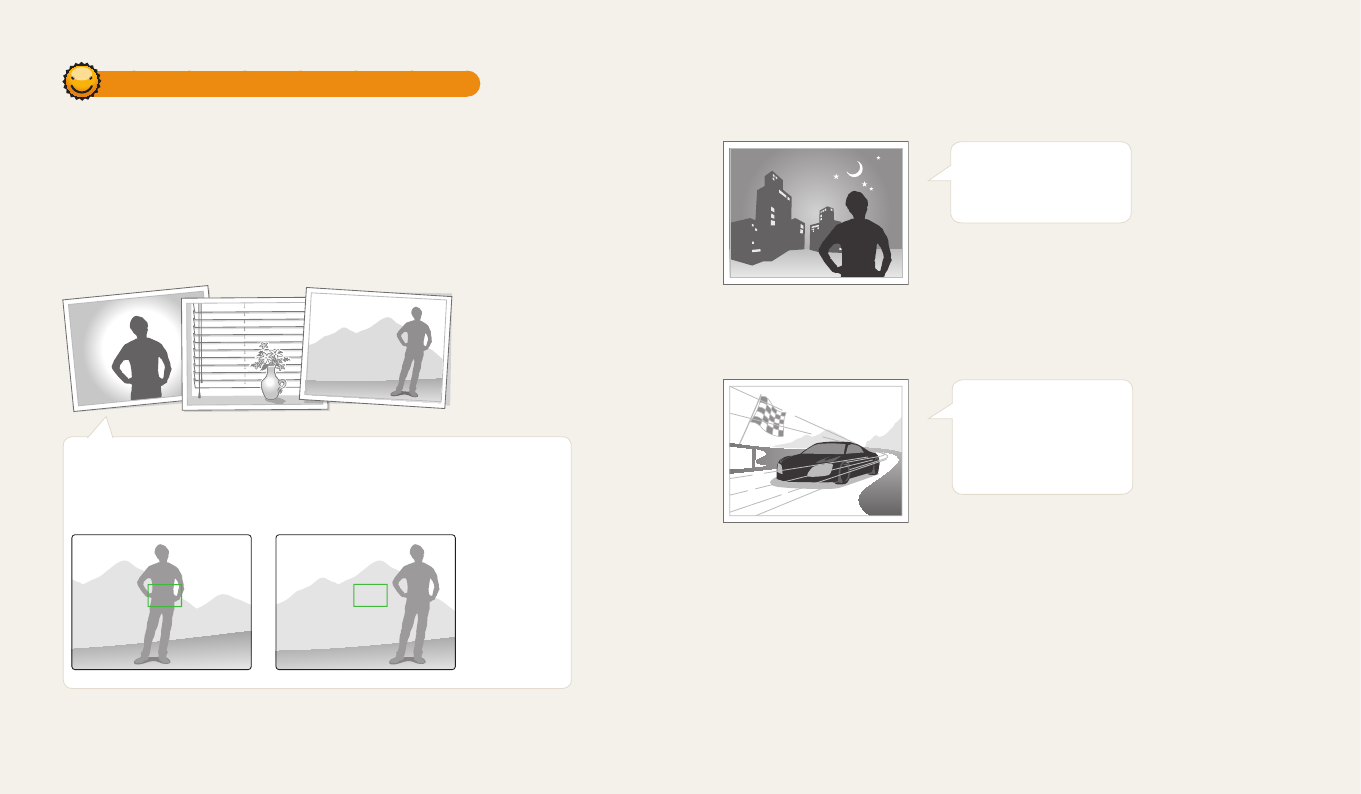
Basic functions
42
Preventing your subject from being out of focus
It may be dicult to get your subject in focus when:
-
there is little contrast between the subject and background (for example,
when your subject is wearing clothing that is similar in color to the
background)
-
the light source behind the subject is too bright
-
the subject is shiny or reective
-
the subject includes horizontal patterns, such as blinds
-
the subject is not positioned in the center of the frame
When you capture photos in low light
Turn on the ash.
(p. 67)
When subjects are moving rapidly
Use the Continuous
shooting function.
(p. 82)
Using the focus lock
Half-press [Shutter] to focus. When the subject is in focus, you can
reposition the frame to change the composition. When you are ready,
press [Shutter] to capture your photo.

Using the Smart Auto mode
…………………… 44
Using the Program mode
……………………… 46
Using the Aperture Priority, Shutter Priority, or
Manual mode
…………………………………… 47
Using the Aperture Priority mode
……………… 48
Using the Shutter Priority mode
……………… 49
Using the Manual mode
……………………… 50
Using the Smart mode
………………………… 51
Using the Panorama mode
…………………… 52
Using the Best Face mode
……………………… 54
Using the Magic Plus mode
…………………… 55
Using the My Magic Frame mode
……………… 55
Using the Motion Photo mode
………………… 57
Using the Photo Filter mode
…………………… 58
Using the Movie Filter mode
…………………… 59
Recording a video
……………………………… 60
Recording a video with the Smart Scene
Detection function
…………………………… 61
Extended functions
Learn how to capture a photo and record a video by selecting a mode.
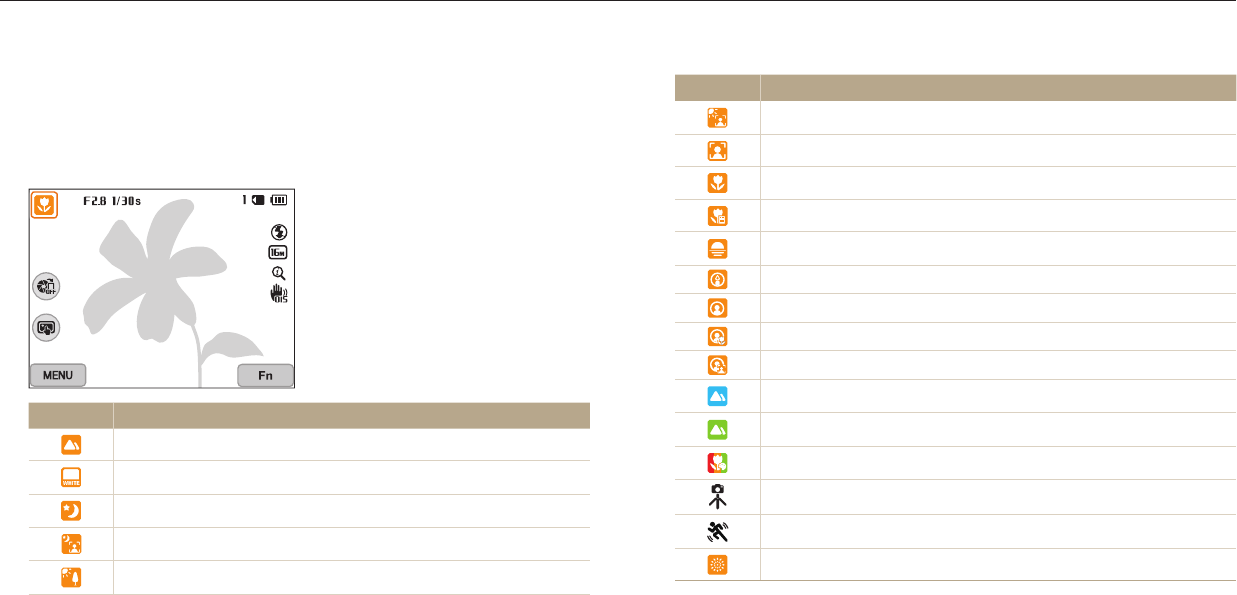
Extended functions
44
1 Rotate the mode dial to
T
.
2 Align your subject in the frame.
The camera automatically selects a scene. An appropriate scene icon appears
at the top left of the screen. The icons are listed below.
Icon Description
Landscapes
Scenes with bright white backgrounds
Landscapes at night
Portraits at night
Landscapes with backlighting
Icon Description
Portraits with backlighting
Portraits
Close-up photos of objects
Close-up photos of text
Sunsets
Indoors, dark
Partially lit
Close-up with spot lighting
Portraits with spot lighting
Blue skies
Forested areas
Close-up photos of colorful subjects
Camera is stabilized or on a tripod (when shooting in the dark)
Actively moving subjects
Fireworks (when using a tripod)
Using the Smart Auto mode
In Smart Auto mode, your camera automatically chooses the appropriate camera settings based on the type of scene it detects. The Smart Auto mode is helpful if you are not
familiar with the camera settings for various scenes.

Using the Smart Auto mode
Extended functions
45
3 Half-press [Shutter] to focus.
4 Press [Shutter] to capture the photo.
If the camera does not recognize an appropriate scene mode, it uses the default
settings for the Smart Auto mode.
Even if it detects a face, the camera may not select a portrait mode depending
on the subject's position or lighting.
The camera may not select the correct scene depending on the shooting
conditions, such as camera shake, lighting, or distance to the subject.
Even if you use a tripod, the camera may not detect the mode if the subject
is moving.
The camera consumes more battery power, because it changes settings often to
select appropriate scenes.

Extended functions
46
Using the Program mode
In Program mode, you can set most options, except the shutter speed and aperture value, which the camera sets automatically.
1 Rotate the mode dial to
p
.
2 Set the desired options.
For a list of options, refer to "Shooting options". (p. 63)
3 Align your subject in the frame, and then half-press [Shutter] to
focus.
4 Press [Shutter] to capture the photo.
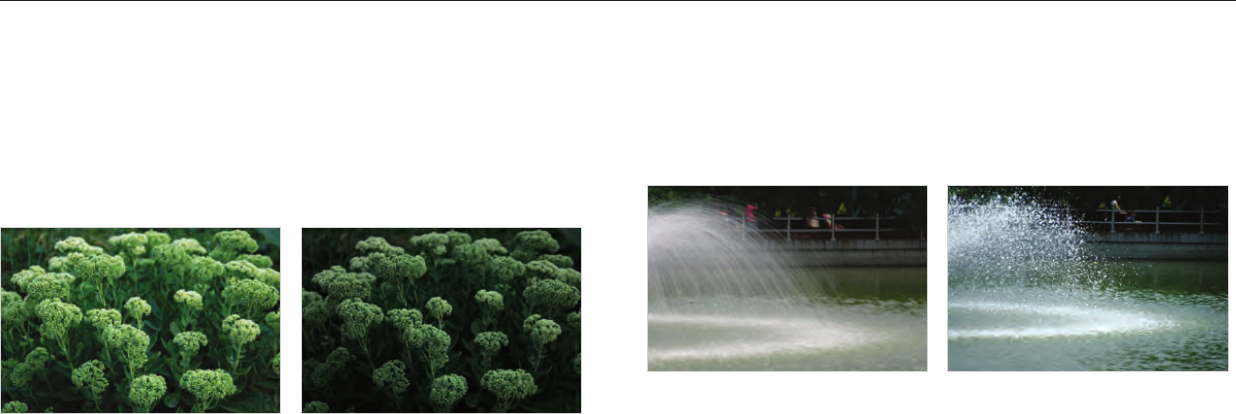
Extended functions
47
Aperture value
The aperture is a hole that lets light into the camera. The aperture housing contains
thin, metal plates that open and close, widening or narrowing the aperture, and
controlling the amount of light that enters the camera. The size of the aperture is
closely related to the brightness of a photo: the larger the aperture, the brighter
the photo; the smaller the aperture, the darker the photo. Note that the larger the
aperture value, the smaller the aperture size. For example, an aperture set to 5.6 is
larger than an aperture set to 11.
S
Small aperture value (The size of the
aperture is large.)
S
Large aperture value (The size of the
aperture is small.)
Shutter speed
Shutter speed, which is an important factor in the brightness of a photo, refers to
the amount of time it takes to open and close the shutter. A slow shutter speed
allows more time to let light in. All things being equal, photos are brighter, but fast
moving objects tend to blur. On the other hand, a fast shutter speed allows less time
to let light in. Photos are darker, but objects in motion are captured more clearly.
S
Slow shutter speed
S
Fast shutter speed
Using the Aperture Priority, Shutter Priority, or Manual mode
Adjust the aperture value or shutter speed to control the exposure of your photos. You can use these options in the Aperture Priority, Shutter Priority, and Manual modes.
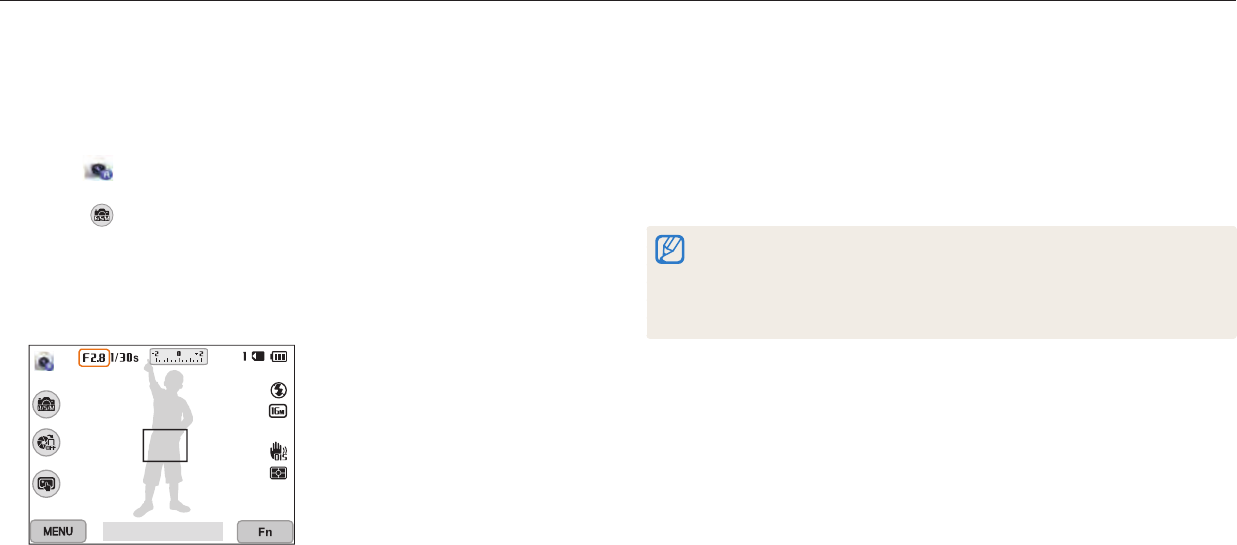
Using the Aperture Priority, Shutter Priority, or Manual mode
Extended functions
48
Using the Aperture Priority mode
The Aperture Priority mode allows you to set the aperture value manually while the
camera automatically selects an appropriate shutter speed.
1 Rotate the mode dial to
G
.
2 Select .
To select another mode when the mode dial is set to
G
, press [
b
] or
touch , and then select a mode.
3 Press [
o
] → [
F
/
t
] to adjust the aperture value.
You can also touch the aperture value on the screen to view the dial.
You can also drag the dial on the screen to the left or right.
See page 47 for more information about the aperture value.
OK: Change aperture
4 Press [
o
] to save the setting.
5 Set options.
For a list of options, refer to "Shooting options". (p. 63)
6 Align your subject in the frame, and then half-press [Shutter] to
focus.
7 Press [Shutter] to capture the photo.
When you set the ISO option to Auto, the shutter speed may not change
automatically to match the aperture value. In this case, the camera nds an
appropriate exposure value by changing the ISO option automatically when you
capture a photo. To set the ISO option manually, press [
m
], and then select ISO
→ an option.
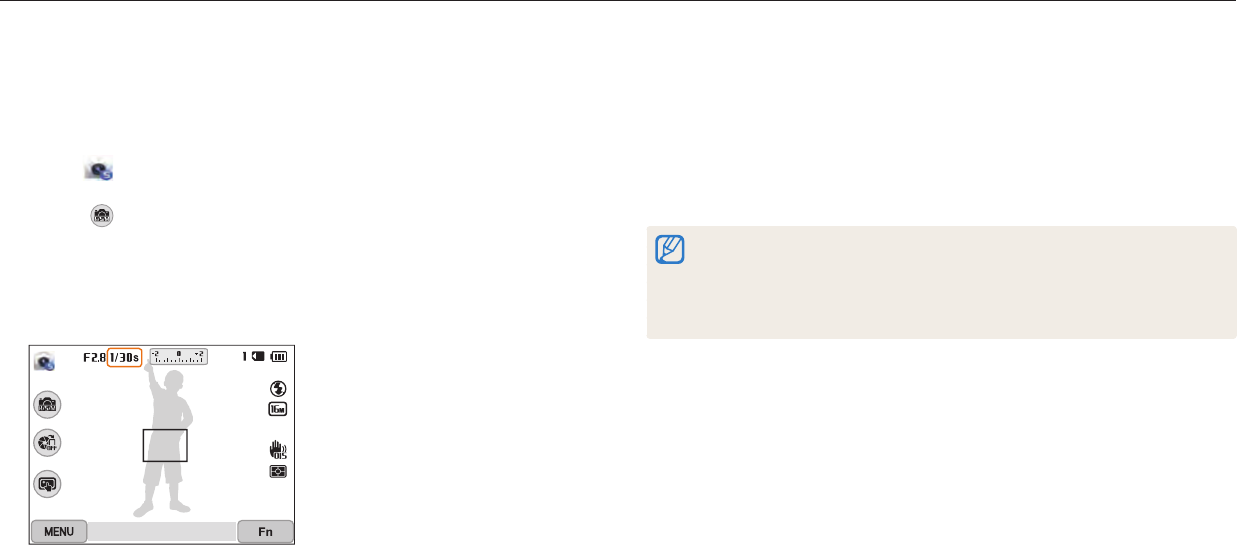
Using the Aperture Priority, Shutter Priority, or Manual mode
Extended functions
49
Using the Shutter Priority mode
The Shutter Priority mode allows you to set the shutter speed manually while the
camera automatically selects an appropriate aperture value.
1 Rotate the mode dial to
G
.
2 Select .
To select another mode when the mode dial is set to
G
, press [
b
] or
touch , and then select a mode.
3 Press [
o
] → [
F
/
t
] to adjust the shutter speed.
You can also touch the shutter speed on the screen to view the dial.
You can also drag the dial on the screen to the left or right.
See page 47 for more information about the shutter speed.
OK: Change shutter speed
4 Press [
o
] to save the setting.
5 Set options.
For a list of options, refer to "Shooting options". (p. 63)
6 Align your subject in the frame, and then half-press [Shutter] to
focus.
7 Press [Shutter] to capture the photo.
When you set the ISO option to Auto, the aperture value may not change
automatically to match the shutter speed. In this case, the camera nds an
appropriate exposure value by changing the ISO option automatically when you
capture a photo. To set the ISO option manually, press [
m
], and then select ISO
→ an option.
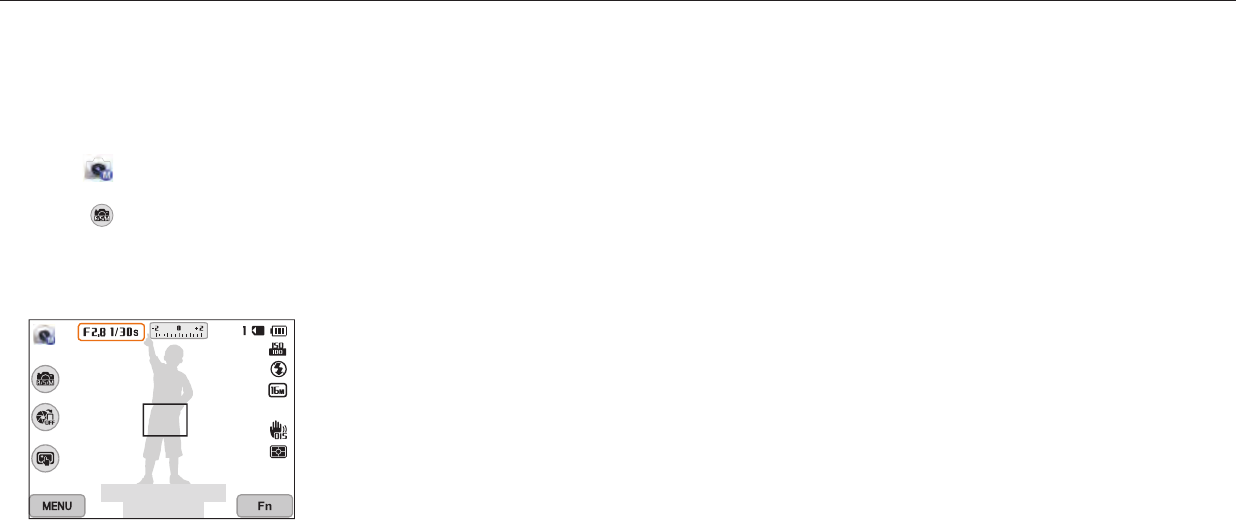
Using the Aperture Priority, Shutter Priority, or Manual mode
Extended functions
50
Using the Manual mode
The Manual mode allows you to adjust both the aperture value and the shutter
speed manually.
1 Rotate the mode dial to
G
.
2 Select .
To select another mode when the mode dial is set to
G
, press [
b
] or
touch , and then select a mode.
3 Press [
o
] → [
D
/
c
] to select the aperture value or shutter speed.
You can also touch the aperture value or shutter speed on the screen to view
the dial.
OK: Change aperture/
shutter speed
4 Press [
F
/
t
] to adjust the aperture value or shutter speed.
You can also drag the dials on the screen to the left or right.
5 Press [
o
] to save the setting.
6 Set options.
For a list of options, refer to "Shooting options". (p. 63)
7 Align your subject in the frame, and then half-press [Shutter] to
focus.
8 Press [Shutter] to capture the photo.

Extended functions
51
Using the Smart mode
In Smart mode, you can capture a photo with options that are preset for a specic scene.
Option Description
Panorama Capture a wide panoramic scene in a single photo.
Waterfall Capture scenes with waterfalls.
Silhouette Capture subjects as dark shapes against a light background.
Sunset Capture scenes at sunset, with natural-looking reds and
yellows.
Low Light
Shot
Capture multiple photos in low light conditions without a
ash. The camera combines them to create a single image
that is brighter and has less blurring.
Fireworks Capture scenes with reworks.
Light Trace Capture scenes with the light trailing in low-light conditions.
3 Align your subject in the frame, and then half-press [Shutter] to
focus.
4 Press [Shutter] to capture the photo.
1 Rotate the mode dial to
s
.
2 Select a scene.
To select another mode when the mode dial is set to
s
, press [
b
] or touch
, and then select a mode.
Smart : Beauty Face
Set
Option Description
Beauty Face Capture a portrait with options to hide facial imperfections.
Continuous
Shot Capture photos continuously.
Landscape Capture still-life scenes and landscapes.
Macro Capture small or close-up subjects.
Action Freeze Capture subjects moving at high speed.
Rich Tones Capture a photo with vibrant colors.

Using the Smart mode
Extended functions
52
5 With [Shutter] pressed, slowly move the camera in the direction that
will let it capture the rest of the panorama.
Arrows toward the direction of motion are displayed, and the entire shooting
image is displayed in the preview box.
When the scenes are aligned, the camera captures the next photo
automatically.
Shakiness
6 When you are nished, release [Shutter].
When you have captured all the necessary shots, the camera combines them
into one panoramic photo.
Using the Panorama mode
In Panorama mode, you can capture a wide panoramic scene in a single photo.
Capture and combine a series of photos to create a panoramic image.
S
Shooting example
1 Rotate the mode dial to
s
.
2 Select Panorama.
3 Align your subject in the frame, and then half-press [Shutter] to
focus.
Align the camera with the far left or the far right, or very top or bottom, of the
scene you want to capture.
4 Press and hold [Shutter] to start shooting.

Using the Smart mode
Extended functions
53
For best results when capturing panoramic photos, avoid the following:
-
moving the camera too quickly or too slowly
-
moving the camera too little to capture the next image
-
moving the camera at irregular speeds
-
shaking the camera
-
shooting in dark places
-
capturing moving subjects nearby
-
shooting conditions where the brightness or color of light is changing
Photos taken are automatically saved, and shooting is stopped under the
following conditions:
-
if you change the shooting direction while shooting
-
if you move the camera too rapidly
-
if you don't move the camera
Selecting Panorama mode will disable the digital and optical zoom functions.
If you select Panorama mode while the lens is zoomed in, the camera
automatically zooms out to the default position.
Some shooting options are not available.
The camera may stop shooting due to the shooting composition or movement
within the scene.
Your camera may not capture the last scene in its entirety if you stop moving the
camera exactly where you want the scene to end. To capture the entire scene,
move your camera slightly beyond the point where you want the scene to end.

Extended functions
54
Using the Best Face mode
In Best Face mode, you can capture multiple photos and replace faces to create the best possible image. Use this mode to select the best image for each individual when
capturing group photos.
5 Touch the best image from the 5 faces that were captured.
Repeat steps 4 and 5 to replace the rest faces of the photo.
The icon will appear on the image that the camera recommends.
6 Touch to save the photo.
Use a tripod to prevent your camera from shaking.
The resolution is set to or smaller.
1 Rotate the mode dial to
i
.
2 Align your subject in the frame, and then half-press [Shutter] to
focus.
3 Press [Shutter] to capture the photo.
The camera captures 5 photos consecutively.
The rst photo is set as the background image.
The camera automatically detects faces after shooting.
4 Touch a face to replace.
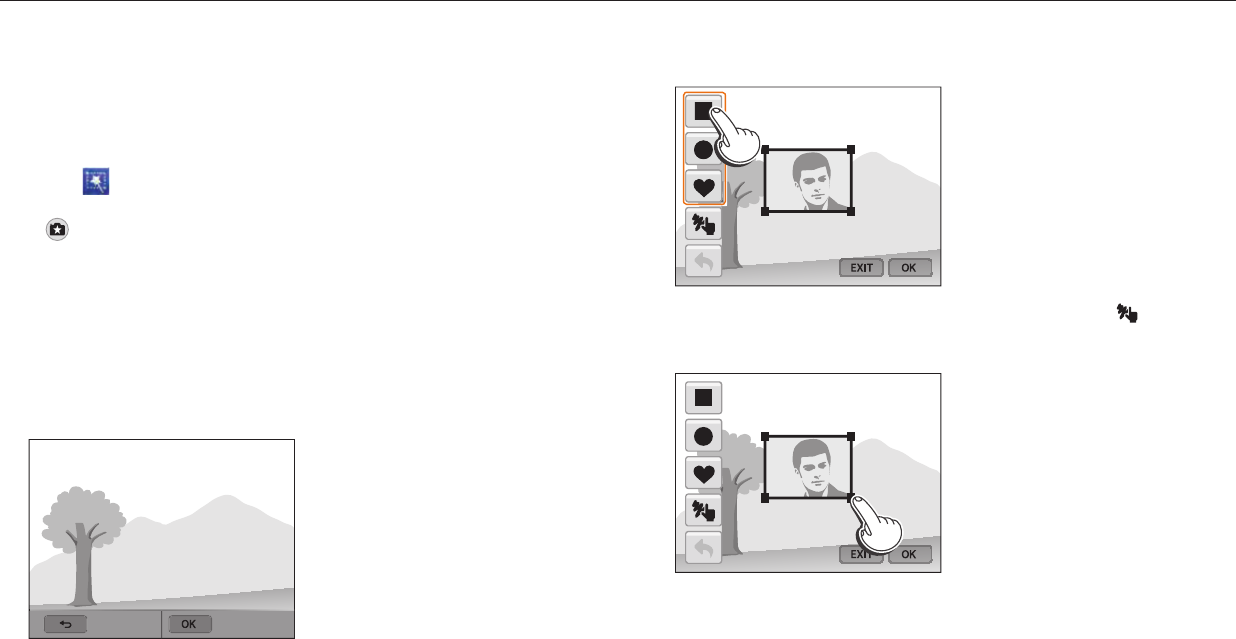
Extended functions
55
Using the My Magic Frame mode
In My Magic Frame mode, you can make part of the photo transparent, and then
capture a new photo within the transparent area.
1 Rotate the mode dial to
g
.
2 Select .
To select another mode when the mode dial is set to
g
, press [
b
] or touch
, and then select a mode.
3 Half-press [Shutter] to focus, and then press [Shutter] to capture a
background photo.
To select a background photo from your saved photos, press [
m
] and
then select Open Image → an image. You cannot select a video le, GIF le, or
a photo captured in Panorama mode.
4 Touch Use.
To recapture a background photo, touch Retake.
Retake Use
5 Select a frame.
To draw a new frame and set the thickness of the pen, touch .
6 Drag the corner of the box to adjust the size.
Using the Magic Plus mode
In the Magic Plus mode, you can capture a photo with various eects.
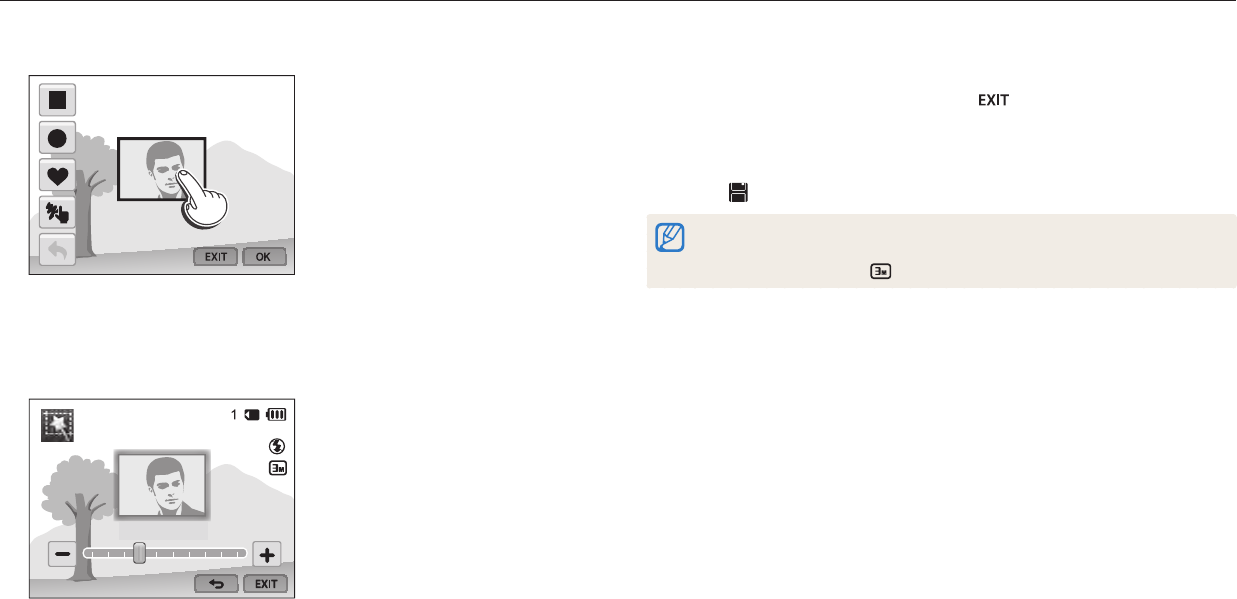
Using the Magic Plus mode
Extended functions
56
7 Drag the selected frame to place it to a desired location.
8 Press [
o
].
9 Adjust the transparency by moving the sliders or touching the +/-
icons to adjust.
Transparency
10
Align your subject in the frame, and then half-press [Shutter] to
focus.
To recapture a background photo, touch .
11
Press [Shutter] to capture a photo.
Press [
b
] to return to the previous screen.
12
Touch to save the photo.
Some shooting options are not available.
The focus is set to the transparent area in the frame.
The resolution is xed at .
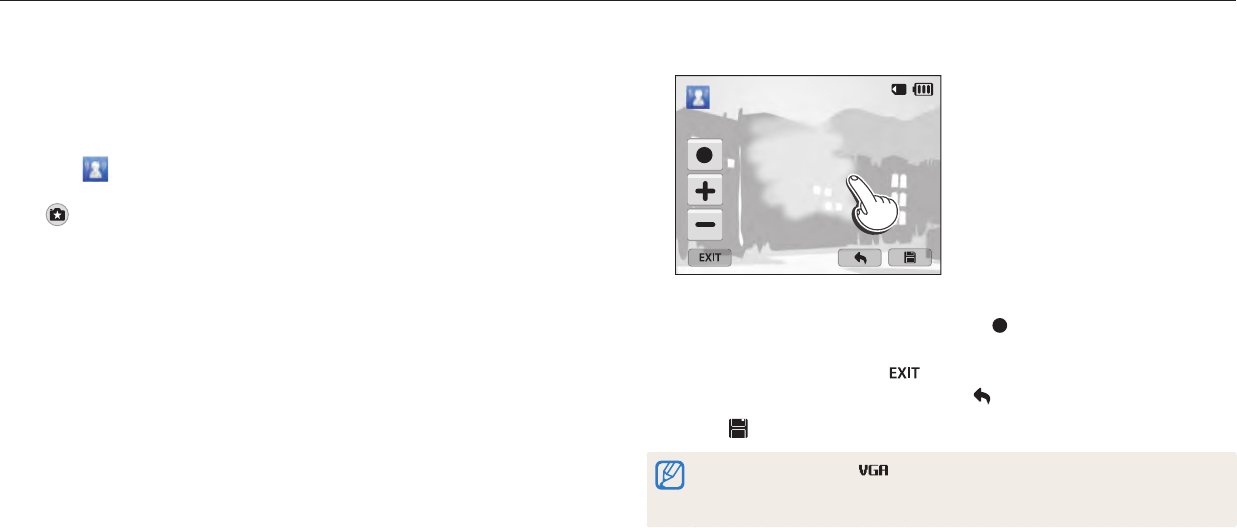
Using the Magic Plus mode
Extended functions
57
Using the Motion Photo mode
In Motion Photo mode, you can capture and combine a series of photos, and then
select an area to be animated to create a GIF animation.
1 Rotate the mode dial to
g
.
2 Select .
To select another mode when the mode dial is set to
g
, press [
b
] or touch
, and then select a mode.
3 Align your subject in the frame, and then half-press [Shutter] to
focus.
4 Press [Shutter] to capture the photo.
The camera captures multiple photos while the status lamp is blinking.
5 On the screen, draw an area to be animated.
You can select multiple areas.
To adjust the thickness of the brush, touch .
To adjust the motion speed, touch +/- icon.
To recapture a photo, touch .
To draw the animated area again, touch .
6 Touch to save the photo.
The resolution is set to .
Use a tripod to prevent your camera from shaking.
It may take longer to save les.

Using the Magic Plus mode
Extended functions
58
Using the Photo Filter mode
Apply various lter eects to your photos to create unique images.
Miniature Vignetting
Fish-eye Sketch
1 Rotate the mode dial to
g
.
2 Select .
To select another mode when the mode dial is set to
g
, press [
b
] or touch
, and then select a mode.
3 Select an eect.
Option Description
Miniature Apply a tilt-shift eect to make the subject appear in
miniature.
Vignetting Apply the retro-looking colors, high contrast, and strong
vignette eect of Lomo cameras.
Ink Painting Apply a watercolor painting eect.
Oil Painting Apply an oil painting eect.
Cartoon Apply a cartoon painting eect.
Cross Filter Add lines that radiate outward from bright objects to
imitate the visual eect of a cross lter.
Sketch Apply a pen sketch eect.
Soft Focus Hide facial imperfections or apply dreamy eects.
Fish-eye Blacken the edges of the frame and distort objects to
imitate the visual eect of a sheye lens.
Classic Apply a black and white eect.
Retro Apply a sepia tone eect.
Zooming Shot Blur the edges of a photo to emphasize the subjects in
the center.

Using the Magic Plus mode
Extended functions
59
4 Align your subject in the frame, and then half-press [Shutter] to
focus.
5 Press [Shutter] to capture a photo.
Depending on the option you select, the resolution may change to or smaller
automatically.
To apply lter eects to saved photos, press [
m
] and then select Open
Image → an image.
Using the Movie Filter mode
Apply various lter eects to your videos to create unique images.
1 Rotate the mode dial to
g
.
2 Select .
To select another mode when the mode dial is set to
g
, press [
b
] or touch
, and then select a mode.
3 Select an eect.
Option Description
Miniature Apply a tilt-shift eect to make the subject appear in
miniature.
Option Description
Vignetting Apply the retro-looking colors, high contrast, and strong
vignette eect of Lomo cameras.
Sketch Apply a pen sketch eect.
Fish-eye Distort close objects to imitate the visual eect of a
sheye lens.
Classic Apply a black and white eect.
Retro Apply a sepia tone eect.
Palette Eect 1 Create a vivid look with sharp contrast and strong color.
Palette Eect 2 Make scenes clean and clear.
Palette Eect 3 Apply a soft brown tone.
Palette Eect 4 Create a cold and monotone eect.
4 Press (Video recording) to start recording.
5 Press (Video recording) again to stop recording.
If you select Miniature, playback speed will increase.
If you select Miniature, you cannot record the sound in the video.
Depending on the option you select, the recording resolution may change to
or smaller automatically.
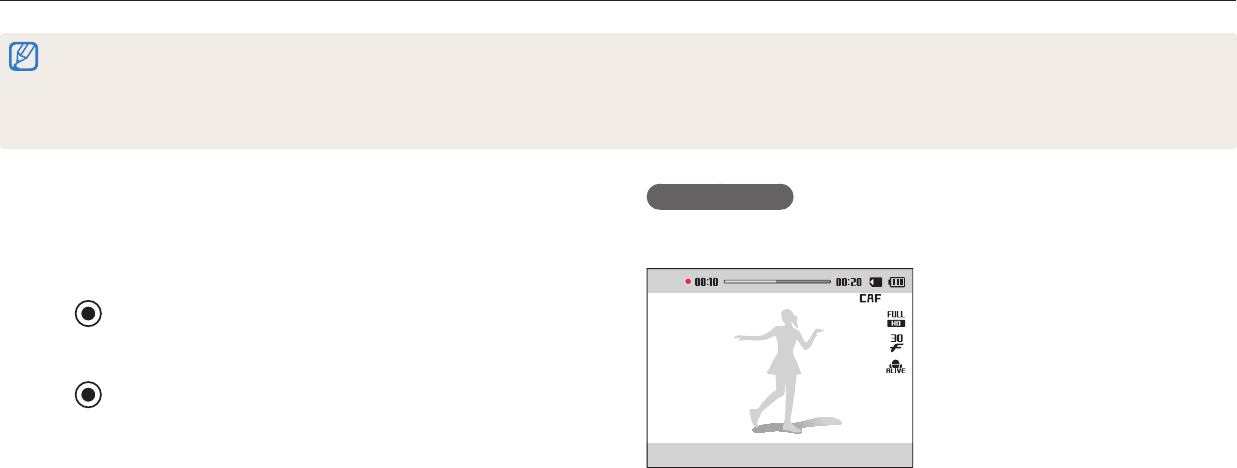
Extended functions
60
1 Rotate the mode dial to
p
,
G
,
s
,
i
,
g
or
T
.
This feature may not be supported in some modes.
2 Set desired options.
For a list of options, refer to "Shooting options". (p. 63)
3 Press (Video recording) to start recording.
While recording a video, press [
c
] once to cancel the continuous auto focus
function and once again to activate the function.
4 Press (Video recording) again to stop recording.
Pause recording
The camera allows you to temporarily pause a video while recording. With this
function, you can record separate scenes as a single video.
Press [
o
] to pause while recording.
Press [
o
] to resume.
Recording a video
Record Full HD videos (1920 X 1080) of up to 20 minutes. The camera saves recorded videos as MP4 (H.264) les.
H.264 (MPEG-4 part10/AVC) is a high-compression video format established by the international standards organizations ISO-IEC and ITU-T.
If you use memory cards with slow write speeds, the camera may not save videos properly. Video recordings may be corrupted or fail to play back correctly.
Memory cards with slow writing speeds will not support high-resolution videos. To record high-resolution videos, use memory cards with faster write speeds.
If you activate the Image Stabilization function while recording a video, the camera may record the operating sound of the Image Stabilization function.
If you use the zoom function when recording a video, the camera may record the noise of the zoom operating. To decrease zoom noise, use the Sound Alive function. (p. 85)
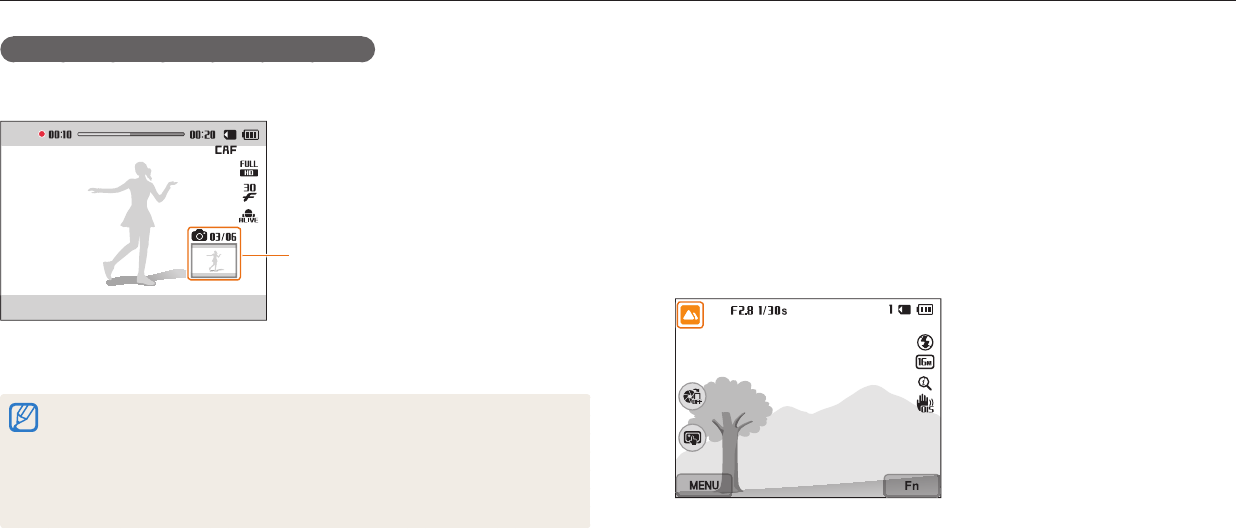
Recording a video
Extended functions
61
Capturing still images while recording a video
You can capture still images while recording a video without switching to the photo
shooting modes (up to 6 photos).
Images captured while recording a video
Press [Shutter] to capture images while recording a video.
Captured images will be saved automatically.
Captured images will be automatically resized, depending on the size of the
recorded video.
You cannot capture still images when you pause the video recording.
The quality of images captured while recording a video may be lower than those
captured normally.
This feature may not be supported in some modes.
Recording a video with the Smart Scene Detection function
In Smart Auto mode, your camera automatically chooses the appropriate camera
settings based on the scene it has detected.
1 Rotate the mode dial to
T
.
2 Set the desired options.
For a list of options, refer to "Shooting options". (p. 63)
3 Align your subject in the frame.
The camera automatically selects a scene. An appropriate scene icon will
appear at the top left of the screen.

Recording a video
Extended functions
62
Icon Description
Landscapes
Sunsets
Blue skies
Forested areas
4 Press (Video recording) to start recording.
5 Press (Video recording) again to stop recording.
If the camera does not recognize an appropriate scene mode, it uses the default
settings for the Smart Scene Detection mode.
The camera may not select the correct scene depending on the shooting
conditions, such as camera shake, lighting, and distance to the subject.

Selecting a resolution and quality
…………… 64
Selecting a resolution
………………………… 64
Selecting a photo quality
……………………… 65
Shooting in the dark
…………………………… 66
Preventing red-eye
…………………………… 66
Using the ash
………………………………… 66
Setting a ash option
…………………………… 67
Adjusting the ISO sensitivity
…………………… 69
Changing the camera’s focus
…………………… 70
Using macro
…………………………………… 70
Using auto focus
……………………………… 70
Adjusting the focus area
……………………… 72
Adjusting the focus by touch
………………… 72
Using Face Detection
…………………………… 75
Detecting faces
………………………………… 75
Capturing a self portrait shot
………………… 75
Capturing a smile shot
………………………… 76
Tips for detecting faces
………………………… 76
Adjusting brightness and color
………………… 77
Adjusting the exposure manually (EV)
………… 77
Compensating for backlighting (ACB)
………… 78
Changing the metering option
………………… 78
Selecting a White Balance setting
……………… 79
Using burst modes
……………………………… 82
Capturing continuous photos
………………… 82
Using the timer
………………………………… 83
Capturing bracketed photos
…………………… 83
Adjusting images
………………………………… 84
Reducing the sound of the zoom
……………… 85
Shooting options
Learn how to set the options in Shooting mode.

Shooting options
64
Selecting a resolution and quality
Learn how to change the image resolution and quality settings.
Setting the video resolution
1 In Shooting mode, press [
m
].
2 Select Movie Size.
3 Select an option.
Icon Description
1920 X 1080: High-quality HD les to play back on an HDTV.
1280 X 720: HD les to play back on an HDTV.
640 X 480: SD les to play back on an analog TV.
For Sharing: Post on a website using the wireless network
(30 seconds maximum).
Selecting a resolution
As you increase the resolution, your photo or video will include more pixels, so it
can be printed on larger paper or displayed on a larger screen. When you use a high
resolution, the le size will also increase.
Setting the photo resolution
1 In Shooting mode, press [
m
].
2 Select Photo Size.
3 Select an option.
Icon Description
4608 X 3456: Print on A1 paper.
4608 X 3072: Print on A1 paper in wide ratio (3:2).
4608 X 2592: Print on A1 paper in panorama ratio (16:9) or play
back on an HDTV.
3648 X 2736: Print on A2 paper.
2832 X 2832: Print on A3 paper in 1:1 ratio.
2592 X 1944: Print on A4 paper.
1984 X 1488: Print on A5 paper.
1920 X 1080: Print on A5 paper in panorama ratio (16:9) or play
back on an HDTV.
1024 X 768: Attach to an email.
TpAhMsig

Selecting a resolution and quality
Shooting options
65
Selecting a photo quality
Set a photo quality settings. Higher image quality settings will result in larger le
sizes. The camera compresses and saves the photos you capture in the JPEG format.
1 In Shooting mode, press [
m
].
2 Select Quality.
3 Select an option.
Icon Description
Super Fine: Capture photos in super high quality.
Fine: Capture photos in high quality.
Normal: Capture photos in normal quality.
pAhMig
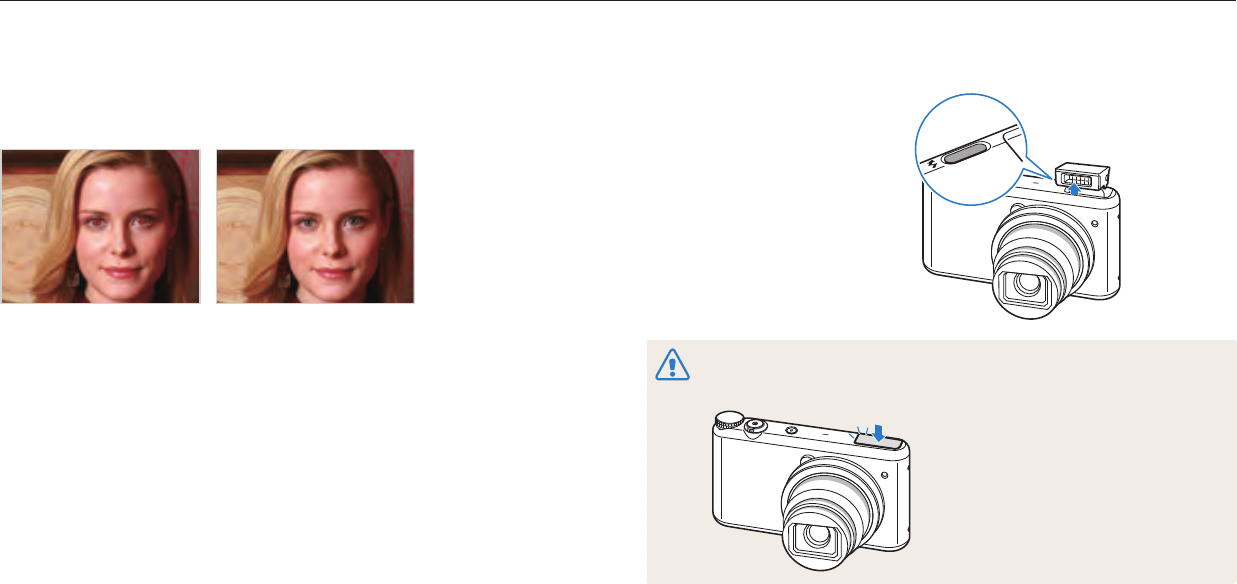
Shooting options
66
Shooting in the dark
Learn how to capture photos at night or in low light conditions.
Using the ash
Press the ash pop-up button to
pop the ash up. When the ash
unit pops up, the ash res in
accordance with the option you
have selected. If you select O, the
ash does not re even when it is
popped up.
While not in use, keep the ash unit closed to prevent damage.
Forcing to open the ash unit may cause damage to your camera. Press down
gently to close it.
Preventing red-eye
When the ash res when you capture a photo of a person in the dark, a red glow
may appear in the person’s eyes. To prevent this, select Red-eye or Red-eye Fix.
Refer to ash options in “Setting a ash option.”
S
Before correction
S
After correction
ps
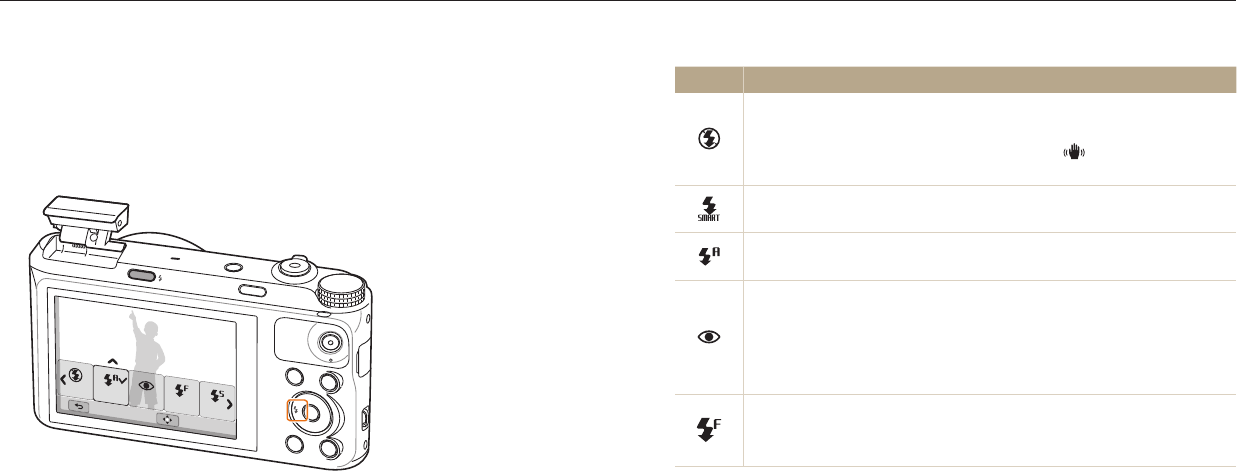
Shooting in the dark
Shooting options
67
Setting a ash option
Use the ash when you capture photos in the dark or when you need more light in
your photos.
1 Press the ash pop-up button to open the ash.
2 In Shooting mode, press [
F
].
TpAhMsg
3 Select an option.
Icon Description
O:
The ash will not re.
The camera will display the shake warning when you are
shooting in low light.
Auto: The camera will select a proper ash setting for the scene it
detects in Smart Auto mode.
Auto: The ash will re automatically when the subject or
background is dark.
Red-eye:
The ash will re twice when the subject or background is dark to
reduce the red-eye eect.
There is an interval between the 2 bursts of the ash. Do not move
until the ash res a second time.
Fill in:
The ash always res.
The camera automatically adjusts light intensity.
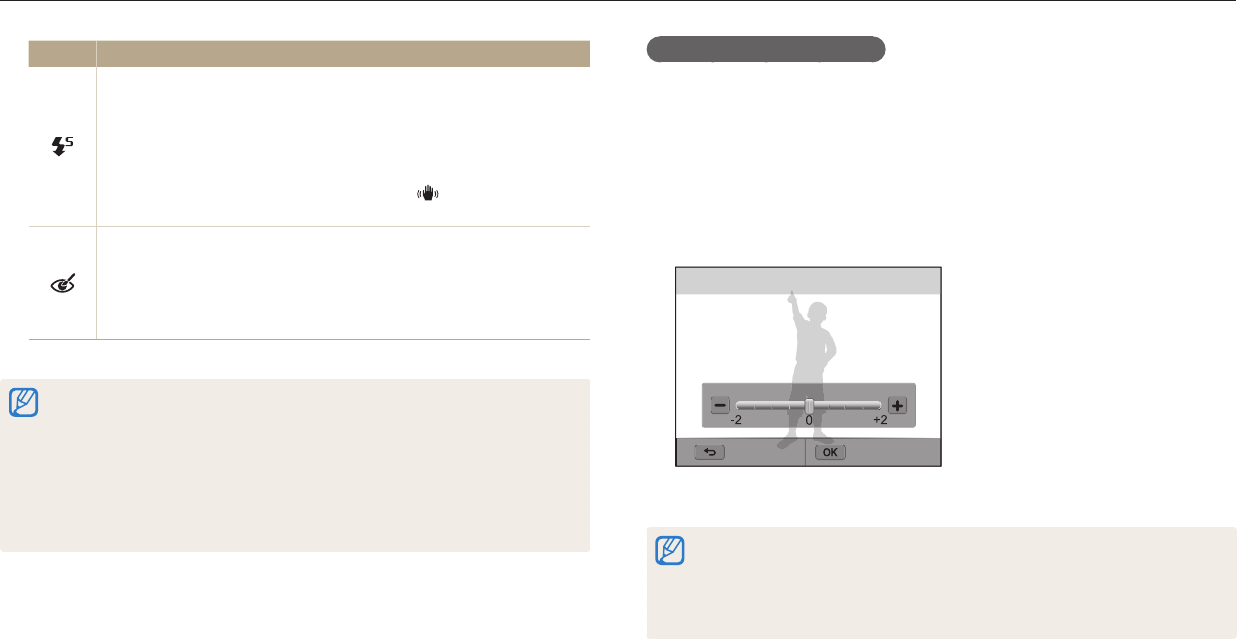
Shooting in the dark
Shooting options
68
Icon Description
Slow Sync:
The ash res and the shutter stays open longer.
This option is recommended when you want to capture more
ambient light to reveal more details in the background.
Use a tripod to prevent your photos from blurring.
The camera will display the shake warning when you are
shooting in low light.
Red-eye Fix:
The ash res twice when the subject or background is dark. The
camera corrects red-eyes through its advanced software analysis.
There is an interval between the 2 bursts of the ash. Do not move
until the ash res a second time.
Available options may dier depending on the shooting conditions.
Flash options are not available if you set Burst options or select Blink Detection,
Self-Portrait.
Make sure that your subjects are within the recommended distance from the
ash. (p. 151)
If light from the ash is reected or there is a substantial amount of dust in the
air, tiny spots may appear in your photo.
In some modes, you can also set the ash option by pressing [
m
], and then
selecting Flash.
Adjusting the ash intensity
Adjust the ash intensity to avoid over-exposed or under-exposed photos.
1 In Shooting mode, press [
F
].
2 Scroll to an option.
3 Press [
D
].
4 Press [
F
/
t
] to adjust the intensity.
You can also drag the slider or touch +/- to adjust the intensity.
Auto : 0
Back Set
5 Press [
o
] to save your settings.
Adjusting the ash intensity may not be eective if:
-
the subject is too close to the camera
-
you set a high ISO sensitivity
-
the exposure value is too big or too small
In some shooting modes, you cannot use this function.

Shooting in the dark
Shooting options
69
Adjusting the ISO sensitivity
The ISO sensitivity is the measure of a lm’s sensitivity to light as dened by the
International Organization for Standardization (ISO). The higher ISO sensitivity you
select, the more sensitive to light your camera becomes. Use a higher ISO sensitivity
to capture better photos and reduce camera shake when not using the ash.
1 In Shooting mode, press [
m
].
2 Select ISO.
3 Select an option.
Select to use an appropriate ISO sensitivity based on the brightness of
the subject and lighting.
Higher ISO sensitivities may result in more image noise.
pAhM
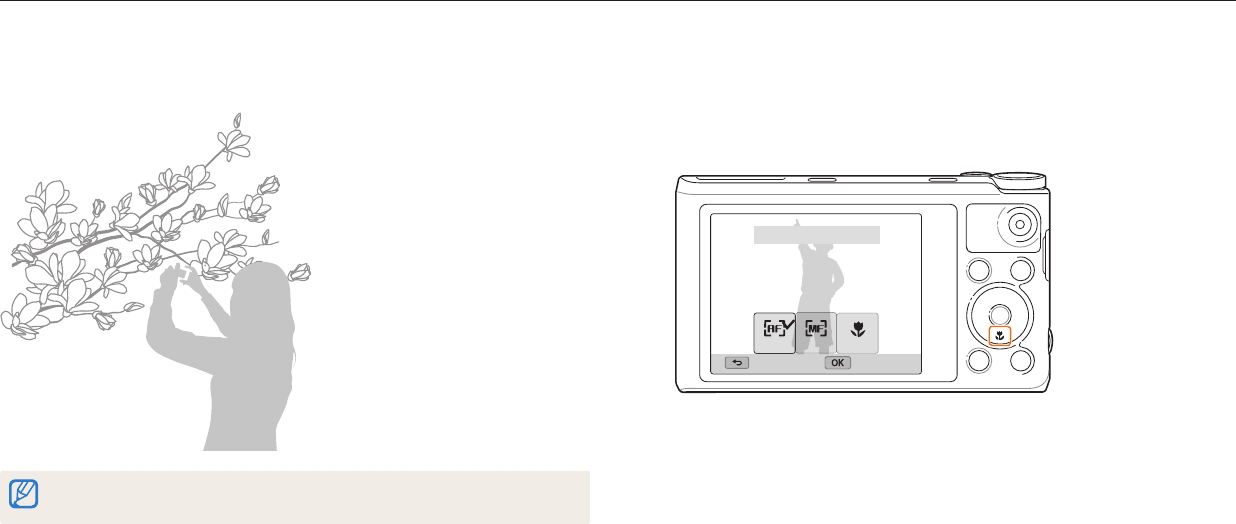
Shooting options
70
Using macro
Use macro to capture close-up photos of subjects, such as owers or insects.
Try to hold the camera rmly to prevent blurry photos.
Turn o the ash if the distance to the subject is less than 15.7 in. (40 cm).
pAhMg
Using auto focus
To capture sharp photos, select the appropriate focus option according to your
distance from the subject.
1 In Shooting mode, press [
c
].
Focus : Normal (AF)
Exit Set
TpAhMsg
Changing the camera’s focus
Learn how to adjust the camera’s focus to suit the subject and the shooting conditions.
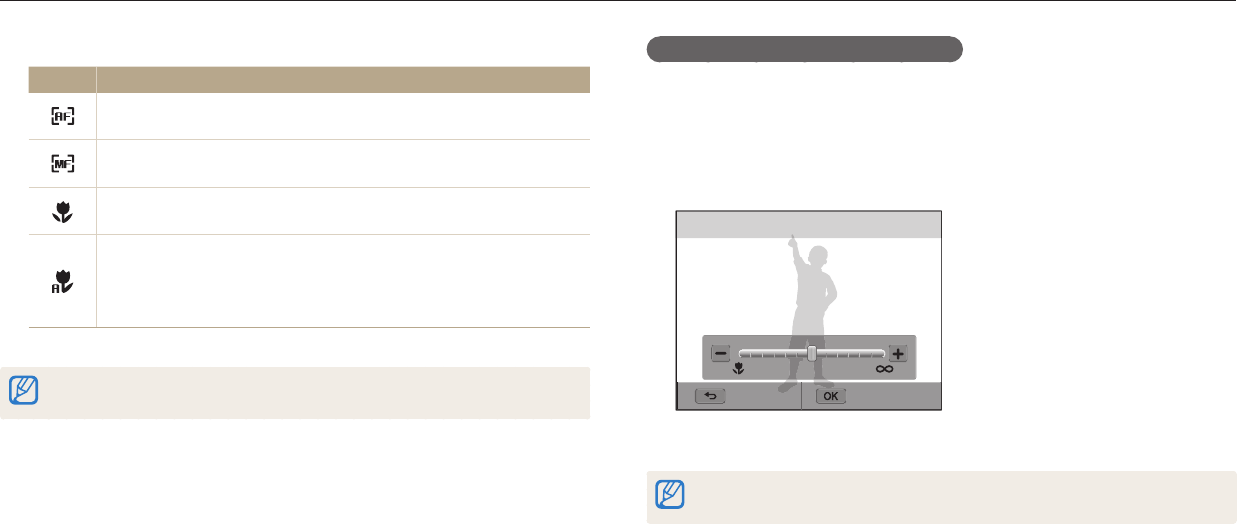
Changing the camera’s focus
Shooting options
71
Adjusting the focus distance manually
1 In Shooting mode, press [
c
].
2 Select Manual Focus.
3 Press [
F
/
t
] to adjust the focus distance.
You can also drag the slider or touch +/- to adjust the focus distance.
Back Set
Manual Focus : 50
4 Press [
o
] to save your settings.
When you adjust the focus distance manually and the subject is out of focus, the
photo may be blurry.
pAhM
2 Select an option.
Icon Description
Normal (AF): Focus on a subject farther than 31 in. (80 cm) away.
Farther than 138 in. (350 cm) away when you use the zoom.
Manual Focus: Focus on a subject by adjusting the focus distance
manually. (p. 71)
Macro: Focus on a subject that is 4-31 in. (10–80 cm) from the
camera. 59-138 in. (150–350 cm) when you use the zoom.
Auto Macro:
Focus on a subject farther than 4 in. (10 cm) away. Farther than
59 in. (150 cm) away when you use the zoom.
Auto Macro is set automatically in some shooting modes.
Available options may dier depending on the shooting conditions.
In some modes, you can also set the focus option by pressing [
m
], and then
selecting Focus.

Changing the camera’s focus
Shooting options
72
Adjusting the focus area
You can get clearer photos by selecting an appropriate focus area according to your
subject's location in the scene.
1 In Shooting mode, press [
m
].
2 Select Focus Area.
3 Select an option.
Icon Description
Center AF: Focus on the center of the frame (suitable when subjects
are located at or near the center).
Multi AF: Focus on one or more of 9 possible areas.
Available shooting options may dier depending on the shooting mode.
pAhM
Adjusting the focus by touch
Focus on the subject or capture a photo by touching on the screen.
1 In Shooting mode, press [
m
].
2 Select Touch AF.
3 Select an option.
Icon Description
O: Do not use the touch AF function.
Touch AF: Focus on the subject that you touch on the screen.
Tracking AF: Focus on and track the subject that you touch on the
screen. (p. 73)
One touch shot: Focus on the subject and capture a photo by
touching the image on the screen. (p. 74)
Available shooting options may dier depending on the shooting conditions.
The focus will reset when you perform no operations for 5 seconds or press
[Shutter] while the touch AF function is on.
TpAhMs
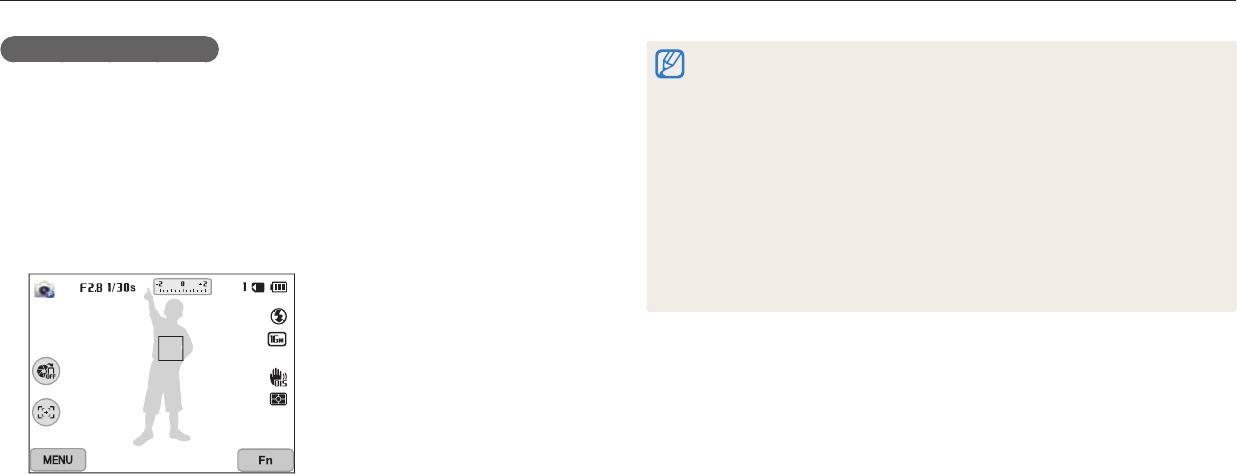
Changing the camera’s focus
Shooting options
73
If you do not select a focus area, the focus frame will appear in the center of the
screen.
Tracking a subject may fail when:
-
the subject is too small
-
the subject moves excessively
-
the subject is backlit or you are shooting in a dark place
-
colors or patterns on the subject and the background are the same
-
the subject includes horizontal patterns, such as blinds
-
the camera shakes excessively
When tracking fails, the feature will be reset.
If the camera fails to track the subject, you must reselect the subject to track.
If the camera fails to focus, the focus frame will change to red and the focus will
be reset.
Using tracking auto focus
Tracking AF allows you to track and automatically focus on your subject, even when
you are moving.
1 In Shooting mode, press [
m
].
2 Select Touch AF → Tracking AF.
3 Touch the subject you want to track in the touch area.
A focus frame appears on the subject and follows the subject as you move
the camera.
The white frame means that your camera is tracking the subject.
When you half-press [Shutter], the green frame means that your subject is in
focus.
The red frame means that your camera failed to focus.
4 Press [Shutter] to capture the photo.
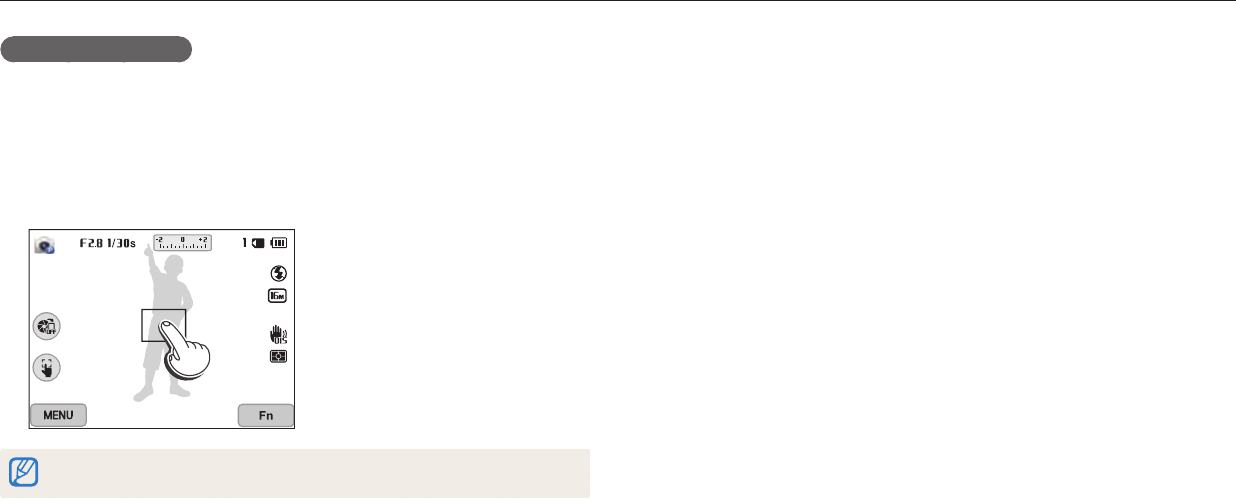
Changing the camera’s focus
Shooting options
74
Using One Touch Shot
You can capture a photo with the touch of your nger. As you touch on a subject,
the camera focuses on the subject automatically and captures a photo.
1 In Shooting mode, press [
m
].
2 Select Touch AF → One touch shot.
3 Touch the subject to capture a photo.
If you use this function, you cannot set Timer, Intelli zoom, and Burst options.

Shooting options
75
Detecting faces
Your camera automatically detects up to 10 human faces in one scene.
1 In Shooting mode, press [
m
].
2 Select Face Detection → Normal.
The face nearest the camera or nearest
the center of the scene appears in a
white focus frame and the rest of the
faces appear in gray focus frames.
The closer you are to the subjects, the quicker your camera will detect faces.
Capturing a self portrait shot
Capture photos of yourself. The camera sets the focus distance to close-up, and then
emits a beep when ready.
1 In Shooting mode, press [
m
].
2 Select Face Detection → Self-Portrait.
3 Compose your shot with the lens facing you.
4 When you hear a quick beep, press [Shutter].
When faces are located in the center,
the camera beeps rapidly.
If you turn Volume o in the sound settings, the camera will not emit a beep.
(p. 131)
Using Face Detection
If you use Face Detection options, your camera can automatically detect a human face. When you focus on a human face, the camera adjusts the exposure automatically. Use
Blink Detection to detect closed eyes or Smile Shot to capture a smiling face.
pAhMs

Using Face Detection
Shooting options
76
Capturing a smile shot
The camera automatically releases the shutter when it detects a smiling face.
1 In Shooting mode, press [
m
].
2 Select Face Detection → Smile Shot.
3 Compose your shot.
The camera automatically releases the shutter when it detects a smiling face.
When your subject smiles
broadly, your camera can detect
the smile more easily.
Tips for detecting faces
When your camera detects a face, it tracks the detected face automatically.
Face Detection may not be eective when:
-
the subject is far from the camera (The focus frame will appear orange for Smile
Shot and Blink Detection.)
-
it is too bright or too dark
-
the subject is not facing the camera
-
the subject is wearing sunglasses or a mask
-
the subject’s facial expression changes drastically
-
the subject is backlit or the lighting conditions are unstable
When you set Face Detection options, the AF area is automatically set to Multi AF.
Depending on the Face Detection options you selected, some Shooting options
may not be available.
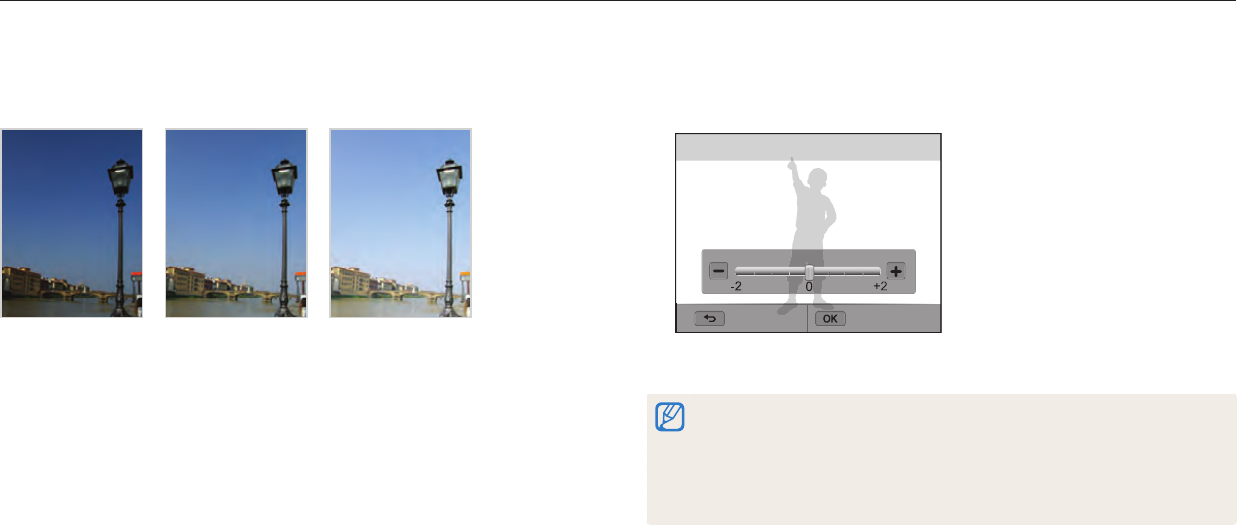
Shooting options
77
Adjusting brightness and color
Learn how to adjust the brightness and color for better image quality.
3 Press [
F
/
t
] to adjust the exposure.
You can also drag the slider or touch +/- to adjust the exposure.
The photo will be brighter as the exposure value increases.
Cancel Set
EV : 0
4 Press [
o
] to save your settings.
Once you adjust the exposure, the setting will be stored automatically. You
may need to change the exposure value later to avoid overexposure or
underexposure.
If you cannot decide on an appropriate exposure, select the AE Bracket (Auto
Exposure Bracket) option. The camera will capture 3 consecutive photos, each
with a dierent exposure: normal, underexposed, and overexposed. (p. 83)
Adjusting the exposure manually (EV)
Depending on the intensity of the ambient light, your photos may be too bright or
dark. In these cases, you can adjust the exposure to get a better photo.
S
Darker (-)
S
Neutral (0)
S
Brighter (+)
1 In Shooting mode, press [
m
].
2 Select EV.
You can also touch the exposure value on the screen to open the adjustment
window.
pAh

Adjusting brightness and color
Shooting options
78
Compensating for backlighting (ACB)
When the light source is behind your subject or there is high contrast between your
subject and the background, your subject is likely to appear dark in the photo. In
this case, set the Auto Contrast Balance (ACB) option.
▲ Without ACB ▲ With ACB
1 In Shooting mode, press [
m
].
2 Select ACB.
3 Select an option.
Icon Description
O: ACB (Auto Contrast Balance) is deactivated.
On: ACB (Auto Contrast Balance) is activated.
The ACB feature is always on in Smart Auto mode.
pAhM
Changing the metering option
The metering mode refers to the way in which a camera measures the quantity
of light. The brightness and lighting of your photos will vary depending on the
metering mode you select.
1 In Shooting mode, press [
m
].
2 Select Metering.
3 Select an option.
Icon Description
Multi:
Your camera divides the frame into several areas, and then
measures the light intensity of each area.
Suitable for general photos.
Spot:
Your camera measures only the light intensity at the very center of
the frame.
If a subject is not in the center of the frame, your photo may be
improperly exposed.
Suitable for a subject with backlighting.
Center-weighted:
Your camera averages the meter reading of the entire frame with
emphasis placed on the center.
Suitable for photos with subjects in the center of the frame.
pAhM
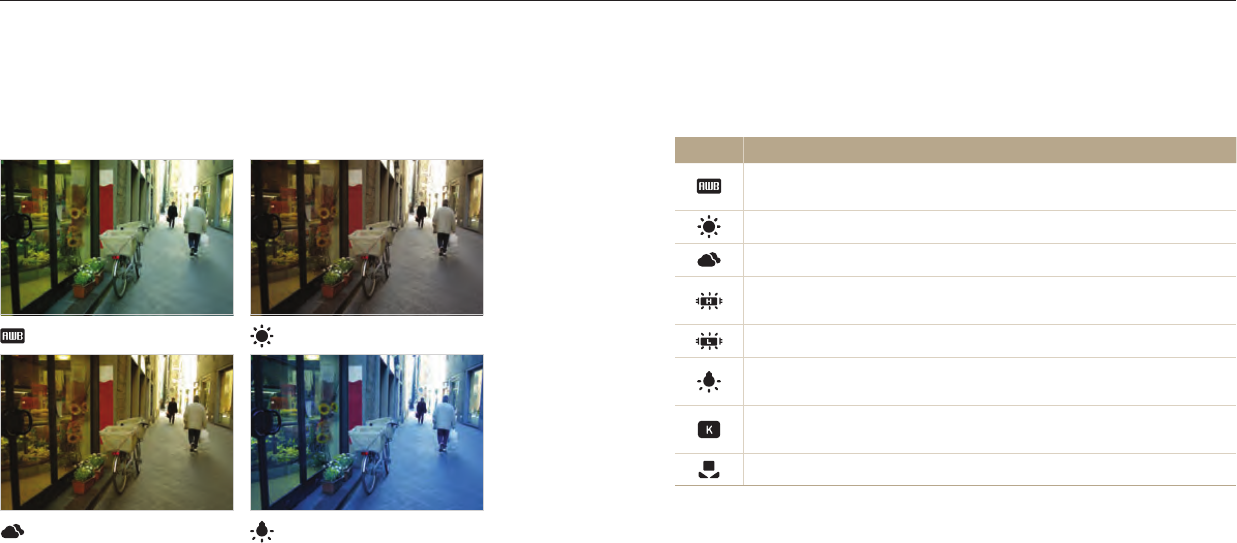
Adjusting brightness and color
Shooting options
79
Selecting a White Balance setting
The color of your photo depends on the type and quality of the light source. If you
want the color of your photo to be realistic, select a White Balance setting that
is appropriate for the lighting conditions, such as Auto WB, Daylight, Cloudy, or
Tungsten.
Auto WB Daylight
Cloudy Tungsten
pAhM
1 In Shooting mode, press [
m
].
2 Select White Balance.
3 Select an option.
Icon Description
Auto WB: Automatically set the White Balance based on the lighting
conditions.
Daylight: For outdoor photos on a sunny day.
Cloudy: For outdoor photos on a cloudy day or in shadows.
Fluorescent_H: For shooting under a daylight uorescent or 3-way
uorescent light.
Fluorescent_L: For shooting under white uorescent light.
Tungsten: For shooting indoor photos under incandescent bulbs or
halogen lamps.
Color Temp.: To adjust the color temperature of the light source.
(p. 80)
Custom Set: To use White Balance settings that you dene. (p. 81)
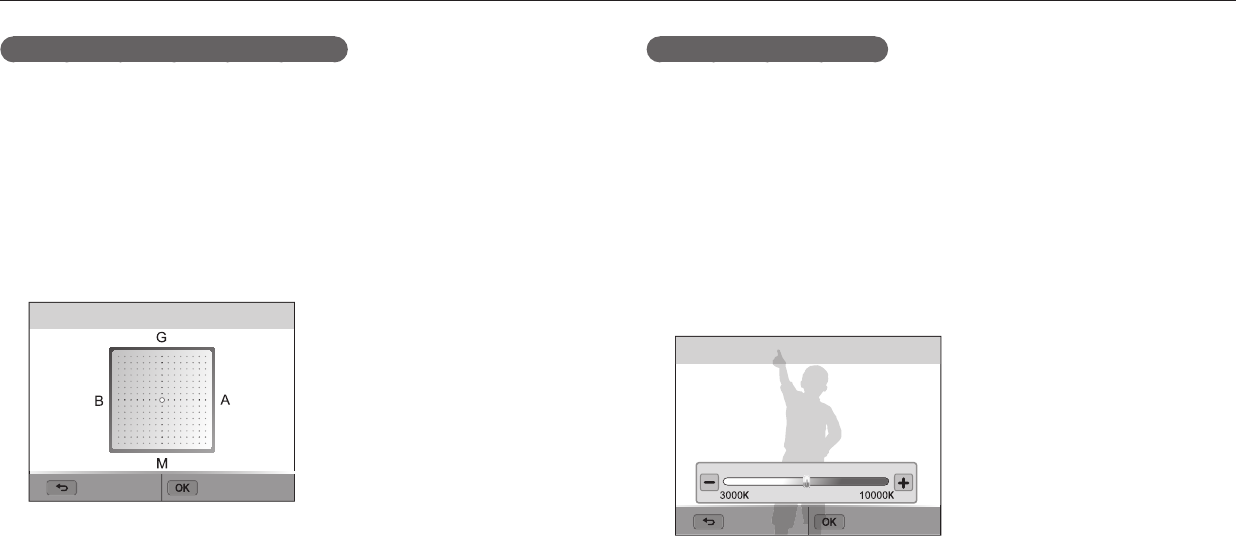
Adjusting brightness and color
Shooting options
80
Customizing preset White Balance options
You can customize preset White Balance options except Auto WB and Custom Set.
1 In Shooting mode, press [
m
].
2 Select White Balance.
3 Scroll to a desired option.
4 Press [
D
].
5 Press [
D
/
c
/
F
/
t
] to adjust the value on the coordinates.
You can also touch an area on the screen.
G: Green
A: Amber
M: Magenta
B: Blue
Back Set
White Balance : Daylight
6 Press [
o
] to save your settings.
Adjusting color temperature
1 In Shooting mode, press [
m
].
2 Select White Balance → Color Temp..
3 Press [
D
].
4 Press [
F
/
t
] to adjust the color temperature to match your light
source.
You can also drag the slider or touch +/- to adjust the color temperature.
You can capture a warmer photo with a higher color temperature setting
(more yellow/red), and a cooler photo with a lower color temperature setting
(more blue).
Color Temp. : 6500 K
Back Set
5 Press [
o
] to save your settings.

Adjusting brightness and color
Shooting options
81
Dening your own White Balance
You can customize the White Balance by capturing a photo of a white surface, such
as a piece of paper, under the lighting conditions in which you intend to capture a
photo. The White Balance feature will help you to match the colors in your photo
with the actual scene.
1 In Shooting mode, press [
m
].
2 Select White Balance → Custom Set.
3 Aim the lens at a piece of white paper, and then press [Shutter].

Shooting options
82
Using burst modes
It can be dicult to capture photos of fast-moving subjects or capture natural facial expressions and gestures of your subjects in photos. Also, it can be dicult to adjust the
exposure correctly and select a proper light source. In these cases, select one of the burst modes. You can also set the timer to delay shooting.
pAhMsig
3 Align your subject in the frame, and then half-press [Shutter] to
focus.
4 Press and hold [Shutter].
While you are pressing [Shutter], the camera captures photos continuously.
Available options may dier depending on the shooting conditions.
Depending on the Face Detection options you selected, some shooting options
may not be available.
It may take longer to save the photos depending on the memory card capacity
and performance.
In some modes, you can also set the shooting option by pressing [
m
], and
then selecting Drive/Timer.
Capturing continuous photos
1 In Shooting mode, press [
t
].
2 Select an option.
Icon Description
Continuous (7.1 fps): Capture 7.1 photos per second continuously.
(You can capture up to 6 photos in one burst.)
Continuous (3 fps): Capture 3 photos per second continuously.
(You can capture up to 6 photos in one burst.)
Single: Capture a single photo. (Single is not a burst option.)

Using burst modes
Shooting options
83
Using the timer
1 In Shooting mode, press [
t
].
2 Select an option.
Icon Option
2 Sec: Capture a photo after a 2-second delay.
10 Sec: Capture a photo after a 10-second delay.
Press [Shutter] to cancel the timer.
In some modes, you can also set the shooting option by pressing [
m
], and
then selecting Drive/Timer or Timer.
Capturing bracketed photos
You can use the automatic exposure bracketing feature to capture multiple photos
of the same subject with dierent exposure values.
1 In Shooting mode, press [
t
].
2 Select AE Bracket.
When you press [Shutter], the camera captures 3 consecutive photos, each with
a dierent exposure: normal, underexposed, and overexposed.
Press [
m
], and then select AE Bracket Set to select exposure values.
It may take longer to capture the photo. Use a tripod for best results.
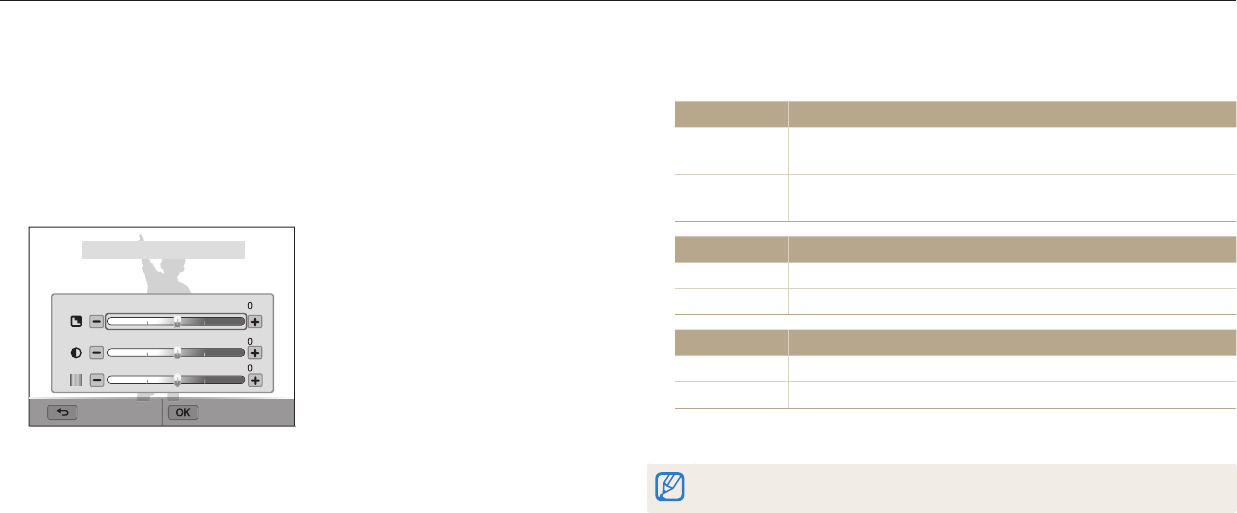
Shooting options
84
Adjusting images
Adjust the sharpness, contrast, or saturation of your photos.
pAhM
4 Press [
F
/
t
] to adjust each value.
You can also drag the sliders or touch +/- to adjust the values.
Sharpness Description
–Soften the edges on your photos (suitable for editing the
photos on your computer).
+Sharpen the edges to improve the clarity of your photos.
(This may also increase the noise in your photos.)
Contrast Description
–Decrease the color and brightness.
+Increase the color and brightness.
Saturation Description
–Decrease the saturation.
+Increase the saturation.
5 Press [
o
] to save your settings.
Select 0 if you do not want to apply any eects (suitable for printing).
1 In Shooting mode, press [
m
].
2 Select Image Adjust.
3 Select an option.
Sharpness
Contrast
Saturation
Image Adjust : Sharpness
Back Set
Sharpness
Contrast
Saturation

Shooting options
85
Reducing the sound of the zoom
When you use the zoom while recording videos, the camera can record the sound of the zoom. Use the Sound Alive function to reduce the zoom noise.
TpAhMsig
1 In Shooting mode, press [
m
].
2 Select Voice.
3 Select an option.
Icon Description
Sound Alive On: Turn on the Sound Alive function to reduce the
zoom noise.
Sound Alive O: Turn o the Sound Alive function. The camera can
record the zoom noise.
Do not block the microphone when you use the Sound Alive function.
Recordings made with Sound Alive may dier from actual sounds.

Viewing photos or videos in Playback mode
… 87
Starting Playback mode
……………………… 87
Viewing photos
………………………………… 92
Playing a video
………………………………… 94
Editing a photo
………………………………… 96
Resizing photos
………………………………… 96
Rotating a photo
……………………………… 96
Cropping a photo
……………………………… 97
Applying Smart Filter eects
…………………… 97
Adjusting your photos
………………………… 98
Viewing les on a TV
…………………………… 100
Transferring les to the computer
…………… 101
Transferring les to your Windows OS
computer
……………………………………… 101
Transferring les to your Mac OS computer
…… 102
Using programs on a computer
……………… 104
Installing i-Launcher
…………………………… 104
Using i-Launcher
……………………………… 105
Playback/Editing
Learn how to play back photos or videos, and edit photos. Also, learn how to connect your camera to your
computer or TV.
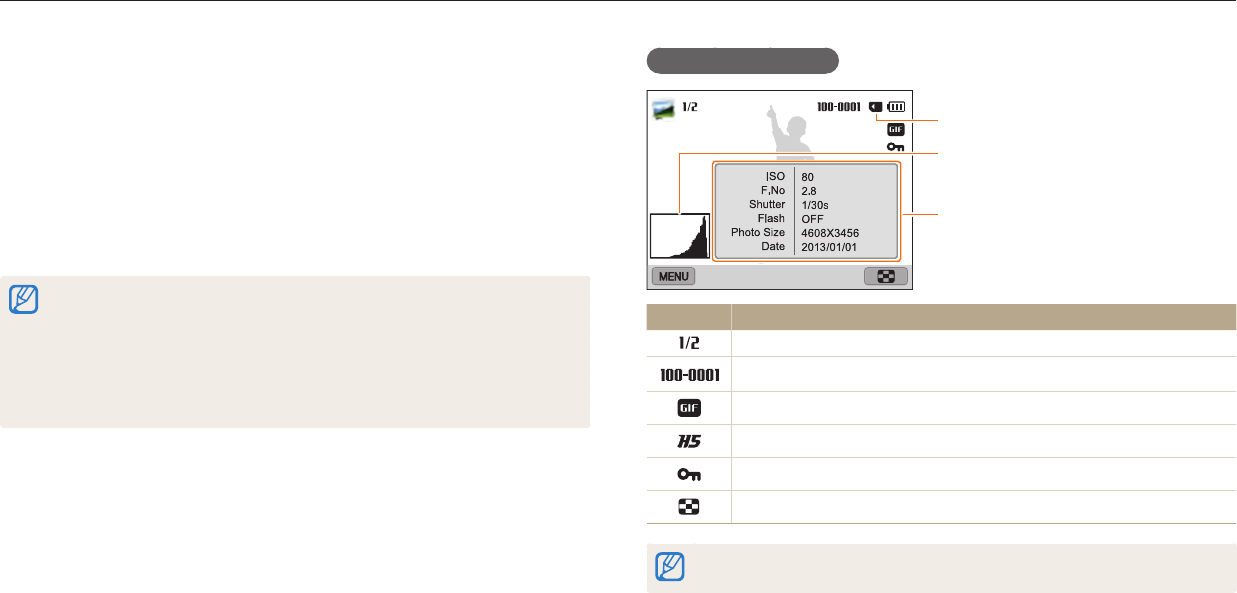
Playback/Editing
87
Starting Playback mode
View photos or play videos stored in your camera.
1 Press [
P
].
The most recent le will be displayed.
If the camera is o, it will turn on and display the most recent le.
2 Press [
F
/
t
] to scroll through les.
You can also drag the image left or right to move to another le.
Press and hold [
F
/
t
] to scroll through les quickly.
If you want to view les stored in the internal memory, remove your memory
card.
You may not be able to edit or play back les that were captured with other
cameras, due to unsupported sizes (image size, etc) or codecs. Use a computer or
another device to edit or play back these les.
Photos or videos captured in portrait orientation do not rotate automatically and
are displayed in landscape orientation by the camera and other devices.
Photo le information
File Information
Histogram
Memory in use
Icon Description
Current le/Total les
Folder name-File name
GIF le
Photo captured continuously (See "Viewing les as a folder", p. 88)
Protected le
View les as thumbnails (p. 89)
To display le information on the screen, press [
D
].
Viewing photos or videos in Playback mode
Learn how to play back photos or videos and how to manage les.
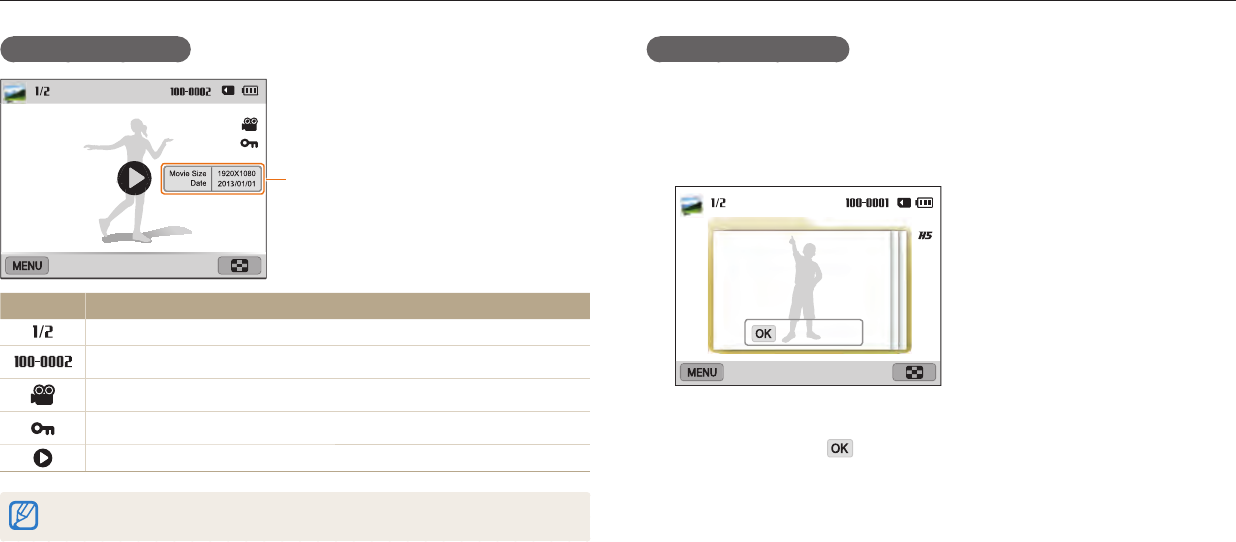
Viewing photos or videos in Playback mode
Playback/Editing
88
Video le information
File Information
Icon Description
Current le/Total les
Folder name-File name
Video le
Protected le
Play videos
To display le information on the screen, press [
D
].
Viewing les as a folder
Photos captured continuously appear as a folder.
1 In Playback mode, press [
F
/
t
] or drag the image left or right to
move to a desired folder.
The camera will automatically play back photos in the folder.
Single View
2 Press [
o
] or rotate [Zoom] to the right to open the folder.
You can also touch Single View on the screen to open the folder.
3 Press [
F
/
t
] or drag the image left or right to move to another le.
4 Press [
o
] or rotate [Zoom] to the left to return to Playback mode.
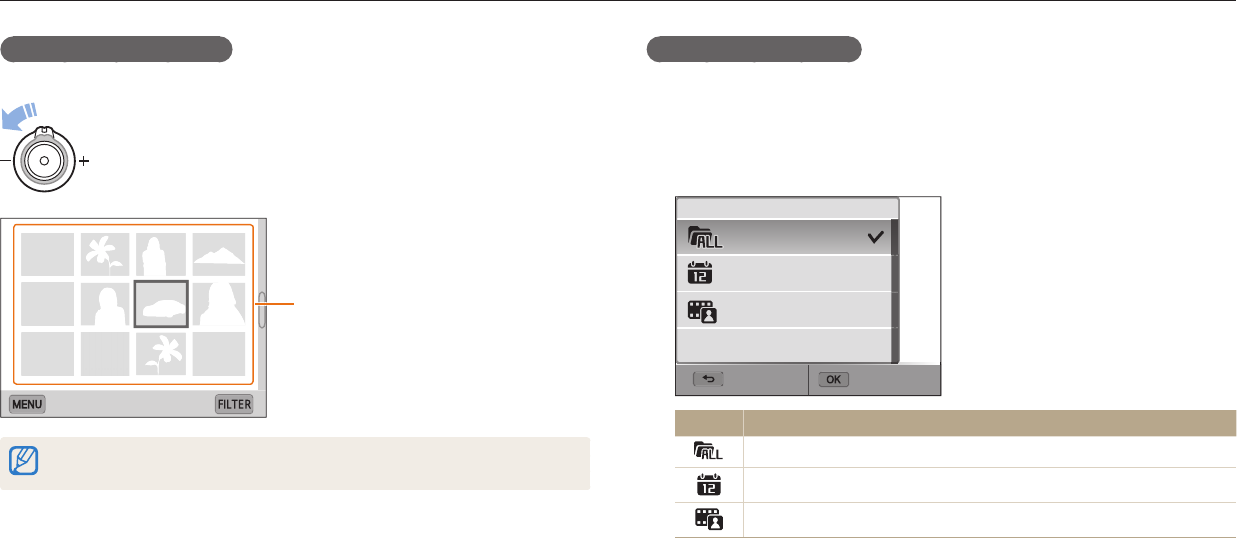
Viewing photos or videos in Playback mode
Playback/Editing
89
Viewing les as thumbnails
Scan thumbnails of les.
In Playback mode, rotate [Zoom] to the left to view thumbnails
(12 at a time). Rotate [Zoom] to the left once more to display more
thumbnails (24 at a time). Rotate [Zoom] to the right to return to
the previous view.
Touch a le to display it in full screen
view.
Press [
D
/
c
/
F
/
t
] or drag the screen up or down to move to the previous or
next page of thumbnails.
Viewing les by category
View les by category, such as date or le type.
1 In Playback mode, rotate [Zoom] to the left.
2 Press [
m
], and then select Filter → a category.
You can also touch FILTER to select a category.
All
Date
File Type
Filter
Back Set
Icon Description
All: View les normally.
Date: View les by the date they were saved.
File Type: View les by the le type.

Viewing photos or videos in Playback mode
Playback/Editing
90
3 Select a list to open it.
4 Select a le to view it.
5 Rotate [Zoom] to the left to return to the previous view.
If you change the category, it may take some time for the camera to reorganize
les depending on the number of les.
Protecting a le
Protect a le from accidental deletion.
1 In Playback mode, select a le to protect.
2 Press [
m
], and then select Protect → On.
3 Repeat steps 1 and 2 to protect additional les.
You cannot delete or rotate a protected le.
Deleting les
Select les to delete in Playback mode.
Deleting a single le
You can select one le, and then delete it.
1 In Playback mode, select a le, and then press [ /
f
].
2 When the pop-up message appears, select Ye s .
You can also delete les in Playback mode by pressing [
m
], and then selecting
Delete → Delete → Yes .

Viewing photos or videos in Playback mode
Playback/Editing
91
Deleting multiple les
You can select multiple les, and then delete them at once.
1 In Playback mode, press [
m
].
When in thumbnails view, press [
m
], select Delete → Select, and then skip
to step 3, or press [ /
f
], select Select, and then skip to step 3.
2 Select Delete → Multiple Delete.
3 Scroll to each le you want to delete, and then press [
o
].
Press [
o
] again to cancel your selection.
You can also select les by touching them.
4 Press [ /
f
].
5 When the pop-up message appears, select Ye s .
Deleting all les
You can select all les, and then delete them at once.
1 In Playback mode, press [
m
].
When in thumbnails view, press [
m
], select Delete → Delete All, and then
skip to step 3, or press [ /
f
], select Delete All, and then skip to step 3.
2 Select Delete → Delete All.
3 When the pop-up message appears, select Ye s .
All unprotected les are deleted.
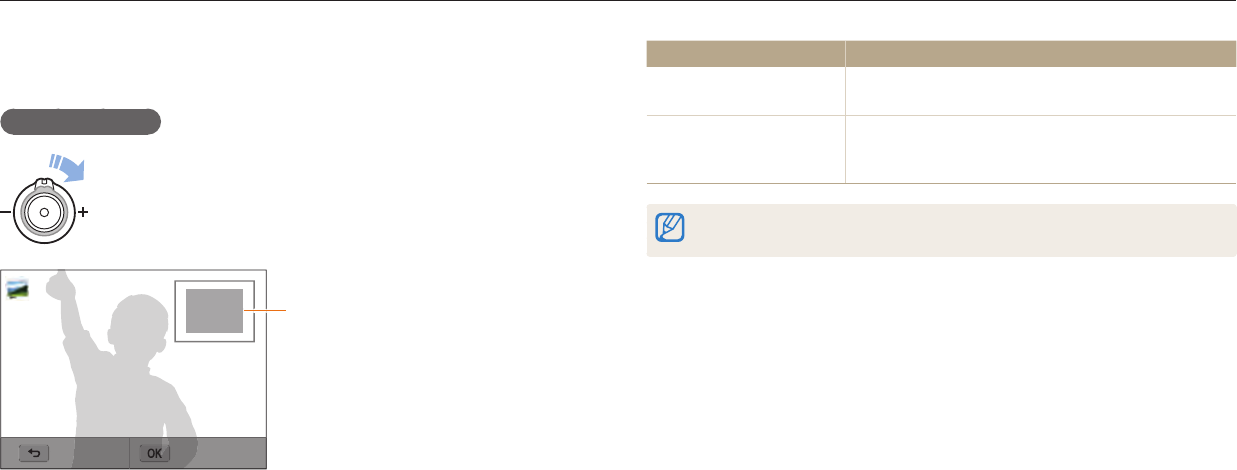
Viewing photos or videos in Playback mode
Playback/Editing
92
Viewing photos
Enlarge part of a photo or view photos as a slide show.
Enlarging a photo
In Playback mode, rotate [Zoom] to the right to enlarge a portion of
the photo. Rotate [Zoom] to the left to zoom out.
Enlarged area
Back Crop
To Description
Move the enlarged area
Press [
D
/
c
/
F
/
t
].
Drag the screen to see another part of the photo.
Trim the enlarged photo
Press [
o
], and then select Ye s. (The trimmed photo
will be saved as a new le. The original photo is
retained in its original form.)
When you view photos that were captured by another camera, the zoom ratio may
dier.

Viewing photos or videos in Playback mode
Playback/Editing
93
Viewing panoramic photos
View photos captured in Panorama mode.
1 In Playback mode, scroll to a panoramic photo.
The entire panoramic photo appears on the screen.
2 Press [
o
] or touch .
The camera automatically scrolls through the photo from left to right for a
horizontal panoramic photo and from top to bottom for a vertical panoramic
photo. The camera then switches to Playback mode.
While playing back a panoramic photo, press [
o
] to pause or resume.
After you have paused the playback of a panoramic photo, press
[
D
/
c
/
F
/
t
] or drag the image to move the photo horizontally or
vertically, depending on the direction you moved when capturing the photo.
3 Press [
b
] to return to Playback mode.
You can play the panoramic photo by pressing [
o
] or touching only if the
longest side of the photo is two or more times longer than the shortest side.
Viewing animated photos
View animated GIF les repeatedly that were captured in Motion Photo mode.
1 In Playback mode, scroll to a GIF le.
2 Press [
o
] or touch .
3 Press [
b
] to return to Playback mode.
Playing a slide show
Apply eects and audio to a slide show of your photos. The slide show function
does not work for videos and GIF les.
1 In Playback mode, press [
m
].
2 Select Slide Show Options.
3 Select a slide show eect option.
Skip to step 4 to start a slide show with no eects.
* Default
Option Description
Play Mode Set whether or not to repeat the slide show. (One Play*, Repeat)
Interval
Set the interval between photos. (1 sec*, 3 sec, 5 sec, 10 sec)
You must set the Eect option to O to set the interval.
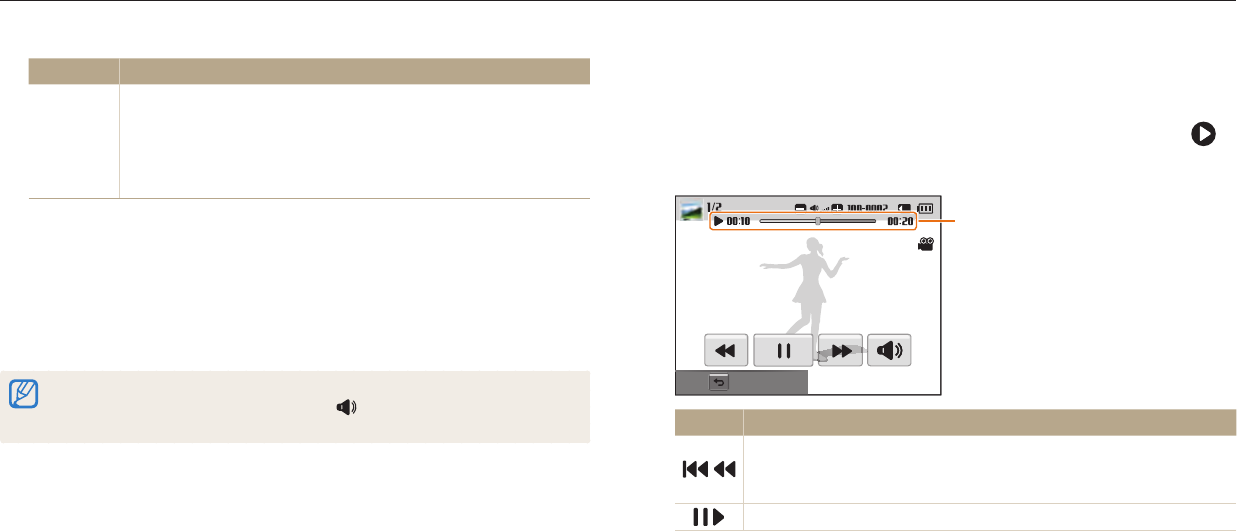
Viewing photos or videos in Playback mode
Playback/Editing
94
* Default
Option Description
Eect
Set a scene change eect between photos. (O, Calm*, Shine,
Relax, Lively, Sweet)
Select O to cancel eects.
When you use the Eect option, the interval between photos
will be set to 1 second.
4 Press [
b
].
5 Select Start Slide Show.
6 View the slide show.
Press [
o
] to pause the slide show.
Press [
o
] again to resume the slide show.
Press [
b
] to stop the slide show and return to Playback mode.
Rotate [Zoom] to the left or right or touch at the bottom of the screen to
adjust the volume level.
Playing a video
In Playback mode, you can view a video, and then capture or trim parts of the
playing video. You can save the captured or trimmed segments as new les.
1 In Playback mode, select a video, and then press [
o
] or touch .
2 View the video.
Current playback time/
Video length
Stop
Icon Description
/
Move to the previous le/Scan backward. (Each time you touch the
scan backward icon, you change the scan speed in this order: 2X, 4X,
8X.)
/Pause or resume playback.

Viewing photos or videos in Playback mode
Playback/Editing
95
Icon Description
/Move to the next le/Scan forward. (Each time you touch the scan
forward icon, you change the scan speed in this order: 2X, 4X, 8X.)
Adjust the volume or mute the sound.
When playing a movie, you can begin using features such a scanning backward or
scanning forward after the video has run for 2 seconds.
Trimming a video
1 In Playback mode, select a video, and then press [
m
].
2 Select Trim Movie.
3 Press [
o
] or touch to start playing the video.
4 Press [
o
] or touch at the point where you want the trimming to
begin.
5 Press [
c
] or touch Start Point.
6 Press [
o
] or touch to resume playing the video.
7 Press [
o
] or touch at the point where you want the trimming to
end.
8 Press [
c
] or touch End Point.
9 Press [
c
] or touch Trim to trim a video.
You can adjust the scene to be cropped by dragging the handles that appear
on the progress bar.
10
When the pop-up message appears, select Ye s .
The original video should be at least 10 seconds long.
The camera will save the edited video as a new le and leave the original video
intact.
Capturing an image from video
1 While viewing a video, press [
o
] or touch at the point where you
want to capture an image.
2 Press [
c
] or touch Capture.
The resolution of the captured image will be the same as the original video.
The captured image is saved as a new le.
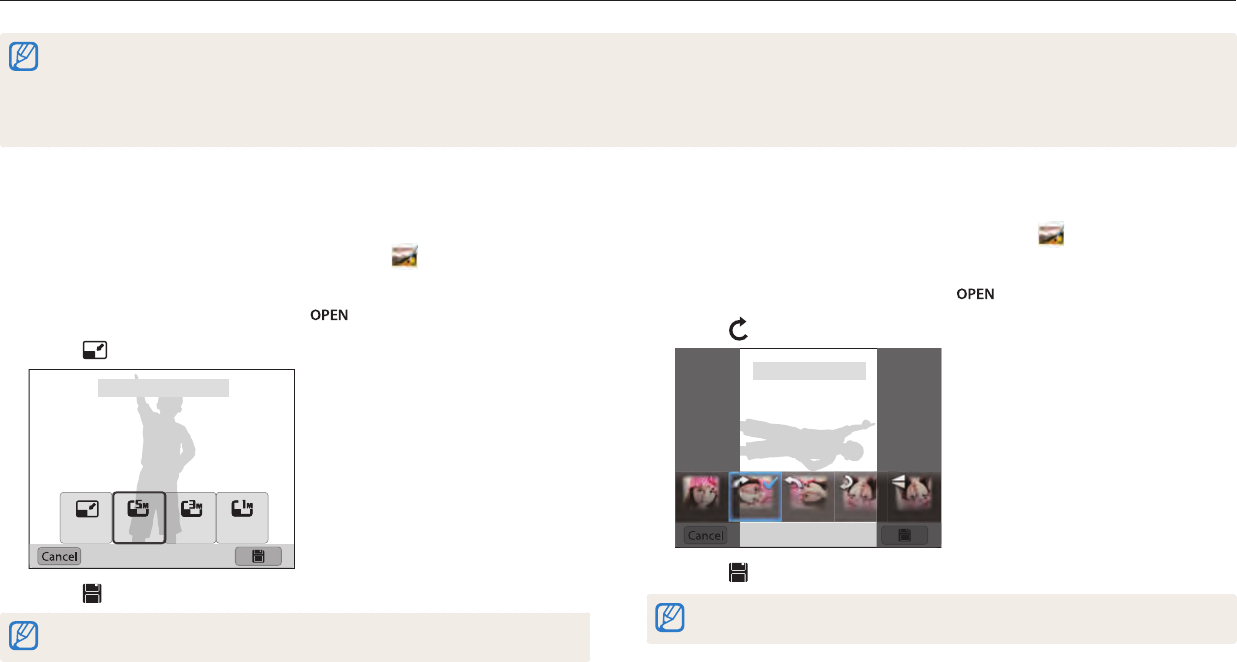
Playback/Editing
96
Resizing photos
Change the size of a photo and save it as a new le.
1 Rotate the mode dial to
g
, and then select .
You can also press [
m
], and then select Edit Image.
2 Rotate [Zoom] to the left or touch to select a photo.
3 Touch , and then touch an option.
Resize : 2592 X 1944
4 Touch to save.
Available resize options dier depending on the original size of the photo.
Rotating a photo
1 Rotate the mode dial to
g
, and then select .
You can also press [
m
], and then select Edit Image.
2 Rotate [Zoom] to the left or touch to select a photo.
3 Touch , and then touch an option.
Rotate : Right 90˚
4 Touch to save.
The camera will overwrite the original le.
Editing a photo
Learn how to edit photos.
The camera will save edited photos as new les.
When you edit photos, the camera will automatically convert them to a lower resolution. Photos that you rotate or resize manually are not automatically converted to a lower
resolution.
You cannot edit photos while viewing les as a folder. Open the folder and select a photo to edit each photo.
Photos captured in some modes cannot be edited.
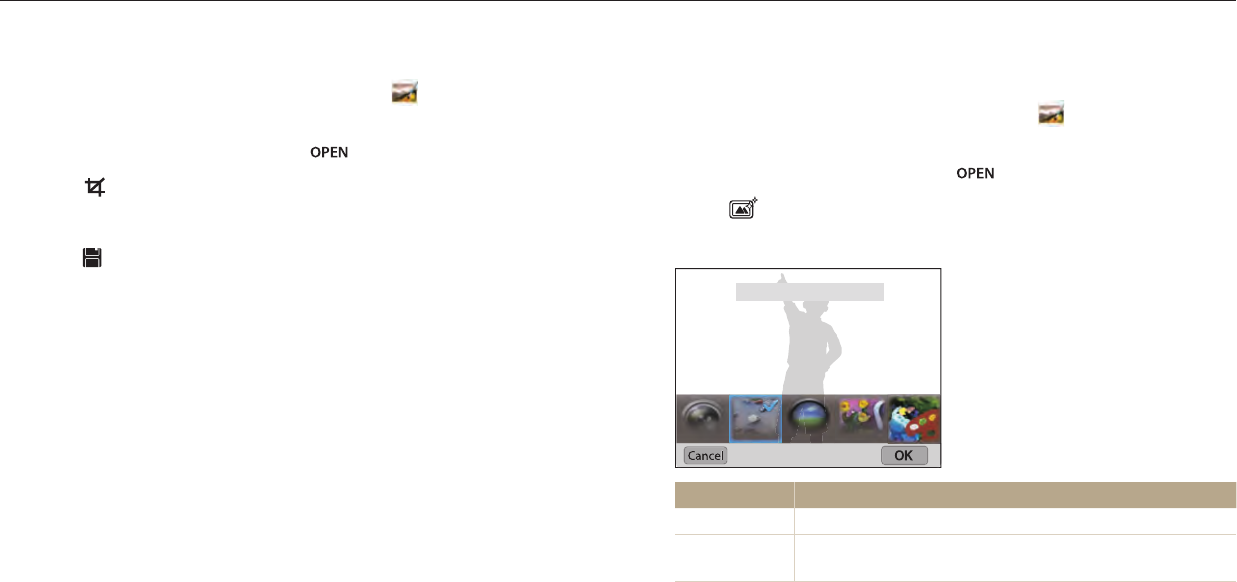
Editing a photo
Playback/Editing
97
Cropping a photo
1 Rotate the mode dial to
g
, and then select .
You can also press [
m
], and then select Edit Image.
2 Rotate [Zoom] to the left or touch to select a photo.
3 Touch , and then select an area to drag and crop.
4 Adjust the size of the area by dragging the corners of the box.
5 Touch to save.
Applying Smart Filter eects
Apply special eects to your photos.
1 Rotate the mode dial to
g
, and then select .
You can also press [
m
], and then select Edit Image.
2 Rotate [Zoom] to the left or touch to select a photo.
3 Touch , and then touch an option.
4 Touch
o
.
Smart Filter : Miniature
Option Description
O No eect
Miniature Apply a tilt-shift eect to make the subject appear in
miniature. (The top and bottom of the photo will be blurred.)

Editing a photo
Playback/Editing
98
Option Description
Vignetting Apply the retro-looking colors, high contrast, and strong
vignette eect of Lomo cameras.
Ink Painting Apply a watercolor painting eect.
Oil Painting Apply an oil painting eect.
Cartoon Apply a cartoon painting eect.
Cross Filter Add lines that radiate outward from bright objects to imitate
the visual eect of a cross lter.
Sketch Apply a pen sketch eect.
Soft Focus Hide facial imperfections or apply dreamy eects.
Fish-eye Distort close objects to imitate the visual eect of a sheye
lens.
Classic Apply a black and white eect.
Retro Apply a sepia tone eect.
Zooming Shot Blur the edges of a photo to emphasize the subjects in the
center.
5 Touch to save.
Adjusting your photos
Learn how to adjust the brightness, contrast, or saturation or how to correct the
red-eye eect. If the center of a photo is dark, you can adjust it to be brighter.
The camera will save an edited photo as a new le, but may convert it to a lower
resolution.
You can adjust brightness, contrast, and saturation and apply Smart Filter eects
at the same time.
You cannot apply the ACB, Face Retouch, and Red-eye Fix eects at the same
time.
If you have applied the ACB eect, you cannot adjust brightness, contrast, or
saturation. If you have adjusted brightness, contrast, or saturation, you cannot
apply the ACB eect.
Adjusting dark subjects, brightness, contrast, or saturation
1 Rotate the mode dial to
g
, and then select .
You can also press [
m
], and then select Edit Image.
2 Rotate [Zoom] to the left or touch to select a photo.
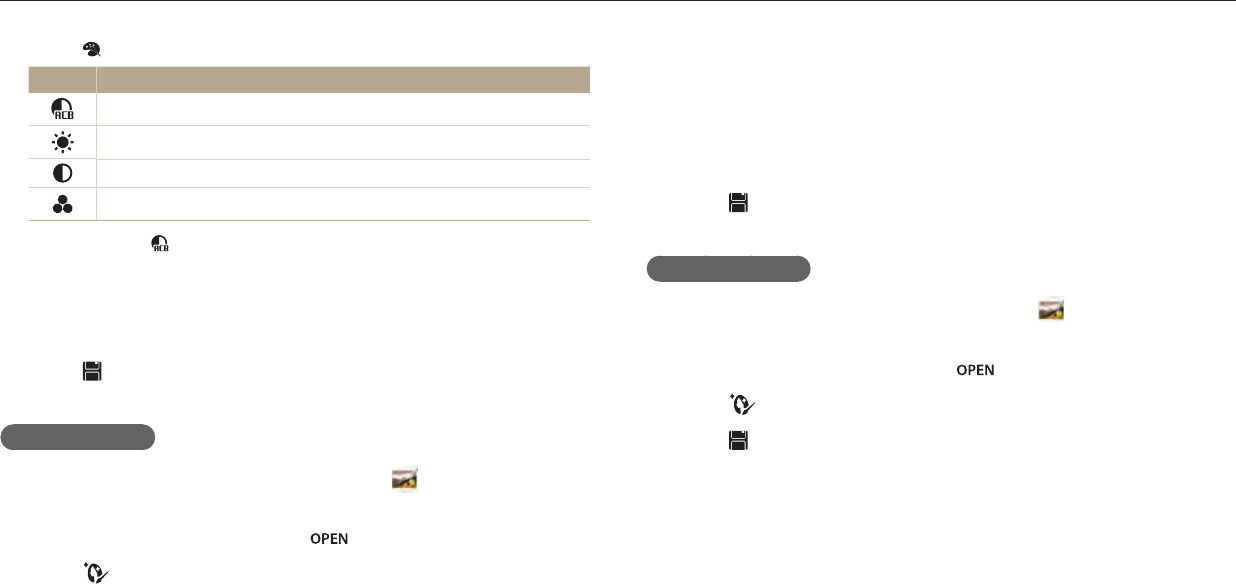
Editing a photo
Playback/Editing
99
3 Touch , and then select an adjusting option.
Icon Description
ACB (Adjust dark subjects)
Brightness
Contrast
Saturation
If you selected , skip to step 6.
4 Press [
F
/
t
] to adjust the option.
You can also drag the slider or touch +/- to adjust the option.
5 Touch
o
.
6 Touch to save.
Retouching faces
1 Rotate the mode dial to
g
, and then select .
You can also press [
m
], and then select Edit Image.
2 Rotate [Zoom] to the left or touch to select a photo.
3 Touch , and then touch Face Retouch.
4 Press [
o
].
5 Press [
F
/
t
] to adjust the option.
You can also drag the slider or touch +/- to adjust the option.
As the number increases, the skin tone becomes brighter and smoother.
6 Press [
o
].
7 Touch to save.
Removing red-eye
1 Rotate the mode dial to
g
, and then select .
You can also press [
m
], and then select Edit Image.
2 Rotate [Zoom] to the left or touch to select a photo.
3 Touch , and then touch Red-eye Fix.
4 Touch to save.
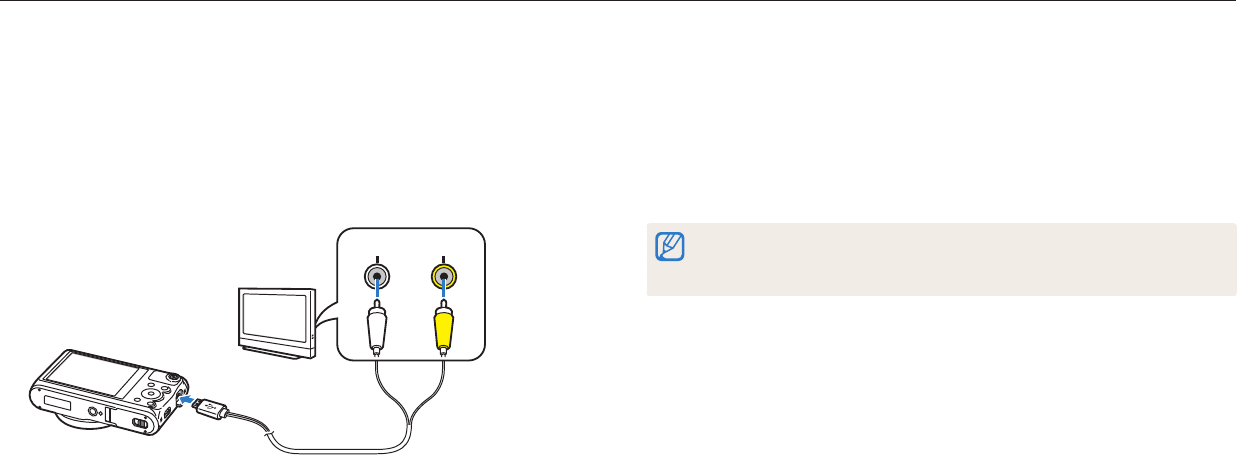
Playback/Editing
100
Viewing les on a TV
Play back photos or videos by connecting your camera to a TV with the A/V cable.
6 Turn on your TV, and then select the A/V video source with the TV
remote control.
7 Turn on your camera.
The camera automatically enters into Playback mode when you connect it to
a TV.
8 View photos or play videos using the camera buttons.
Depending on the TV model, you may see some digital noise or part of an image
may not appear.
Images may not be centered on the TV screen depending on your TV settings.
1 Rotate the mode dial to
n
.
2 Select Connectivity → Video Out.
3 Select the video signal output for your country or region. (p. 132)
4 Turn o your camera and TV.
5 Connect your camera to your TV with the A/V cable.
VideoAudio
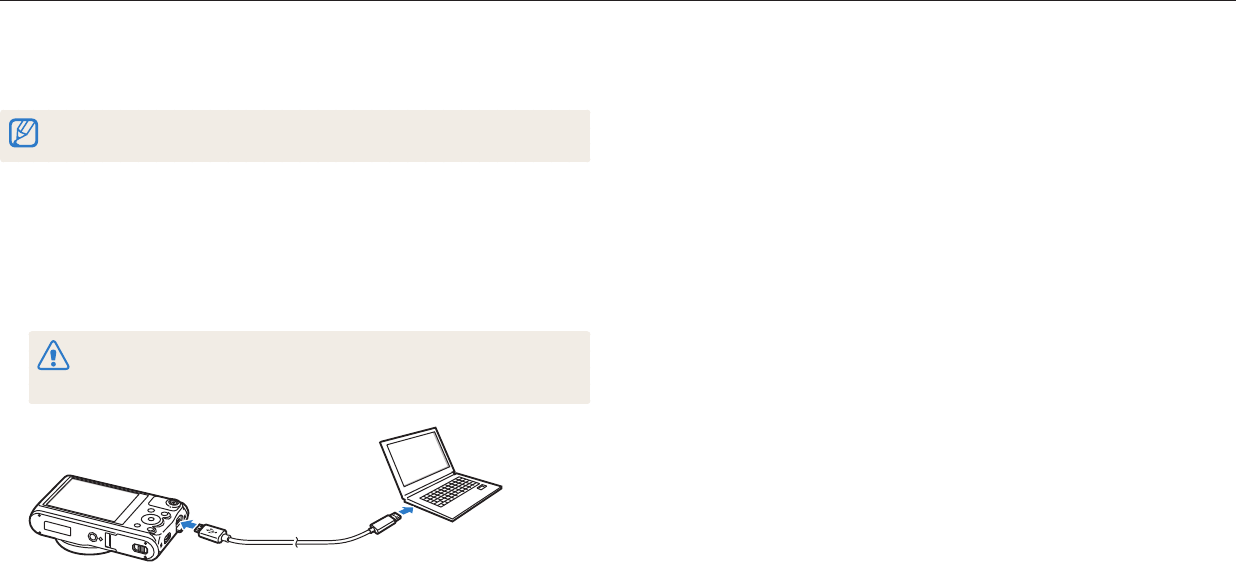
Playback/Editing
101
Transferring les to your Windows OS computer
Connect the camera to your computer as a removable disk.
Your computer must be running Windows XP, Windows Vista, Windows 7, or
Windows 8 for you to connect the camera as a removable disk.
1 Rotate the mode dial to
n
.
2 Select Connectivity → i-Launcher → O.
3 Turn o the camera.
4 Connect the camera to your computer with the USB cable.
You must plug the small end of the USB cable into your camera. If the cable is
reversed, it may damage your les. The manufacturer is not responsible for any
loss of data.
5 Turn on the camera.
The computer recognizes the camera automatically.
6 On your computer, select My Computer → Removable Disk → DCIM
→ 100PHOTO.
7 Drag or save les to your computer.
Transferring les to the computer
Connect the camera to a computer to transfer les from the camera's memory card to the computer.
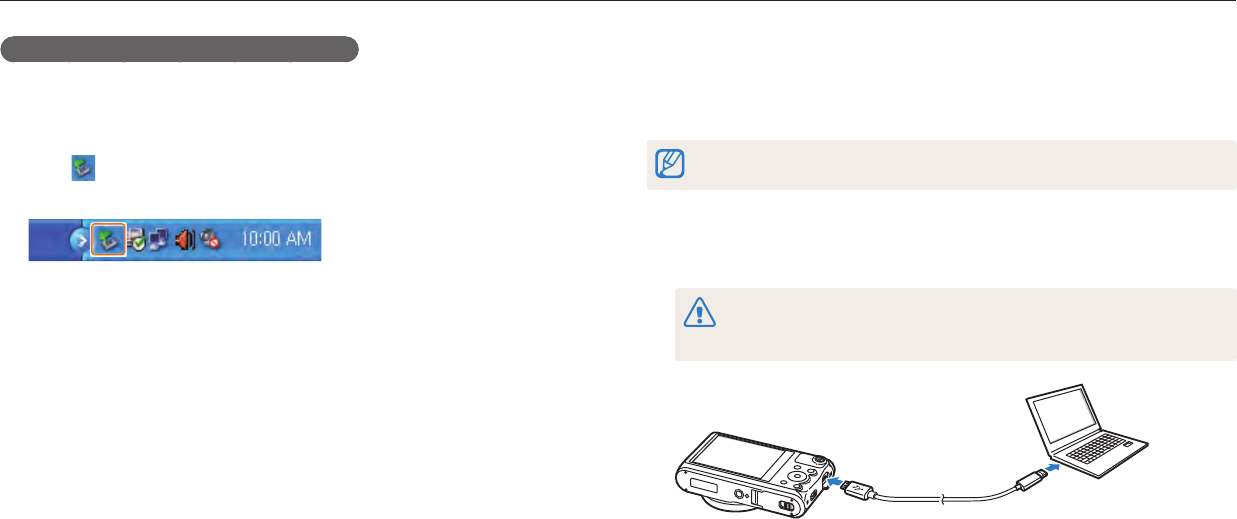
Transferring les to the computer
Playback/Editing
102
Disconnecting the camera (for Windows XP)
With Windows Vista, Windows 7 and Windows 8, the methods for disconnecting the
camera are similar.
1 If the status lamp on your camera is blinking, wait until it stops.
2 Click on the tool bar at the bottom right of your computer
screen.
3 Click the pop-up message.
4 Click the message box that indicates the camera can be removed
safely.
5 Remove the USB cable.
Transferring les to your Mac OS computer
When you connect the camera to your Mac OS computer, the computer will
automatically recognize the device. You can transfer les directly from the camera to
the computer without installing any programs.
Mac OS 10.5 or later is supported.
1 Turn o the camera.
2 Connect your camera to your Mac OS computer with the USB cable.
You must plug the small end of the USB cable into your camera. If the cable is
reversed, it may damage your les. The manufacturer is not responsible for any
loss of data.

Transferring les to the computer
Playback/Editing
103
3 Turn on the camera.
The computer recognizes the camera automatically and displays a removable
disk icon.
4 Open the removable disk.
5 Drag or save les to your computer.
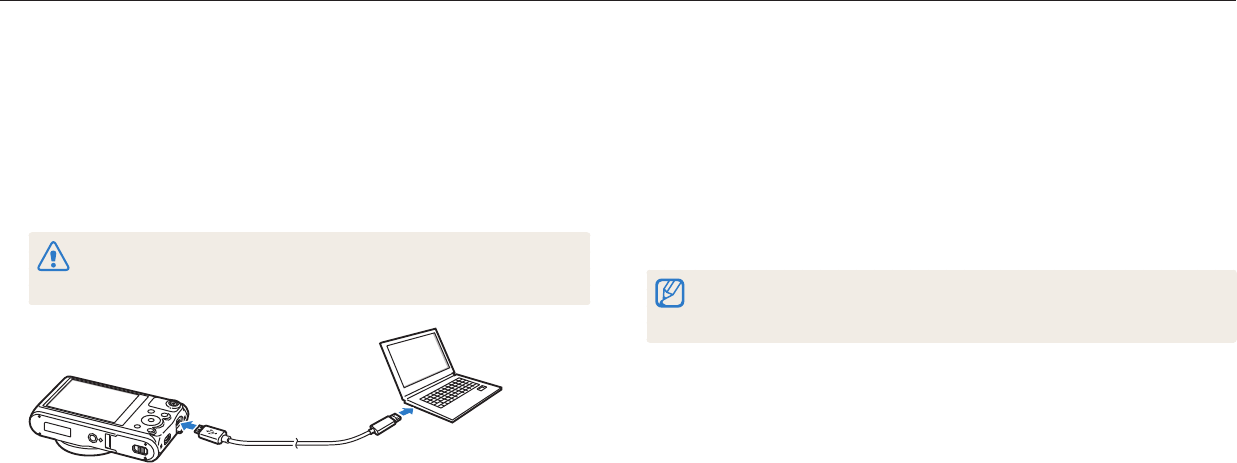
Playback/Editing
104
Using programs on a computer
i-Launcher allows you to play back les with Multimedia Viewer and provides links so that you can download useful programs.
5 Turn on the camera.
6 When the pop-up window prompts you to install i-Launcher, select
Yes.
If a pop-up window prompting you to run iLinker.exe appears, run it rst.
When you connect the camera to a computer with i-Launcher installed, the
program will launch automatically.
7 Follow the on-screen instructions to complete the installation.
An i-Launcher shortcut will appear on the computer.
Before installing the program, ensure that the PC is connected to a network.
To install i-Launcher on your Mac OS computer, click Devices → i-Launcher →
Mac → iLinker.
Installing i-Launcher
1 Rotate the mode dial to
n
.
2 Select Connectivity → i-Launcher → On.
3 Turn o the camera.
4 Connect the camera to your computer with the USB cable.
You must plug the small end of the USB cable into your camera. If the cable is
reversed, it may damage your les. The manufacturer is not responsible for any
loss of data.

Using programs on a computer
Playback/Editing
105
Windows OS Requirements
Item Requirements
CPU Intel® Core™ 2 Duo 1.66 GHz or higher/
AMD Athlon X2 Dual-Core 2.2 GHz or higher
RAM Minimum 512 MB RAM (1 GB or more recommended)
OS* Windows XP SP2, Windows Vista, Windows 7, or Windows 8
Hard disk
capacity 250 MB or more (1 GB and above recommended)
Others
1024 X 768 pixels, 16-bit color display compatible monitor
(1280 X 1024 pixels, 32-bit color display recommended)
USB 2.0 port
nVIDIA Geforce 7600GT or higher/
ATI X1600 series or higher
Microsoft DirectX 9.0c or higher
* A 32-bit version of i-Launcher will be installed—even on 64-bit editions of Windows XP,
Windows Vista, Windows 7, and Windows 8.
Available programs when using i-Launcher
Option Description
Multimedia Viewer You can view les with Multimedia Viewer.
Firmware Upgrade You can update the rmware of your camera.
PC Auto Backup
i-Launcher provides a link for downloading the PC
Auto Backup program when you connect the camera
to a computer. You can send photos or videos that you
captured with the camera to a PC wirelessly.
If you use a Mac OS computer, only Firmware Upgrade and PC Auto Backup are
available.
Using i-Launcher
i-Launcher allows you to play back les with Multimedia Viewer and provides a link
to download the PC Auto Backup program.
The requirements are recommendation only. i-Launcher may not work properly
even when the computer meets the requirements, depending on the condition
of your computer.
If your computer does not meet the requirements, videos may not play correctly.
The manufacturer is not responsible for any damage that results from using
unqualied computers such as a computer you assembled yourself.

Using programs on a computer
Playback/Editing
106
Opening i-Launcher
On your computer, select Start → All Programs → Samsung → i-Launcher →
Samsung i-Launcher. On your Mac, click Applications → Samsung → i-Launcher.
Mac OS requirements
Item Requirements
OS Mac OS 10.5 or higher (except PowerPC)
RAM Minimum 256 MB RAM (512 MB or more recommended)
Hard disk
capacity Minimum 110 MB
Others USB 2.0 port
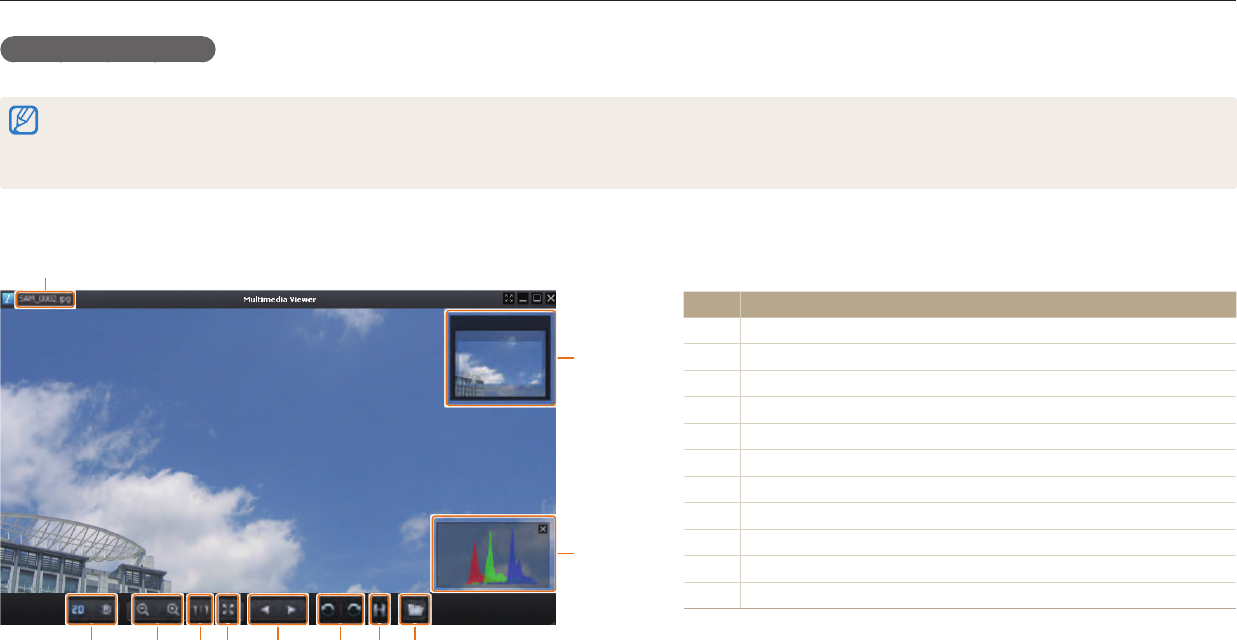
Using programs on a computer
Playback/Editing
107
Using Multimedia Viewer
Multimedia Viewer allows you to play back les. From the Samsung i-Launcher screen, click Multimedia Viewer.
Multimedia Viewer supports the following formats:
-
Videos: MP4 (Video: H.264, Audio: AAC), WMV (WMV 7/8/9), AVI (MJPEG)
-
Photos: JPG, GIF, BMP, PNG, TIFF, MPO
Files that have been recorded with other manufacturers’ devices may not play back smoothly.
Viewing photos
3
2
6790!8 54
1
No. Description
1
File name
2
Enlarged area
3
Histogram
4
Open the selected le.
5
Histogram button
6
Rotate to the left/Rotate to the right.
7
Move to the previous le/Move to the next le.
8
Fit the photo to the screen.
9
View the photo in its original size.
0
Zoom in/Zoom out
!
Switches between 2D and 3D mode.
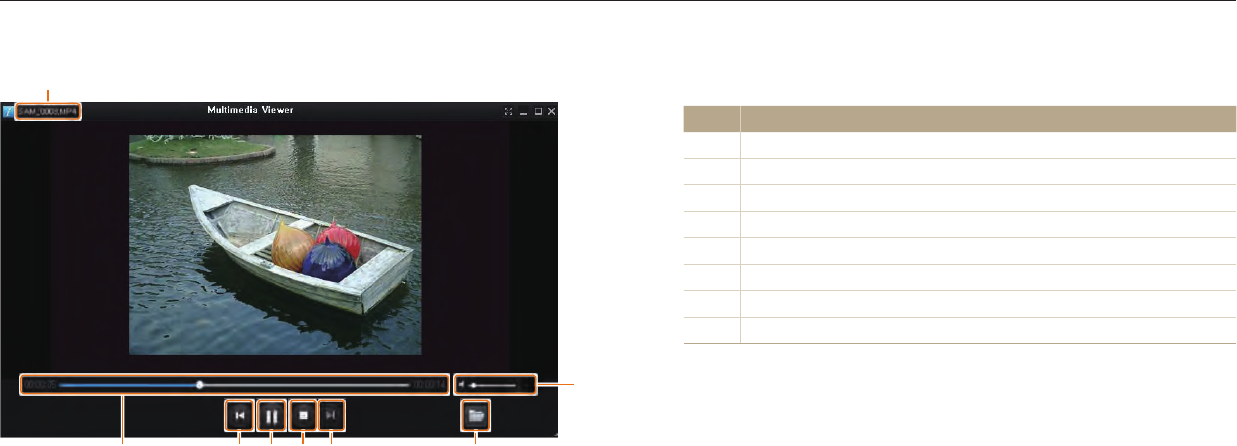
Using programs on a computer
Playback/Editing
108
Viewing videos
1
685437
2
No. Description
1
File name
2
Adjust the volume.
3
Open the selected le.
4
Move to the next le.
5
Stop
6
Pause
7
Move to the previous le.
8
Progress bar

Using programs on a computer
Playback/Editing
109
Updating the rmware
From the Samsung i-Launcher screen, click Firmware Upgrade.
Downloading the PC Auto Backup program
From the Samsung i-Launcher screen, click PC Auto Backup. For information about
installing the PC Auto Backup program, refer to page 119.

Connecting to a WLAN and conguring
network settings
………………………………… 111
Connecting to a WLAN
………………………… 111
Using the login browser
……………………… 112
Network connection tips
……………………… 113
Entering text
…………………………………… 114
Saving les to a smart phone automatically
… 115
Sending photos or videos to a smart phone
… 116
Using a smart phone as a remote
shutter release
…………………………………… 117
Using Auto Backup to send photos or videos
… 119
Installing the program for Auto Backup
on your PC
……………………………………… 119
Sending photos or videos to a PC
……………… 119
Sending photos or videos via email
…………… 121
Changing email settings
……………………… 121
Sending photos or videos via email
…………… 123
Using photo or video sharing websites
……… 124
Accessing a website
…………………………… 124
Uploading photos or videos
…………………… 124
Using AllShare Play to send les
……………… 126
Uploading photos to online storage
…………… 126
Viewing photos or videos on devices that
support Samsung Link.
………………………… 127
Wireless network
Learn how to connect to wireless local area networks (WLANs) and use functions.
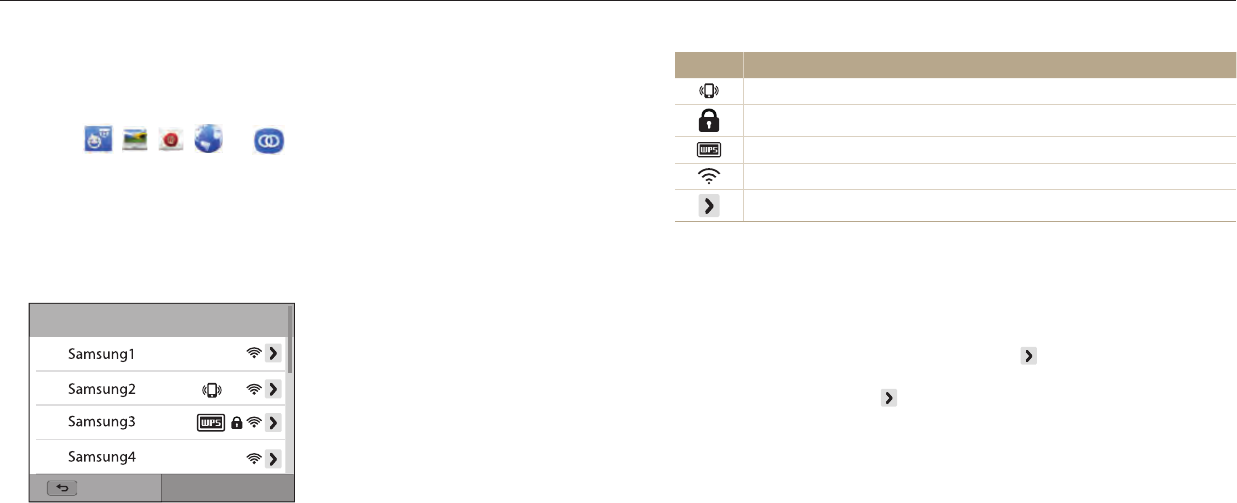
Wireless network
111
Connecting to a WLAN and conguring network settings
Learn to connect via an access point (AP) when you are in a range of a WLAN. You can also congure network settings.
Icon Description
Ad hoc AP
Secured AP
WPS AP
Signal strength
Press [
t
] or touch to open AP setting options
When you select a secured AP, a pop-up window appears. Enter the required
passwords to connect to the WLAN. For information about entering text, refer
to "Entering text". (p. 114)
When a login page appears, refer to "Using the login browser". (p. 112)
When you select an unsecured AP, the camera will connect to the WLAN.
If you select a WPS prole supported AP, select → WPS PIN connection,
and then enter a PIN on the AP device. You can also connect to a WPS prole
supported AP by selecting → WPS button connection on the camera, and
then pushing the WPS button on the AP device.
Connecting to a WLAN
1 Rotate the mode dial to
w
.
2 Select , , , , or .
3 Press [
m
], and then select Wi-Fi Setting.
In some modes, follow the on-screen instructions until the Wi-Fi Setting
screen appears.
The camera automatically searches for available AP devices.
4 Select an AP.
Refresh
Back
Select Refresh to refresh connectable APs.
Select Add wireless network to add an AP manually. Your AP name must be
in English to add the AP manually.
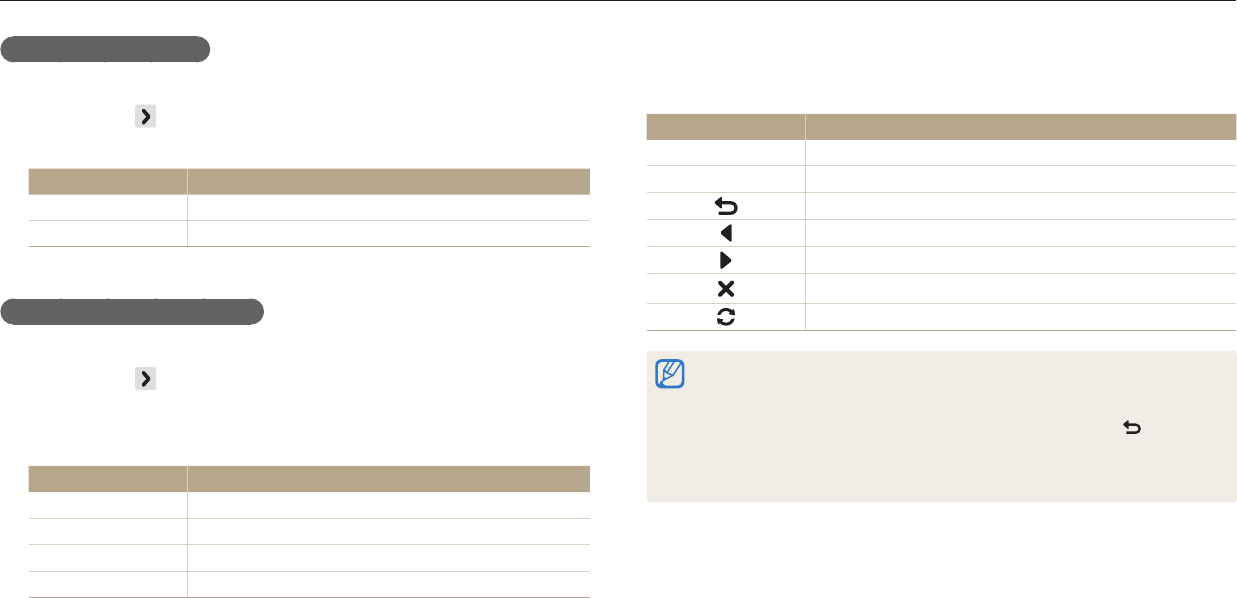
Connecting to a WLAN and conguring network settings
Wireless network
112
Setting network options
1 In the Wi-Fi Setting screen, move to an AP, and then press
[
t
] or touch .
2 Select each option, and then enter the required information.
Option Description
Network Password Enter the network password.
IP Setting Set the IP address automatically or manually.
Manually setting the IP address
1 In the Wi-Fi Setting screen, move to an AP, and then press
[
t
] or touch .
2 Select IP Setting → Manual.
3 Select each option, and then enter the required information.
Option Description
IP Enter the static IP address.
Subnet Mask Enter the subnet mask.
Gateway Enter the gateway.
DNS Server Enter the DNS address.
Using the login browser
You can enter your login information via the login browser when connecting to
some APs, sharing sites, or cloud servers.
Button/Icon Description
[
D
/
c
/
F
/
t
]Move to an item or scroll the page.
[
o
] Select an item.
Close the login browser.
Move to the previous page.
Move to the next page.
Stop loading the page.
Reload the page.
You may not be able to select some items depending on the page you connected
to. This does not indicate a malfunction.
The login browser may not close automatically after you log into some pages. If
this occurs, close the login browser by pressing [
b
] or touching , and then
proceed with the desired operation.
It may take longer to load the login page due to the page size or network speed.
If this occurs, wait until the login information input window appears.

Connecting to a WLAN and conguring network settings
Wireless network
113
Network connection tips
Some Wi-Fi features are not available if you do not insert a memory card.
The quality of the network connection will be determined by the AP.
The further the distance between your camera and the AP, the longer it will take
to connect to the network.
If a nearby device is using the same radio frequency signal as your camera, it may
interrupt your connection.
If your AP name is not in English, the camera may not be able to locate the device
or the name may appear incorrectly.
For network settings or a password, contact your network administrator or
network service provider.
If a WLAN requires authentication from the service provider, you may not be able
to connect to it. To connect the WLAN, contact your network service provider.
Depending on the encryption type, the number of digits in the password may
dier.
A WLAN connection may not be possible in all surroundings.
The camera may display a WLAN enabled printer on the AP List. You cannot
connect to a network via a printer.
You cannot connect your camera to a network and a TV simultaneously.
Connecting to a network may incur additional charges. Costs will vary based on
the conditions of your contract.
If you cannot connect to a WLAN, try another AP from the available AP list.
A login page may appear when you select free WLANs provided by some
network service providers. Enter your ID and password to connect to the WLAN.
For information about registering or the service, contact the network service
providers.
Be cautious when you enter personal information for an AP connection. Do not
enter any payment or credit card information on your camera. The manufacturer
is not liable for any problem caused by entering such information.
Available network connections may dier by country.
The WLAN feature of your camera must comply with radio transmission laws in
your region. To ensure compliance, use the WLAN feature only in the country
where you purchased the camera.
The process for adjusting network settings may dier, depending on network
conditions.
Do not access a network that you are not authorized to use.
Before you connect to a network, ensure your battery is fully charged.
You cannot upload or send les captured in some modes.
Files that you transfer to another device may not be supported by the device. In
this case, use a computer to play back the les.
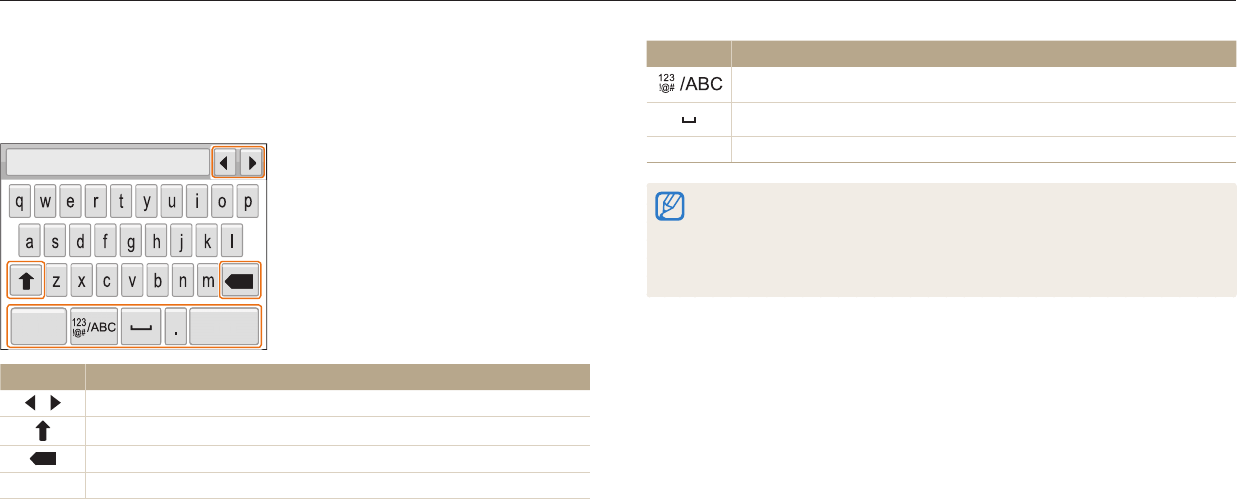
Connecting to a WLAN and conguring network settings
Wireless network
114
Entering text
Learn how to enter text. The icons in the table below let you move the cursor,
change the case, etc. Press [
D
/
c
/
F
/
t
] to move to a desired key, and then press
[
o
] to enter the key. You can also touch a key to enter it.
X
Cancel Done
X
Canc
el
D
one
Icon Description
Move the cursor.
In ABC mode, change the case.
X
Delete the last letter.
Cancel Stop entering text and return to the previous page.
Icon Description
Switch between Symbol mode and ABC mode.
Enter a space.
Done Save the displayed text.
You can use only the English alphabets in some modes, regardless of the display
language.
To move to Done directly, press [
P
].
You can enter up to 64 characters.
The screen may dier depending on the input mode.

Wireless network
115
Saving les to a smart phone automatically
The camera connects to a smart phone that supports the AutoShare feature via a WLAN. When you capture a photo with your camera, the photo is saved to the smart phone
automatically.
The AutoShare feature is supported by Galaxy series smart phones or Galaxy Tab models with the Android 2.2 OS or higher or iOS devices with the iOS 4.3 or higher. Before using this
feature, check the device’s rmware and update it if needed.
You should install Samsung SMART CAMERA App on your phone or device before using this feature. You can download the application from Samsung Apps, the Google Play Store, or
the Apple App Store. Samsung SMART CAMERA App is compatible with Samsung camera models manufactured in 2013 or later.
This feature is not available with the internal memory in some Shooting modes.
If you set this function, the setting is maintained even when you change the Shooting mode.
This feature may not be supported in some modes.
5 On the camera, allow the smart phone to connect to your camera.
If the smart phone has been connected to your camera before, it is connected
automatically.
An icon that shows the connection status ( ) will appear on the camera’s
screen.
6 On the camera, capture a photo.
The captured photo is saved to the camera, and then transferred to the smart
phone.
If you recorded a video, it is saved only to the camera.
A GIF le captured in Motion Photo mode is not saved on the smart phone.
The image le captured while recording a video is not saved on the smart
phone.
1 On the camera, in Shooting mode, press [
m
].
2 On the camera, select AutoShare → On.
If the pop-up message that prompts you to download the application
appears, select Next.
3 On the smart phone, turn on Samsung SMART CAMERA App.
For iOS devices, turn on the Wi-Fi feature before turning on the application.
4 Select the camera from the list and connect the smart phone to the
camera.
The smart phone can connect to only one camera at a time.

Wireless network
116
Sending photos or videos to a smart phone
The camera connects to a smart phone that supports the MobileLink feature via a WLAN. You can easily send photos or videos to your smart phone.
The MobileLink feature is supported by Galaxy series smart phones or Galaxy Tab models with the Android 2.2 OS or higher or iOS devices with the iOS 4.3 or higher. Before using this
feature, check the device’s rmware and update it if needed.
You should install Samsung SMART CAMERA App on your phone or device before using this feature. You can download the application from Samsung Apps, the Google Play Store, or
the Apple App Store. Samsung SMART CAMERA App is compatible with Samsung camera models manufactured in 2013 or later.
When there are no les in the camera memory, you cannot use this feature.
If you select les from the smart phone, you can view up to 1,000 recent les and send up to 150 les at a time. If you select les from the camera, you can view les that were selected
from the camera. The maximum number of les that can be sent varies depending on the storage space of the smart phone.
When you send Full HD videos using MobileLink feature, you may not be able to play back les on some devices.
5 Select the camera from the list and connect the smart phone to the
camera.
The smart phone can connect to only one camera at a time.
6 On the camera, allow the smart phone to connect to your camera.
If the smart phone has been connected to your camera before, it is connected
automatically.
7 On the smart phone or camera, select les to transfer from the
camera.
8 On the smart phone, touch the copy button or on the camera, select
Share.
The camera will send the les.
1 On the camera, rotate the mode dial to
w
.
2 On the camera, select .
If the pop-up message that prompts you to download the application
appears, select Next.
3 On the camera, select a sending option.
If you select Select Files from Smartphone, you can use your smart phone
to view and share les stored on the camera.
If you select Select Files from Camera, you can select les to send from the
camera.
4 On the smart phone, turn on Samsung SMART CAMERA App.
For iOS devices, turn on the Wi-Fi feature before turning on the application.

Wireless network
117
1 On the camera, rotate the mode dial to
w
.
2 On the camera, select .
If the pop-up message that prompts you to download the application
appears, select Next.
3 On the smart phone, turn on Samsung SMART CAMERA App.
For iOS devices, turn on the Wi-Fi feature before turning on the application.
4 Select the camera from the list and connect the smart phone to the
camera.
The smart phone can connect to only one camera at a time.
5 On the camera, allow the smart phone to connect to your camera.
If the smart phone has been connected to your camera before, it is connected
automatically.
6 On the smart phone, set the following shooting options.
Icon Description
Flash option
Timer option
Photo size
Saving location
Zoom ratio
While using this feature, some buttons are not available on your camera.
The zoom button and the shutter button on your smart phone will not
function when using this feature.
Remote Viewnder mode supports the and photo sizes only.
Using a smart phone as a remote shutter release
The camera connects to a smart phone that supports the Remote Viewnder feature via a WLAN. Use the smart phone as a remote shutter release with the Remote Viewnder
feature. The captured photo will display on the smart phone.
The Remote Viewnder feature is supported by Galaxy series smart phones or Galaxy Tab models with the Android 2.2 OS or higher or iOS devices with the iOS 4.3 or higher. Before
using this feature, check the device’s rmware and update it if needed.
You should install Samsung SMART CAMERA App on your phone or device before using this feature. You can download the application from Samsung Apps, the Google Play Store, or
the Apple App Store. Samsung SMART CAMERA App is compatible with Samsung camera models manufactured in 2013 or later.

Using a smart phone as a remote shutter release
Wireless network
118
7 On the smart phone, touch and hold to focus.
The focus is automatically set to Multi AF.
8 Release to capture the photo.
The photo will be resized to 640 X 360 when it is stored to the smart phone.
When you use this feature, the ideal distance between the camera and the smart
phone may vary, depending on your surroundings.
The smart phone must be within 7 m of the camera to use this feature.
It will take some time to capture the photo after you release on the smart
phone.
The Remote Viewnder function will deactivate when:
-
there is an incoming call on the smart phone
-
either the camera or the smart phone turns o
-
the memory is full
-
either device loses its connection to the WLAN
-
the Wi-Fi connection is poor or unstable

Wireless network
119
Using Auto Backup to send photos or videos
You can send photos or videos that you captured with the camera to a PC wirelessly.
Sending photos or videos to a PC
1 Rotate the mode dial to
w
.
2 Select .
If the the pop-up message that prompts you to download the application
appears, select Next.
You must congure the backup PC information to use the Auto Backup
feature. For more details, refer to “Installing the program for Auto Backup on
your PC”. (p. 119) If the Auto Backup program is installed on your PC, save the
PC information via USB cable or Wi-Fi connection.
The camera will automatically attempt to connect to a WLAN via the most
recently connected AP device.
If the camera has not previously been connected to a WLAN, it will search for
available AP devices. (p. 111)
Installing the program for Auto Backup on your PC
1 Install i-Launcher on the PC. (p. 104)
2 Connect the camera to the PC with the USB cable.
3 When the Auto Backup program icon appears, click it.
The Auto Backup program is installed on the PC and the information about
the PC will be stored to the camera. Follow the on-screen instructions to
complete the installation.
You can also save the information about the PC to the camera by connecting
the PC and the camera via Wi-Fi.
4 Remove the USB cable.
Before installing the program, ensure that the PC is connected to a network.

Using Auto Backup to send photos or videos
Wireless network
120
3 Select a backup PC.
If you have performed a backup before, skip to step 4.
4 Select OK.
To cancel sending, select Cancel.
You cannot select individual les to backup. This function backs up only new
les on the camera.
The backup's progress will be shown on the PC monitor.
When the transfer is completed, the camera will turn o automatically in
approximately 30 seconds. Select Cancel to return to the previous screen and
prevent the camera from turning o automatically.
To turn o your PC automatically after the transfer is complete, select Shut
down PC after backup → On.
To change the backup PC, select .
When you connect the camera to the WLAN, select the AP that is connected to
the PC.
The camera will search for available access points even if you are connecting to
the same access point again.
If you turn o the camera or remove the battery while sending les, the le
transfer will be interrupted.
While you are using this feature, the shutter control is disabled on your camera.
You can connect only one camera to the PC at a time for sending les.
The backup may be canceled due to network conditions.
Photos or videos can be sent to a PC one time only. Files cannot be sent again
even if you reconnect your camera to another PC.
When there are no les in the camera memory, you cannot use this feature.
You must turn o Windows Firewall and any other rewalls before using this
feature.
You can send up to 1,000 recent les.
On the PC software, the server name must be entered in the Latin alphabet and
can contain no more than 48 characters.
When multiple le types are created at once, only the image les (JPG) will be
sent to the PC with this feature.

Wireless network
121
Changing email settings
In the email menu, you can change settings for storing your information. You can
also set or change the email password. For information about entering text, refer to
"Entering text". (p. 114)
Storing your information
1 Rotate the mode dial to
w
.
2 Select .
The camera will automatically attempt to connect to a WLAN via the most
recently connected AP device.
If the camera has not previously been connected to a WLAN, it will search for
available AP devices. (p. 111)
3 Press [
m
].
4 Select Sender Setting.
5 Select the Name box, enter your name, and then select Done.
Sender Setting
Name
Email
Save Reset
6 Select the Email box, enter your email address, and then select
Done.
7 Select Save to save your changes.
To delete your information, select Reset.
Sending photos or videos via email
You can change settings in the email menu and send photos or videos stored on the camera via email.

Sending photos or videos via email
Wireless network
122
Setting an email password
1 Rotate the mode dial to
w
.
2 Select .
The camera will automatically attempt to connect to a WLAN via the most
recently connected AP device.
If the camera has not previously been connected to a WLAN, it will search for
available AP devices. (p. 111)
3 Press [
m
].
4 Select Setting Password → On.
To deactivate the password, select O.
5 When the pop-up appears, select OK.
The pop-up disappears automatically even if you do not select OK.
6 Enter a 4-digit password.
7 Enter the password again.
8 When the pop-up appears, select OK.
If you lost your password, you can reset it by selecting Reset on the password
setting screen. When you reset the information, the previously saved user’s setting
information, email address, and recently sent email list will be deleted.
Changing the email password
1 Rotate the mode dial to
w
.
2 Select .
The camera will automatically attempt to connect to a WLAN via the most
recently connected AP device.
If the camera has not previously been connected to a WLAN, it will search for
available AP devices. (p. 111)
3 Press [
m
].
4 Select Change Password.
5 Enter your current 4-digit password.
6 Enter a new 4-digit password.
7 Enter the new password again.
8 When the pop-up appears, select OK.

Sending photos or videos via email
Wireless network
123
Sending photos or videos via email
You can send photos or videos stored on the camera via email. For information
about entering text, refer to "Entering text". (p. 114)
1 Rotate the mode dial to
w
.
2 Select .
The camera will automatically attempt to connect to a WLAN via the most
recently connected AP device.
If the camera has not previously been connected to a WLAN, it will search for
available AP devices. (p. 111)
3 Select the Sender box, enter your email address, and then select
Done.
If you have previously saved your information, it will be inserted
automatically. (p. 121)
To use an address from the list of previous senders, select → an address.
4 Select the Receiver box, enter an email address, and then select
Done.
To use an address from the list of previous recipients, select → an address.
Select to add additional recipients. You can input up to 30 recipients.
Select to delete an address from the list.
5 Select Next.
6 Select les to send.
You can select up to 20 les. The total size must be 7 MB or less.
7 Select Next.
8 Select the comment box, enter your comments, and then select
Done.
9 Select Send.
The camera will send the email.
Even if a photo appears to have transferred successfully, errors with the
recipient’s email account may cause the photo to be rejected or recognized as
spam.
You may not be able to send an email if no network connection is available or if
your email account settings are incorrect.
You cannot send an email if the le size exceeds the limit. The maximum photo
resolution you can send is 2M and the longest video you can upload is 30
seconds at resolution or a video recorded using . If the selected photo
resolution is higher than 2M, it will be automatically resized to a lower resolution.
If you cannot send an email because of rewall or user authentication settings,
contact your network administrator or network service provider.
When there are no les in the camera memory, you cannot use this feature.
You can also send an email in Playback mode by pressing [
m
], and then
selecting Share(Wi-Fi) → Email.

Wireless network
124
Accessing a website
1 Rotate the mode dial to
w
.
2 Select .
3 Select a website.
If the pop-up message that prompts you to create an account appears, select
OK.
The camera will automatically attempt to connect to a WLAN via the most
recently connected AP device.
If the camera has not previously been connected to a WLAN, it will search for
available AP devices. (p. 111)
4 Enter your ID and password to log in.
For information about entering text, refer to "Entering text". (p. 114)
If you connected to SkyDrive, refer to "Using the login browser". (p. 112)
To select an ID from the list, select → an ID.
If you have previously logged in to the website, you may be logged in
automatically.
You must have an existing account on the le sharing website to use this feature.
Uploading photos or videos
1 Access the website with your camera.
2 Select les to upload.
You can select up to 20 les. The total size must be 10 MB or less. (On some
websites, the total size or number of les may vary.)
3 Select Upload.
On some websites, you can enter your comments by selecting the comment
box. For information about entering text, refer to "Entering text". (p. 114)
Using photo or video sharing websites
Upload your photos or videos to le sharing websites. Available websites will be displayed on your camera. To upload les to some websites, you must visit the website and
register before connecting your camera.

Using photo or video sharing websites
Wireless network
125
You can set an upload folder for Facebook by pressing [
m
], and then
selecting Upload Folder (Facebook) on the website's list screen.
You cannot upload les if the le size exceeds the limit. The maximum photo
resolution you can upload is 2M, and the longest video you can upload is
30 seconds at resolution or a video recorded using . If the selected
photo resolution is higher than 2M, it will be automatically resized to a lower
resolution. (On some websites, the maximum photo resolution may vary.)
The method of uploading photos or videos may dier depending on the
selected website.
If you cannot access a website because of rewall or user authentication settings,
contact your network administrator or network service provider.
Uploaded photos or videos may be automatically titled with the date they were
captured.
The speed of your internet connection may aect how quickly photos upload or
web pages open.
When there are no les in the camera memory, you cannot use this feature.
You can also upload photos or videos to le sharing websites in Playback mode
by pressing [
m
], and then selecting Share(Wi-Fi) → a desired website.
You cannot upload videos to some websites.
When you upload photos to SkyDrive, they will be resized to 2M while
maintaining their aspect ratios.

Wireless network
126
Using AllShare Play to send les
You can upload les from your camera to AllShare Play online storage or view les on an AllShare Play device connected to the same AP.
3 Enter your ID and password, and then select Login → OK.
For information about entering text, refer to "Entering text". (p. 114)
To select an ID from the list, select → an ID.
If you have previously logged in to the website, you may be logged in
automatically.
To use this feature, you must create an AllShare Play account and an account
with an aliated online storage service using your PC. After nishing creating
accounts, add your online storage account to AllShare Play.
4 Select les to upload, and then select Upload.
If you have registered more than one web storage, select a web storage rst.
You cannot upload video les to AllShare Play online storage.
When there are no les in the camera memory, you cannot use this feature.
You can upload up to 20 les.
You can also upload photos in Playback mode by pressing [
m
], and then
selecting Share(Wi-Fi) → Samsung Link.
Uploading photos to online storage
1 Rotate the mode dial to
w
.
2 Select → Web storage.
If the guide message appears, select OK.
The camera will automatically attempt to connect to a WLAN via the most
recently connected AP device.
If the camera has not previously been connected to a WLAN, it will search for
available AP devices. (p. 111)
To change the size for uploaded photos, press [
m
], and then select
Upload Image Size.
If you have registered more than one web storage, you can select from the list
by pressing [
m
], and then selecting Change Web storage.
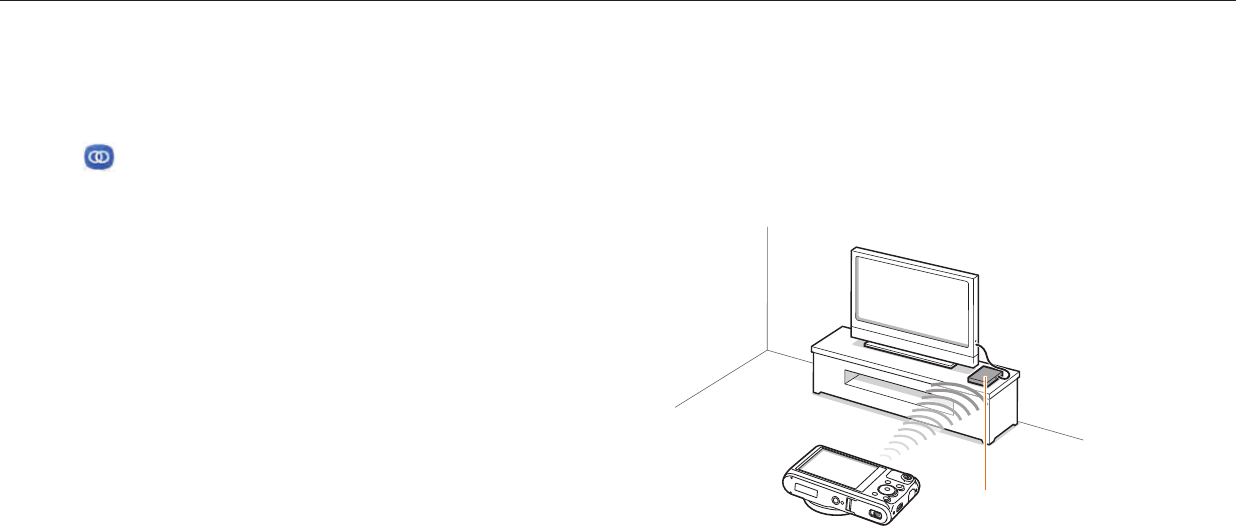
Using AllShare Play to send les
Wireless network
127
Viewing photos or videos on devices that support Samsung
Link
1 Rotate the mode dial to
w
.
2 Select → Nearby devices.
If the guide message appears, select OK.
The camera will automatically attempt to connect to a WLAN via the most
recently connected AP device.
If the camera has not previously been connected to a WLAN, it will search for
available AP devices. (p. 111)
You can set to allow only selected devices or all devices to connect by
pressing [
m
], and then selecting DLNA Access Control on the screen.
A sharing le list is created. Wait until other devices can nd your camera.
3 Connect the AllShare Play device to a network, and then turn on the
AllShare Play feature.
Refer to your device's user manual for more information.
4 On the camera, allow the AllShare Play device to connect to your
camera.
5 On the AllShare Play device, select a camera to connect.
6 On the AllShare Play device, browse the shared photos or videos.
For information about searching for the camera and browsing the photos or
videos on the AllShare Play device, refer to the device's user manual.
Videos may not play smoothly depending on the type of AllShare Play device
or the network condition. If this happens, re-record the video in 640 X 480
or smaller quality and play it again. If videos do not play smoothly on your
device over the wireless connection, try connecting the camera to the device
with an A/V cable.
AP
Ÿ
A camera is connected to a TV that supports AllShare Play via WLAN.

Using AllShare Play to send les
Wireless network
128
Depending on the number of photos or videos you want to share, it may take
some time to load your photos or videos and complete the initial set-up process.
While viewing photos or videos on the AllShare Play device, continuously using
the device's remote or performing additional operations on the device may
prevent this feature from working properly.
If you reorder or sort les on the camera while viewing them on an AllShare Play
device, you must repeat the initial set-up process to update the list of les on the
device.
When there are no les in the camera memory, you cannot use this feature.
We recommend you use a network cable to connect your AllShare Play device
to your AP. This will minimize any video ‘Stuttering’ you may experience when
streaming content.
To view les on an AllShare Play device using the Nearby devices feature,
enable multicast mode on your AP
You can share up to 1,000 recent les.
On an AllShare Play device, you can view only photos or videos captured with
your camera.
The range of the wireless connection between your camera and an AllShare Play
device may vary depending on the specications of the AP.
If the camera is connected to 2 AllShare Play devices, playback may be slower.
Photos or videos will be shared in their original sizes.
You can use this feature only with devices that support AllShare Play.
Shared photos or videos will not be stored on the AllShare Play device, but they
can be stored in the camera to meet the device's specications.
Transferring photos or videos to the AllShare Play device may take some time
depending on the network connection, the number of les to be shared, or the
sizes of the les.
If you power o the camera abnormally while viewing photos or videos on an
AllShare Play device (for example, by removing the battery), the device considers
the camera to still be connected.
The order of photos or videos on the camera may be dierent than on the
AllShare Play device.
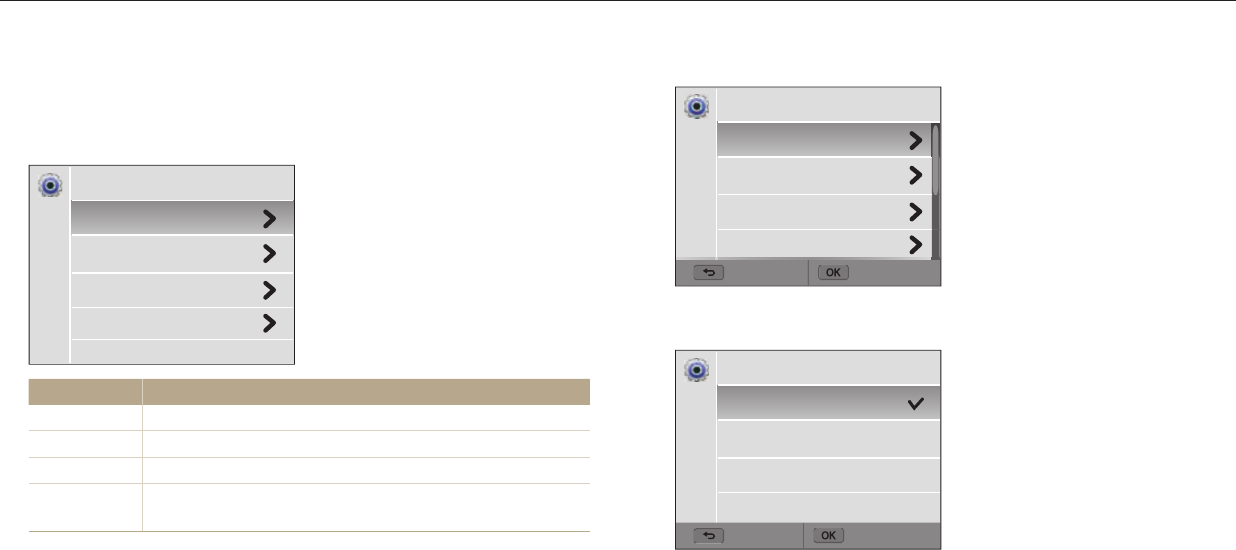
Settings
130
Settings menu
Learn to congure your camera's settings.
3 Select an item.
Back Select
Medium
On
Sound 1
O
Sound
Volume
Beep Sound
Shutter Sound
Start Sound
4 Select an option.
Back Set
Volume
O
Low
Medium
High
5 Press [
b
] to return to the previous screen.
Accessing the settings menu
1 Rotate the mode dial to
n
.
2 Select a menu.
Sound
Display
Connectivity
General
Settings
Option Description
Sound Set various camera sounds and the volume. (p. 131)
Display Customize the display settings. (p. 131)
Connectivity Set the connection options. (p. 132)
General Change the settings for the camera system such as memory
format and default le name. (p. 133)

Settings menu
Settings
131
Sound
* Default
Item Description
Volume Set the volume of all sounds. (O, Low, Medium*, High)
Beep Sound Set the sound the camera emits when you press the buttons,
switch modes, or touch the screen on or o. (O, On*)
Shutter
Sound
Set the sound the camera emits when you press the shutter
button. (O, Sound 1*, Sound 2, Sound 3)
AF Sound Set the sound the camera emits when you half-press the shutter
button on or o. (O, On*)
Display
* Default
Item Description
Start Image
Set a start image to display when the camera turns on.
O*: Display no start image.
Logo: Display a default image stored in the internal memory.
Guide Line Select a guide to help you compose a scene.
(O*, 3 X 3, 2 X 2, Cross, Diagonal)
Date/Time
Display
Set whether or not to display the date and time on the camera's
display. (O*, On)
Help Guide
Display Display a brief description of an option or menu. (O, On*)
Display
Brightness
Adjust the brightness of the screen.
(Auto*, Dark, Normal, Bright)
Normal is xed in Playback mode even if you have selected
Auto.

Settings menu
Settings
132
* Default
Item Description
Quick View
Set whether or not to review a captured image before returning
to the Shooting mode. (O, On*)
This feature does not work in some modes.
Power Save
If you perform no operations for 30 seconds, the camera
automatically switches to Power save mode. (O*, On)
In Power save mode, press any button other than [
X
] to resume
using the camera.
Connectivity
* Default
Item Description
Anynet+
(HDMI-CEC)
Turn on to control the camera with a TV remote control when you
connect it to an HDTV that supports the Anynet+(CEC) prole.
O: View les without using an HDTV remote control.
On*: Control the camera with an HDTV remote control.
HDMI Size
Set the resolution of photos when the camera plays back les on an
HDTV via the HDMI cable.
(NTSC: 1080i*, 720p, 480p/ PAL: 1080i*, 720p, 576p)
If the HDTV does not support the selected resolution, the HDTV
automatically selects the next lower resolution.
Video Out
Set the video signal output for your region.
NTSC: USA, Canada, Japan, Korea, Taiwan, Mexico, etc
PAL (supports only BDGHI): Australia, Austria, Belgium, China,
Denmark, England, Finland, France, Germany, Italy, Kuwait,
Malaysia, Netherlands, New Zealand, Norway, Singapore, Spain,
Sweden, Switzerland, Thailand, etc
i-Launcher Set i-Launcher to launch automatically when you connect your
camera to your computer. (O, On*)

Settings menu
Settings
133
General
* Default
Item Description
Network
Information
View the Mac address and network certication number of
your camera.
Language Set a language for the display text.
Time Zone
Set the time zone for your location. When you travel to
another country, select Visit, and then select the appropriate
time zone. (Home*, Visit)
Date/Time Set Set the date and time.
Date Type
Set a date format. (YYYY/MM/DD, MM/DD/YYYY,
DD/MM/YYYY)
The default date type may dier depending on the
language selected.
Time Type
Set the time format. (12 Hr, 24 Hr)
The default time type may dier depending on the
language selected.
* Default
Item Description
File No.
Specify how to name les.
Reset: Set the le number to start from 0001 when you
insert a new memory card, format a memory card, or
delete all les.
Series*: Set the le number to resume from the previous
le number when you insert a new memory card, format a
memory card, or delete all les.
The default name of the rst folder is 100PHOTO and the
default name of the rst le is SAM_0001.
The le number increases by one, from SAM_0001 to
SAM_9999, each time you capture a photo or record a
video.
The folder number increases by one, from 100PHOTO to
999PHOTO, each time a folder is full.
The maximum number of les that can be stored in one
folder is 9,999.
The camera denes le names according to the Design
rule for Camera File system (DCF) standard. If you
intentionally change le names, the camera may not play
back the les.

Settings menu
Settings
134
* Default
Item Description
Imprint
Set whether or not to display the date and time on captured
photos. (O*, Date, Date & Time)
The date and time will be displayed on the bottom right
corner of the photo.
Some printer models may not print the date and time
properly.
The photo will not display the date and time if:
-
you select
i
mode
-
you select Panorama in
s
mode
-
you select My Magic Frame or Motion Photo in
g
mode
Auto Power O
Set the camera to automatically turn o when you perform
no operations for a specied period.
(O, 1 min, 3 min*, 5 min, 10 min)
Your settings will not change when you replace the
battery.
The camera will not automatically turn o when the
camera is connected to a computer, or WLAN, and when
you are playing a slide show or videos.
DIRECT LINK (Wi-Fi
Button)
Start a preset Wi-Fi function by pressing [DIRECT LINK].
(AutoShare*, MobileLink, Remote Viewnder, Baby
Monitoring, Auto Backup, Email, SNS & Cloud, Samsung
Link)
* Default
Item Description
AF Lamp Set a light to automatically turn on in dark places to help you
focus. (O, On*)
Format
Format the memory. Formatting will delete all les, including
protected les. (Yes , No)
Errors can occur if you use a memory card formatted by
another brand of camera, a memory card reader, or a
computer. Please format memory cards in the camera
before using them to capture photos.
Reset Reset menus and shooting options. Date, time, language,
and video output settings will not be reset. (Yes, No)
Open Source
Licenses View open source licenses.

Error messages
…………………………………………………… 136
Camera maintenance
…………………………………………… 138
Cleaning your camera
……………………………………… 138
Using or storing the camera
………………………………… 139
About memory cards
………………………………………… 140
About the battery
…………………………………………… 143
Before contacting a service center
…………………………… 147
Camera specications
…………………………………………… 150
Glossary
………………………………………………………… 154
Index
……………………………………………………………… 159
Appendixes
Get information about error messages, specications, and maintenance.

Appendixes
136
Error messages
When the following error messages appear, try these remedies.
Error message Suggested remedies
Device disconnected. Network connection disconnected while transferring
photos. Reselect a device that supports AllShare Play.
File Error Delete the damaged le or contact a service center.
File system not
supported.
Your camera does not support the FAT le structure of
the inserted memory card. Format the memory card on
the camera.
Initialization failed.
The camera has failed to locate a device that supports
AllShare Play. Turn on devices on the network that
support AllShare Play.
Password Incorrect The password for transferring les to another camera is
wrong. Enter the correct password.
Low Battery Insert a charged battery or recharge the battery.
Memory Full Delete unnecessary les or insert a new memory card.
Error message Suggested remedies
Card Error
Turn o your camera, and then turn it on again.
Remove your memory card, and then insert it again.
Format your memory card.
Card not supported.
The inserted memory card is not supported by your
camera. Insert a microSD, microSDHC, or microSDXC
memory card.
Connection failed.
The camera cannot connect to the network using the
selected access point. Select another AP and try again.
The camera has failed to connect to the other devices.
Try connecting again.
DCF Full Error
File names do not match the DCF standard. Transfer the
les from the memory card to your computer and format
the card. Then, open the Settings menu and select File
No. → Reset. (p. 133)

Error messages
Appendixes
137
Error message Suggested remedies
No Image File Capture photos or insert a memory card that contains
some photos.
Photo transfer failed. Network connection disconnected while transferring
photos. Try restarting the AllShare Play feature.
Transfer failed.
The camera has failed to send a photo to the other
camera. Try sending again.
The camera has failed to send an email or transfer a
photo to a device that supports AllShare Play. Check
the network connection and try again.
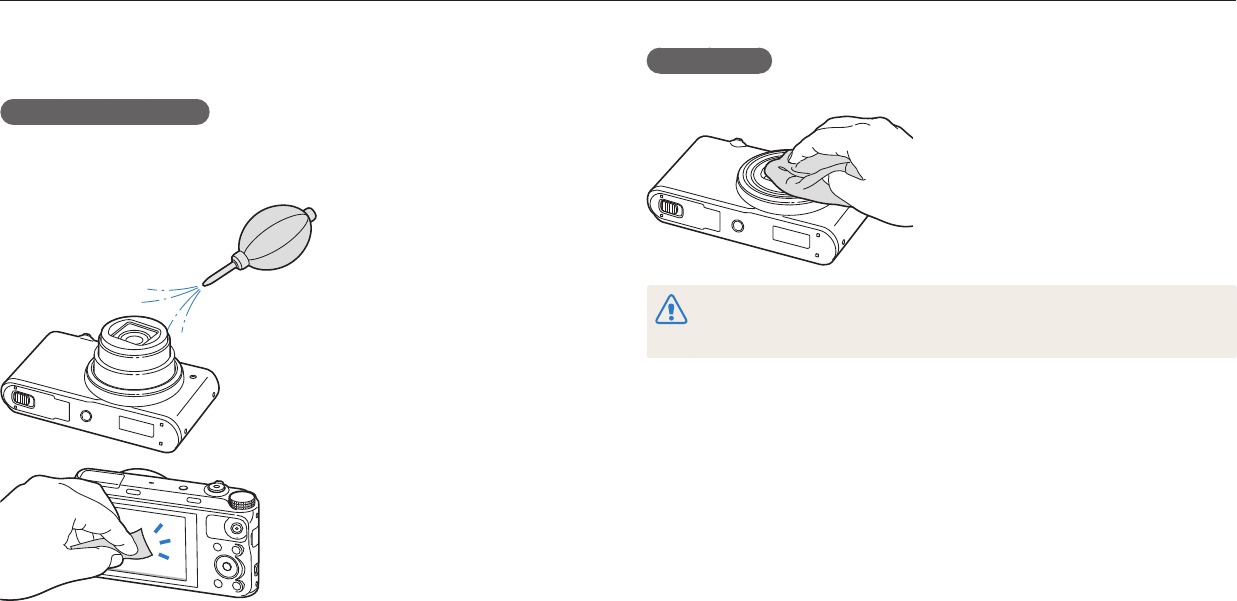
Appendixes
138
Camera maintenance
Camera body
Wipe gently with a soft, dry cloth.
Never use benzene, thinners, or alcohol to clean the device. These solutions can
damage the camera or cause it to malfunction.
Do not press on the lens cover or use a blower brush on the lens cover.
Cleaning your camera
Camera lens and display
Use a blower brush to remove dust and wipe the lens gently with a soft cloth. If any
dust remains, apply lens cleaning liquid to a piece of lens cleaning paper and wipe
gently.

Camera maintenance
Appendixes
139
Using or storing the camera
Inappropriate places to use or store the camera
Avoid exposing the camera to very cold or very hot temperatures.
Avoid using your camera in areas with extremely high humidity, or where the
humidity changes drastically.
Avoid exposing the camera to direct sunlight and storing it in hot, poorly-
ventilated areas, such as in a car during summer time.
Protect your camera and the display from impact, rough handling, and excessive
vibration to avoid serious damage.
Avoid using or storing your camera in dusty, dirty, humid, or poorly-ventilated
areas to prevent damage to moving parts and internal components.
Do not use your camera near fuels, combustibles, or ammable chemicals. Do
not store or carry ammable liquids, gases, or explosive materials in the same
compartment as the camera or its accessories.
Do not store the camera where there are mothballs.
Using on beaches or shores
Protect your camera from sand and dirt when you use it on beaches or in similar
areas.
Your camera is not waterproof. Do not handle the battery, adapter, or memory
card with wet hands. Operating the camera with wet hands may cause damage to
your camera.
Storing for extended period of time
When you store the camera for an extended period, place it in a sealed container
with an absorbent material, such as silica gel.
Over time, unused batteries will discharge and must be recharged before use.
You must reset the date and time when you turn the camera on after the camera
and battery have been separated for a prolonged period.
Using the camera with caution in humid environments
When you transfer the camera from a cold environment to a warm one,
condensation can form on the lens or internal components of the camera. In this
situation, turn o the camera and wait for at least 1 hour. If condensation forms
on the memory card, remove the memory card from the camera and wait until all
moisture has evaporated before reinserting it.
Other cautions
Do not swing your camera by the strap. This may cause injury to yourself or others
or damage to your camera.
Do not paint your camera, as paint can clog moving parts and prevent proper
operation.
Turn o the camera when not using it.

Camera maintenance
Appendixes
140
Your camera contains delicate parts. Avoid impacts to the camera.
Protect the display from external force by keeping it in the case when not in
use. Protect the camera from scratches by keeping it away from sand, sharp
implements, or loose change.
Do not use the camera if the screen is cracked or broken. Broken glass or acrylic
could cause injury to your hands and face. Take the camera to a Samsung service
center to have it repaired.
Never place cameras, batteries, chargers, or accessories near, on, or in heating
devices, such as microwave ovens, stoves, or radiators. These devices may be
deformed and can overheat and cause a re or explosion.
Do not expose the lens to direct sunlight, as this may discolor the image sensor or
cause it to malfunction.
Protect the lens from ngerprints and scratches. Clean the lens with a soft, clean,
debris-free lens cloth.
The camera may turn o if struck or dropped. This is to protect the memory card.
Turn on the camera to use it again.
While you use the camera, it may heat up. This is normal and should not aect
your camera’s lifespan or performance.
When you use the camera in low temperatures, it may take some time to turn on,
the color of the display may be changed temporarily, or after-images may appear.
These conditions are not malfunctions and they will correct themselves when the
camera is returned to milder temperatures.
Paint or metal on the outside of the camera may cause allergies, itchy skin,
eczema, or swelling for people with sensitive skin. If you experience any of these
symptoms, stop using the camera immediately and consult a doctor.
Do not insert foreign objects into any of your camera’s compartments, slots, or
access points. Damage due to improper use may not be covered by your warranty.
Do not allow unqualied personnel to service the camera or attempt to service
the camera yourself. Any damage that results from unqualied service is not
covered by your warranty.
About memory cards
Supported memory cards
Your camera supports microSD (Secure Digital), microSDHC (Secure Digital High
Capacity), or microSDXC (Secure Digital eXtended Capacity) memory cards.
Memory card
Memory card adapter
To read data with a PC or memory card reader, insert the memory card into a
memory card adapter.
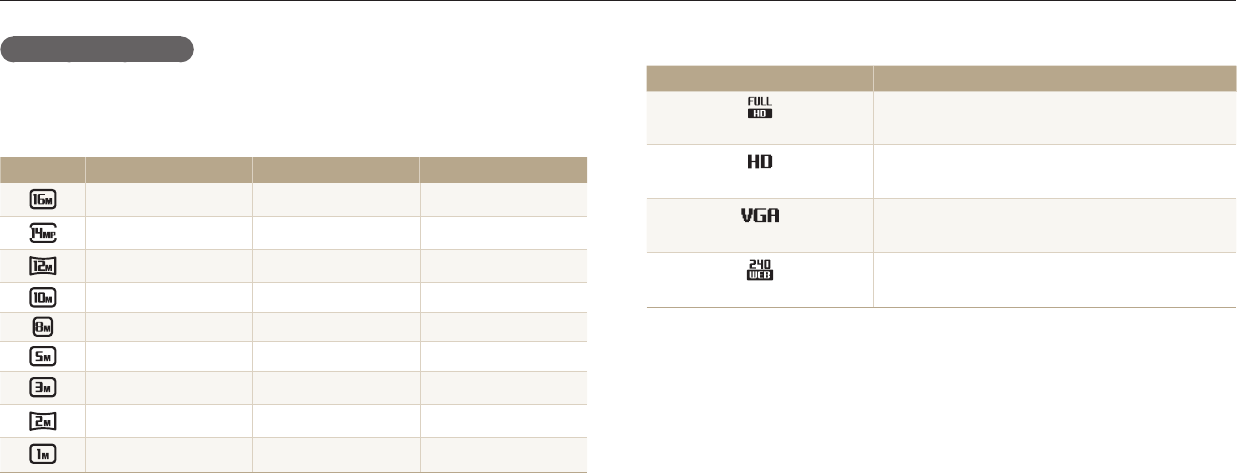
Camera maintenance
Appendixes
141
Memory card capacity
The memory capacity may dier depending on the scenes you shoot or shooting
conditions. These capacities are based on a 2 GB microSD card:
Photo
Size Super Fine Fine Normal
219 432 640
245 483 715
288 567 836
341 669 984
418 817 1,196
638 1,228 1,777
1,006 1,897 2,692
1,329 2,461 3,437
2,508 4,359 5,780
Video
Size 30 fps
1920 X 1080 Approx. 18' 03"
1280 X 720 Approx. 25' 53"
640 X 480 Approx. 46' 12"
For Sharing
Approx. 257' 31"
The gures above are measured without using the zoom function. Available recording time
may vary if you use the zoom. Several videos were recorded in succession to determine the
total recording time.

Camera maintenance
Appendixes
142
Cautions when using memory cards
Avoid exposing memory cards to very cold or very hot temperatures (below
0 °C/32 °F or above 40 °C/104 °F). Extreme temperatures can cause memory cards
to malfunction.
Insert a memory card in the correct direction. Inserting a memory card in the
wrong direction may damage your camera and memory card.
Do not use memory cards that have been formatted by other cameras or by a
computer. Reformat the memory card with your camera.
Turn o the camera before you insert or remove the memory card.
Do not remove the memory card or turn o your camera while the lamp is
blinking, as this may damage your data.
When the lifespan of a memory card has expired, you cannot store any more
photos on the card. Use a new memory card.
Do not bend, drop, or subject memory cards to heavy impact or pressure.
Avoid using or storing memory cards near strong magnetic elds.
Avoid using or keeping memory cards in areas with high temperatures, high
humidity, or corrosive substances.
Prevent memory cards from making contact with liquids, dirt, or foreign
substances. If dirty, wipe the memory card clean with a soft cloth before you
insert the memory card into your camera.
Do not allow liquids, dirt, or foreign substances to come in contact with memory
cards or the memory card slot. Doing so may cause memory cards or the camera
to malfunction.
When you carry a memory card, use a case to protect the card from electrostatic
discharges.
Transfer important data to other media, such as a hard disk, CD, or DVD.
When you use the camera for an extended period, the memory card may become
warm. This is normal and does not indicate a malfunction.
The manufacturer is not responsible for any loss of data.

Camera maintenance
Appendixes
143
About the battery
Use only Samsung-approved batteries.
Battery specications
Specication Description
Model SLB-10A
Type Lithium-ion battery
Cell capacity 1,030 mAh
Voltage 3.7 V
Charging time* (when the camera is
switched o) Approximately 240 min
* Charging the battery by connecting it to a computer may take longer.
Battery life
Average shooting time/
Number of photos
Test conditions
(when the battery is fully charged)
Photos
Approximately
140 min/
Approximately
280 photos
The battery life was measured under the
following conditions: in
p
mode, in darkness,
resolution, Fine quality, OIS on.
1. Set the ash option to Fill in, take a single shot,
and zoom in or out.
2. Set the ash option to O, take a single shot,
and zoom in or out.
3. Perform steps 1 and 2, waiting 30 seconds
between each step. Repeat the process for
5 minutes, and then turn o the camera for
1 minute.
4. Repeat steps 1 to 3.
Videos Approximately
100 min Record videos at resolution and 30 fps.
The gures above are measured by Samsung’s standards. Your results may dier,
depending on your actual usage.
Several videos were recorded in succession to determine the total recording time.
When using network functions, the battery will be depleted more quickly.

Camera maintenance
Appendixes
144
Low battery message
When the battery has fully discharged, the battery icon will turn red and the
"Low Battery" message will appear.
Notes about using the battery
Avoid exposing batteries to very cold or very hot temperatures (below 0 °C/32 °F
or above 40 °C/104 °F). Extreme temperatures can reduce the charging capacity of
your batteries.
When you use the camera for an extended period, the area around the battery
chamber may become warm. This does not aect the normal use of the camera.
Do not pull the power supply cord to disconnect the plug from the power outlet,
as this may cause a re or electric shock.
In temperatures below 0 °C/32 °F, battery capacity and battery life may decrease.
Battery capacity may decrease in low temperatures, but will return to normal in
milder temperatures.
Remove the batteries from your camera when storing it for an extended period.
Installed batteries may leak or corrode over time and cause serious damage
to your camera. Storing the camera for extended periods with the battery
installed causes the battery to discharge. You may not be able to recharge a fully
discharged battery.
When you do not use the camera for an extended period (3 months or more),
check the battery and recharge it regularly. If you let the battery discharge
continually, its capacity and life may decrease, which can lead to a malfunction,
re, or explosion.
Cautions about using the battery
Protect batteries, chargers, and memory cards from damage.
Prevent batteries from making contact with metal objects, as this can create a
connection between the + and – terminals of your battery and lead to temporary or
permanent battery damage and may cause a re or electric shock.
Notes about charging the battery
If the status lamp is o, make sure that the battery is inserted correctly.
If the camera is on while charging, the battery may not fully charge. Turn o the
camera before charging the battery.
Do not use your camera when you are charging the battery. This may cause a re
or electric shock.
Do not pull the power supply cord to disconnect the plug from the power outlet,
as this may cause a re or electric shock.
Let the battery charge for at least 10 minutes before turning on the camera.
If you connect the camera to an external power source when the battery is
depleted, using high energy-consuming functions will cause the camera to turn
o. To use the camera normally, recharge the battery.

Camera maintenance
Appendixes
145
If you reconnect the power cable when the battery is fully charged, the status
lamp turns on for approximately 30 minutes.
Using the ash or recording videos depletes the battery quickly. Charge the
battery until the red status lamp turns o.
If the status lamp blinks in red, reconnect the cable, or remove the battery and
insert it again.
If you charge the battery when the cable is overheated or the temperature is too
high, the status lamp may blink in red. Charging will start when the battery cools
down.
Overcharging batteries may shorten battery life. After charging is nished,
disconnect the cable from your camera.
Do not bend or place heavy objects on the AC cable. Doing so may damage the
cable.
Notes about charging with a computer connected
Use only the provided USB cable.
The battery may not charge when:
-
you use a USB hub
-
other USB devices are connected to your computer
-
you connect the cable to the port on the front side of your computer
-
the USB port of your computer does not support the power output standard (5
V, 500 mA)
Handle and dispose of batteries and chargers with care
Never dispose of batteries in a re. Follow all local regulations when you dispose
of used batteries.
Never place batteries or cameras on or in heating devices, such as microwave
ovens, stoves, or radiators. Batteries may explode when they are overheated.

Camera maintenance
Appendixes
146
Personal injury or death can occur if the battery is handled carelessly
or improperly. For your safety, follow these instructions for proper
battery handling:
The battery can ignite or explode if not handled properly.
If you notice any deformities, cracks, or other abnormalities in the
battery, immediately discontinue use of the battery and contact a
service center.
Use only authentic, manufacturer-recommend battery chargers and
adapters and charge the battery only by the methods described in this
user manual.
Do not place the battery near heating devices or expose it to
excessively warm environments, such as the inside of an enclosed car in
the summertime.
Do not place the battery in a microwave oven.
Avoid storing or using the battery in hot, humid places, such as spas or
shower enclosures.
Do not rest the camera on ammable surfaces, such as bedding,
carpets, or electric blankets for a prolonged period.
When the camera is switched on, do not leave it in any conned space
for a prolonged period.
Do not allow battery terminals to come in contact with metallic objects,
such as necklaces, coins, keys, or watches.
Use only authentic, manufacturer-recommended, Lithium-ion
replacement batteries.
Do not disassemble the battery or puncture it with any sharp object.
Avoid exposing the battery to high pressure or crushing forces.
Avoid exposing the battery to major impacts, such as dropping it from
high places.
Do not expose the battery to temperatures of 60 °C (140 °F) or above.
Do not allow the battery to come in contact with moisture or liquids.
Do not expose the battery to sources of excessive heat such as
sunshine, re or the like.
Disposal guidelines
Dispose of the battery with care.
Do not dispose of the battery in a re.
Disposal regulations may dier by country or region. Dispose of the
battery in accordance with all local and federal regulations.
Guidelines for charging the battery
Charge the battery only by the methods described in this user manual.
The battery can ignite or explode if not charged properly.

Appendixes
147
Before contacting a service center
If you are having trouble with your camera, try these troubleshooting procedures before you contact a service center. If you have attempted the suggested remedy and are still
having problems with your device, contact your local dealer or service center.
When you leave your camera at a service center, be sure to also leave the other components that may have contributed to the malfunction, such as the memory card and battery.
Situation Suggested remedies
Cannot capture photos
There is no space on the memory card. Delete
unnecessary les or insert a new card.
Format the memory card.
The memory card is defective. Get a new
memory card.
Make sure that the camera is switched on.
Charge the battery.
Make sure that the battery is inserted correctly.
The camera freezes Remove the battery and insert it again.
The camera heats up
While you use the camera, it may heat up. This
is normal and should not aect your camera’s
lifespan or performance.
The ash does not work
The ash option may be set to O. (p. 67)
You cannot use the ash in some modes.
The ash res unexpectedly The ash may re due to static electricity. The
camera is not malfunctioning.
Situation Suggested remedies
Cannot turn on the camera
Ensure that the battery is inserted.
Ensure that the battery is inserted correctly.
(p. 24)
Charge the battery.
The power turns o suddenly
Charge the battery.
Your camera may be in Auto Power O mode.
(p. 134)
The camera may turn o to prevent the
memory card from being damaged due to an
impact. Turn on your camera again.
The camera is losing battery
power quickly
The battery may lose power more quickly in
low temperatures (below 0 °C/32 °F). Keep the
battery warm by putting it into your pocket.
Using the ash or recording videos depletes the
battery quickly. Recharge if needed.
Batteries are consumable parts that must be
replaced over time. Get a new battery if the
battery life is diminishing quickly.

Before contacting a service center
Appendixes
148
Situation Suggested remedies
The date and time are
incorrect
Set the date and time in the display settings.
(p. 133)
The display or buttons do not
work Remove the battery, and then insert it again.
The camera display responds
poorly
If you use your camera at very low temperatures,
it may cause the camera screen to malfunction
or discolor. For better performance of your
camera screen, use your camera in moderate
temperatures.
The memory card has an error
Turn o your camera, and then turn it on again.
Remove your memory card, and then insert it
again.
Format your memory card.
See “Cautions when using memory cards” for
more detail. (p. 142)
Cannot play back les
If you change the name of a le, your camera may
not play the le (the name of the le should meet
the DCF standard). If you encounter this situation,
play back the les on your computer.
Situation Suggested remedies
The photo is blurry
Make sure that the focus option you set is
suitable for close-up shots. (p. 70)
Make sure that the lens is clean. If not, clean the
lens. (p. 138)
Make sure that the subject is within range of
the ash. (p. 151)
The colors in the photo do not
match the actual scene
An incorrect White Balance can create unrealistic
color. Select the proper White Balance option to
suit the light source. (p. 79)
The photo is too bright
Your photo is overexposed.
Turn o the ash. (p. 67)
Adjust the ISO sensitivity. (p. 69)
Adjust the exposure value. (p. 77)
The photo is too dark
Your photo is underexposed.
Turn on the ash. (p. 67)
Adjust the ISO sensitivity. (p. 69)
Adjust the exposure value. (p. 77)

Before contacting a service center
Appendixes
149
Situation Suggested remedies
The TV does not display your
photos
Make sure that the camera is correctly
connected to the TV with the A/V cable.
Make sure that your memory card contains
photos.
Your computer does not
recognize your camera
Make sure that the USB cable is connected
correctly.
Make sure that your camera is switched on.
Make sure that you are using a supported
operating system.
Your computer disconnects
the camera while transferring
les
The le transmission may be interrupted by static
electricity. Disconnect the USB cable and connect
it again.
Your computer cannot play
videos
Videos may not play on some video player
programs. To play video les captured with your
camera, use the Multimedia Viewer program that
you can install with the i-Launcher program on
your computer.
Situation Suggested remedies
i-Launcher is not functioning
properly
End i-Launcher and restart the program.
Make sure that i-Launcher is set to On in the
settings menu. (p. 132)
Depending on your computer's specications
and environment, the program may not launch
automatically. In this case, click Start →
All Programs → Samsung → i-Launcher →
Samsung i-Launcher on your Windows
computer. (For Windows 8, open Start
screen, and then select All apps → Samsung
i-Launcher.) Or, click Applications → Samsung
→ i-Launcher on your Mac OS computer.
Your TV or computer cannot
display photos and videos
that are stored on an
microSDXC memory card.
microSDXC memory cards use the exFAT le
system. Ensure that the external device is
compatible with the exFAT le system before
connecting the camera to the device.
Your computer does not
recognize an microSDXC
memory card.
microSDXC memory cards use the exFAT le
system. To use microSDXC memory cards on a
Windows XP computer, download and update
the exFAT le system driver from the Microsoft
website.

Appendixes
150
Image sensor
Type 1/2.3" (Approximately 7.76 mm) BSI CMOS
Eective pixels Approximately 16.3 mega-pixels
Total pixels Approximately 17.0 mega-pixels
Lens
Focal length Samsung Lens f = 4.1–86.1 mm
(35 mm lm equivalent: 23–483 mm)
F-stop range F2.8(W)–F5.9(T)
Zoom
Still image mode: 1.0–21.0X
(Optical zoom X Digital zoom: 105.0X,
Optical zoom X Intelli zoom: 42.0X)
Playback mode: 1.0–9.4X (depending on image size)
Display
Type TFT LCD
Feature 3.0" (75.0 mm) 460K
Focusing
Type
TTL auto focus (Center AF, Multi AF, Tracking AF,
Face Detection AF, Selection AF), Manual Focus, Video
continuous auto focus
Range
Wide (W) Tele (T)
Normal (AF) 31 in. (
80
cm)-
innity
138 in. (
350
cm)-
innity
Macro 4-31 in. (
10–80
cm) 59-138 in.
(
150–350
cm)
Auto Macro 4 in. (
10
cm)-innity 59 in. (
150
cm)-
innity
Manual Focus 4 in. (
10
cm)-innity 59 in. (
150
cm)-
innity
Shutter speed
Auto: 1/8–1/2,000 sec.
Program: 1–1/2,000 sec.
Night: 8–1/2,000 sec.
Manual: 16–1/2,000 sec.
Exposure
Control Program AE, Aperture Priority AE, Shutter Priority AE,
Manual Exposure
Metering Multi, Spot, Center-weighted, Face Detection
Compensation ±2EV (1/3 EV Step)
ISO equivalent Auto, ISO 100, ISO 200, ISO 400, ISO 800, ISO 1600, ISO 3200
Camera specications

Camera specications
Appendixes
151
Flash
Mode Auto, Red-eye, Fill in, Slow Sync, O, Red-eye Fix
Range
Wide: 11.81-157.48 in. (0.3–4.1 m) (ISO Auto)
Tele: 19.69-74.80 in. (0.5–2.9 m) (ISO Auto)
Recharging time Approximately 4 sec.
Shake reduction
Optical Image Stabilization (OIS)
Eect
Photo Shooting
mode
Photo Filter (Smart Filter): Miniature, Vignetting, Ink Painting,
Oil Painting, Cartoon, Cross Filter, Sketch, Soft Focus,
Fish-eye, Classic, Retro, Zooming Shot
Image Adjust: Sharpness, Contrast, Saturation
Video Shooting
mode
Movie Filter (Smart Filter): Miniature, Vignetting, Sketch,
Fish-eye, Classic, Retro, Palette Eect 1, Palette Eect 2,
Palette Eect 3, Palette Eect 4
White Balance
Auto WB, Daylight, Cloudy, Fluorescent_H, Fluorescent_L, Tungsten, Custom Set,
Color Temp.
Date Imprinting
Date & Time, Date, O
Shooting
Photos
Modes: Smart Auto (Portrait, Night Portrait, Backlight
Portrait, Night, Backlight, Landscape, White, Natural Green,
Blue Sky, Sunset, Macro, Macro text, Macro Color, Tripod,
Action, Fireworks, Candle, Spotlight, Spotlight (Macro),
Spotlight (Portrait)), Program, Aperture Priority,
Shutter Priority, Manual, Smart (Beauty Face,
Continuous Shot, Landscape, Macro, Action Freeze,
Rich Tones, Panorama, Waterfall, Silhouette, Sunset,
Low Light Shot, Fireworks, Light Trace), Best Face, Magic Plus
(My Magic Frame, Motion Photo, Photo Filter, Eect Artist,
Color Brush)
Burst: Single, Continuous (3 fps), Continuous (7.1 fps),
AE Bracket
Timer: O, 10 Sec, 2 Sec
Videos
Modes: Smart Scene Detection (Landscape, Blue Sky,
Natural Green, Sunset), Magic Plus (Movie Filter)
Format: MP4 (H.264) (Max recording time: 20 min)
Size: 1920 X 1080, 1280 X 720, 640 X 480, 240 Web
Frame Rate: 30 fps
Sound Alive: Sound Alive On, Sound Alive O
Capturing during recording
OIS: On, O
Video editing (embedded): Pause during recording,
Still image capture

Camera specications
Appendixes
152
Playback
Photos
Type: Single image, Thumbnails, Multi Slide Show with Music
and Eect, Movie clip
Edit: Resize, Rotate, Smart Filter, Crop
Eect: Image Adjust (Brightness, Contrast, Saturation, ACB,
Face Retouch, Red-eye Fix), Smart Filter (O, Miniature,
Vignetting, Ink Painting, Oil Painting, Cartoon, Cross Filter,
Sketch, Soft Focus, Fish-eye, Classic, Retro, Zooming Shot)
Videos Edit: Still image capture, Time trimming
Storage
Media
Internal memory: Approximately 9.5 MB
External memory (Optional): microSD card (2 GB
guaranteed), microSDHC card (up to 32 GB guaranteed),
microSDXC card (up to 64 GB guaranteed)
Internal memory capacity may not match these specications.
File format
Still Image: JPEG (DCF), EXIF 2.21
Movie Clip: MP4 (Video: MPEG-4.AVC/H.264, Audio: AAC)
Image size
Icon Size
4608 X 3456
4608 X 3072
4608 X 2592
3648 X 2736
2832 X 2832
2592 X 1944
1984 X 1488
1920 X 1080
1024 X 768

Camera specications
Appendixes
153
Wireless network
MobileLink, Remote Viewnder, SNS & Cloud, Baby Monitoring, Email, S/W
Upgrade Notier, Auto Backup, Samsung Link
NFC
Yes
Interface
Digital output
connector USB 2.0
Audio input/
output Internal speaker (Mono), Microphone (Mono)
Video output A/V: NTSC, PAL (selectable)
DC power input
connector 5.0 V
Power source
Rechargeable
battery Lithium-ion battery (SLB-10A, 1,030 mAh)
Connector type Micro USB (5 pin)
The power source may dier depending on your region.
Dimensions (W X H X D)
4.47 X 2.56 X 0.96 in. (113.5 X 65 X 24.5 mm) (without protrusions)
Weight
X oz (XXX g) (without battery and memory card)
Operating Temperature
0–40 °C (32-104 °F)
Operating Humidity
5–85 %
Software
i-Launcher
Specications may change without notice to improve performance.

Appendixes
154
ACB (Auto Contrast Balance)
This feature automatically improves the contrast of your images when the subject is
backlit or when there is a high contrast between your subject and the background.
AEB (Auto Exposure Bracket)
This feature automatically captures several images at dierent exposures to help
you capture a properly-exposed image.
AF (Auto Focus)
A system that automatically focuses the camera lens on the subject. Your camera
uses the contrast to focus automatically.
Aperture
The aperture controls the amount of light that reaches the camera’s sensor.
Camera shake (Blur)
If the camera is moved while the shutter is open, the entire image may appear
blurred. This occurs more often when the shutter speed is slow. Prevent camera
shake by raising the sensitivity, using the ash, or using a faster shutter speed.
Alternately, use a tripod, the DIS or OIS function to stabilize the camera.
Composition
Composition in photography means arranging objects in a photo. Usually, abiding
by the rule of thirds leads to a good composition.
DCF (Design rule for Camera File system)
A specication to dene a le format and le system for digital cameras created by
the Japan Electronics and Information Technology Industries Association (JEITA).
Depth of eld
The distance between the nearest and farthest points that can be acceptably
focused in a photograph. Depth of eld varies with lens aperture, focal length, and
distance from the camera to the subject. Selecting a smaller aperture, for example,
will increase the depth of eld and blur the background of a composition.
Digital zoom
A feature that articially increases the amount of zoom available with a zoom lens
(Optical zoom). When using the Digital zoom, the image quality will deteriorate as
the magnication increases.
Glossary

Glossary
Appendixes
155
EV Compensation
All the combinations of the camera’s shutter speed and lens aperture that result in
the same exposure.
EV (Exposure Value)
This feature allows you to quickly adjust the exposure value measured by the
camera, in limited increments, to improve the exposure of your photos. Set the EV
compensation to -1.0 EV to adjust the value one step darker and 1.0 EV to one step
brighter.
Exif (Exchangeable Image File Format)
A specication to dene an image le format for digital cameras created by the
Japan Electronic Industries Development Association (JEIDA).
Exposure
The amount of light allowed to reach the camera’s sensor. Exposure is controlled by
a combination of the shutter speed, the aperture value, and ISO sensitivity.
Flash
A speed light that helps to create adequate exposure in low-light conditions.
Focal length
The distance from the middle of the lens to its focal point (in millimeters). Longer
focal lengths result in narrower angles of view and the subject is magnied. Shorter
focal lengths result in wider angles of view.
Histogram
A graphical representation of the brightness of an image. The horizontal axis
represents the brightness and the vertical axis represents the number of pixels. High
points at the left (too dark) and right (too bright) on the histogram indicate a photo
that is improperly exposed.
H.264/MPEG-4
A high-compression video format established by international standard
organizations ISO-IEC and ITU-T and developed by the Joint Video Team (JVT). This
codec is capable of providing good video quality at low bit rates.

Glossary
Appendixes
156
Image sensor
The physical part of a digital camera that contains a photosite for each pixel in
the image. Each photosite records the brightness of the light that strikes it during
an exposure. Common sensor types are CCD (Charge-coupled Device) and CMOS
(Complementary Metal Oxide Semiconductor).
ISO sensitivity
The sensitivity of the camera to light, based on the equivalent lm speed used in
a lm camera. At higher ISO sensitivity settings, the camera uses a higher shutter
speed, which can reduce blur caused by camera shake and low light. However,
images with high sensitivity are more susceptible to noise.
JPEG (Joint Photographic Experts Group)
A lossy method of compression for digital images. JPEG images are compressed to
reduce their overall le size with minimal deterioration of the image resolution.
LCD (Liquid Crystal Display)
A visual display commonly used in consumer electronics. This display needs a
separate backlight, such as CCFL or LED, to reproduce colors.
Macro
This feature allows you to capture close-up photos of very small objects. When
using the macro feature, the camera can maintain a sharp focus on small objects at
a near life-size ratio (1:1).
Metering
The metering refers to the way in which the camera measures the quantity of light
to set the exposure.
MJPEG (Motion JPEG)
A video format which is compressed as a JPEG image.
Noise
Misinterpreted pixels in a digital image that may appear as misplaced or random,
bright pixels. Noise usually occurs when photos are shot with a high sensitivity or
when a sensitivity is automatically set in a dark place.
OIS (Optical Image Stabilization)
This feature compensates in real-time for shaking and vibrating while shooting.
There is no image degradation compared to Digital Image Stabilization feature.

Glossary
Appendixes
157
Optical zoom
This is a general zoom which can enlarge images with a lens and does not degrade
the quality of images.
Quality
An expression of the rate of compression used in a digital image. Higher quality
images have a lower rate of compression, which usually results in a larger le size.
Resolution
The number of pixels present in a digital image. High resolution images contain
more pixels and typically show more detail than low resolution images.
Shutter speed
Shutter speed refers to the amount of time it takes to open and close the shutter,
and it is an important factor in the brightness of a photo, as it controls the amount
of light which passes through the aperture before it reaches the image sensor. A
fast shutter speed allows less time to let light in and the photo becomes darker and
more easily freezes subjects in motion.
Vignetting
A reduction of an image’s brightness or saturation at the periphery (outer edges)
compared to the center of the image. Vignetting can draw interest to subjects
positioned in the center of an image.
White balance (color balance)
An adjustment of the intensities of colors (typically the primary colors red, green,
and blue), in an image. The goal of adjusting the white balance, or color balance, is
to correctly render the colors in an image.

Appendixes
158
Correct Disposal of This Product
Waste Electrical & Electronic Equipment)
(Applicable in countries with separate collection systems)
This marking on the product, accessories or literature indicates that the product and
its electronic accessories (e.g. charger, headset, USB cable) should not be disposed
of with other household waste at the end of their working life. To prevent possible
harm to the environment or human health from uncontrolled waste disposal, please
separate these items from other types of waste and recycle them responsibly to
promote the sustainable reuse of material resources.
Household users should contact either the retailer where they purchased this
product, or their local government oce, for details of where and how they can take
these items for environmentally safe recycling.
Business users should contact their supplier and check the terms and conditions
of the purchase contract. This product and its electronic accessories should not be
mixed with other commercial wastes for disposal.
PlanetFirst represents Samsung Electronics' commitment to
sustainable development and social responsibility through eco-
driven business and management activities.
Correct disposal of batteries in this product
(Applicable in countries with separate collection systems)
This marking on the battery, manual or packaging indicates that the batteries in
this product should not be disposed of with other household waste at the end of
their working life. Where marked, the chemical symbols Hg, Cd or Pb indicate that
the battery contains mercury, cadmium or lead above the reference levels in EC
Directive 2006/66. If batteries are not properly disposed of, these substances can
cause harm to human health or the environment.
To protect natural resources and to promote material reuse, please separate
batteries from other types of waste and recycle them through your local, free
battery return system.

Appendixes
159
A
AF-assist light
Location
21
Settings
134
AF Sound
131
Anynet+
132
Aperture Priority mode
48
Aperture value
47
Auto Backup
119
Auto Contrast Balance (ACB)
Playback mode
98
Shooting mode
78
AutoShare
115
A/V port
21
B
Battery
Caution
144
Charging
25
Inserting
24
Best face mode
54
Brightness
Playback mode
98
Shooting mode
77
C
Camera maintenance
138
Camera specications
150
Capturing an image from video
95
Charging
25
Cleaning
Camera body
138
Display
138
Lens
138
Connecting to your Mac computer
102
Contrast
Playback mode
98
Shooting mode
84
D
Date/Time Set
133
Deleting les
90
Digital zoom
38
DIRECT LINK button
23
Disconnecting the camera
102
Display brightness
131
Display type
35
E
Editing photos
96
Editing videos
Capturing
95
Trimming
95
Enlarging
92
Error messages
136
Exposure
77
F
Face Detection
75
Flash
Auto
67
Fill in
67
O
67
Red-eye
67
Red-eye Fix
68
Slow Sync
68
Index

Appendixes
160
Focus area
Center AF
72
Multi AF
72
Formatting
134
Function button
23
G
Guide Line
131
H
Half-press shutter
41
I
Icons
Playback mode
87
Shooting mode
28
Image Adjustment
Brightness
Playback mode
99
Shooting mode
77
Contrast
Playback mode
99
Shooting mode
84
Red-eye
99
Saturation
Playback mode
99
Shooting mode
84
Sharpness
84
Imprint
134
Intelli zoom
39
ISO sensitivity
69
L
Language settings
133
M
Macro
Auto Macro
71
Macro
71
Manual Focus
71
Magic Plus mode
Motion Photo
57
Movie Filter
59
My Magic Frame
55
Photo Filter
58
Manual mode
50
Memory card
Caution
142
Insert
24
Menu button
23
Metering
Center-weighted
78
Multi
78
Spot
78
MobileLink
116
Mode dial
21
Movie mode
60
O
One touch shooting
74
Optical Image Stabilization (OIS)
40
Optional accessories
20
P
Panorama mode
52
Playback button
23
Playback mode
87
Index

Appendixes
161
Power button
21
Power save mode
132
Program mode
46
Protecting les
90
Q
Quick view
132
R
Red-eye
Playback mode
99
Shooting mode
66
Remote Viewnder
117
Reset
134
Resolution
Playback mode
96
Shooting mode
64
Retouching faces
99
Rotating
96
S
Samsung Link
126
Saturation
Playback mode
99
Shooting mode
84
Self portrait
75
Service center
147
Settings
133
Sharpness
84
Shooting portraits
Face Detection
75
Self portrait
75
Smile Shot
76
Shutter button
21
Shutter Priority mode
49
Slide show
93
Smart Auto mode
44
Smart Filter
Photo shooting mode
58
Playback mode
97
Video recording mode
59
Smart mode
51
Smart Scene Detection mode
61
Smile Shot
76
Sound settings
36
Start Image
131
Status lamp
22
T
Thumbnails
89
Timer
83
Time settings
26
Time zone settings
26
,
133
Touch screen
Dragging
33
Flicking
33
Touching
33
Tracking AF
73
Transferring les
Auto Backup
119
Email
121
Mac
102
Windows
101
Tripod mount
21
Index

Appendixes
162
U
Unpacking
20
USB port
21
V
Video
Playback mode
94
Shooting mode
60
Video out
132
Viewing les
Animated photos
93
Category
89
Folder
88
Panoramic photos
93
Slide show
93
Thumbnails
89
TV
100
W
Website
Accessing
124
Uploading photos or videos
124
White Balance
79
Wireless network
111
Z
Zoom
Using the zoom
38
Zoom button
22
Zoom sound settings
85
Index
FCC Notice
FCC ID: A3LWB380F
Caution:
Any changes or modifications in construction of this device which are not expressly approved by the party responsible for
compliance could void theuser's authority to operate the equipment.
NOTE:
This equipment has been tested and found to comply with the limits for a Class B digital device, pursuant to part 15 of the
FCC Rules. These limits are designed to provide reasonable protection against harmful interference in a residential
installation. This equipment generates, uses and can radiate radio frequency energy and, if not installed and used in
accordance with the instructions, may cause harmful interference to radio communications. However, there is no guarantee
that interference will not occur in a particular installation. If this equipment does cause harmful interference to radio or
television reception, which can be determined by turning the equipment off and on, the user is encouraged to try to correct
the interference by one or more of the following measures:
• Reorientate, or relocate, the receiving antenna.
• Increase the distance between the equipment and receiver.
• Connect the equipment into an outlet on a circuit different from that to
which the receiver is connected.
• Consult the dealer or an experienced radio/TV technician for help.
This device complies with part 15 of the FCC Rules. Operation is subject to the following two conditions: (1) This device
may not cause harmful interference, and (2) this device must accept any interference received, including interference
that may cause undesired operation.
FCC/IC RF Radiation Exposure Statement: This equipment complies with FCC RF Radiation exposure limits set forth for
an uncontrolled environment. This device and its antenna must not be co-located or operating in conjunction with any
other antenna or transmitter.
Caution:
Any changes or modifications to the equipment not expressly approved by the party responsible for compliance could void
user’s authority to operate the equipment.
IC: 649E-WB380F
This device complies with Industry Canada License-Exempt RSS standard (S)
Operation is subject to the following two conditions:
(1) This device may not cause harmful interference, and
(2) This device must accept any interference received,
including interference that may cause undesired operation.
Le présent appareil est conforme aux CNR d'Industrie Canada applicables aux appareils
radio exempts de licence. L'exploitation est autorisée aux deux conditions suivantes : (1) l'appareil ne doit pas produire de
brouillage, et (2) l'utilisateur de l'appareil doit accepter tout brouillage radioélectrique subi, même si le brouillage est
susceptible d'en compromettre le fonctionnement.
RF du FCC d'exposition aux radiations: Cet équipement est conforme à l'exposition
de la FCC rayonnements RF limites établies pour un environnement non contrôlé.
Cet appareil et son antenne ne doivent pas être co-localisés ou fonctionnant en
conjonction avec une autre antenne ou transmetteur.

Appendixes
150
Declaration of Conformity
and the Eco-Design Directive (2009/125/EC) implemented by
Regulations (EC) No 278/2009 for external power supplies.
Representative in the EU
Samsung Electronics Euro QA Lab.
Blackbushe Business Park
Saxony Way, Yateley, Hampshire
GU46 6GG, UK
(YEAR TO BEGIN AFFIXING CE MARKING 2011)
22 December, 2011
(Place and date of issue)
Joong-Hoon Choi / Lab. Manager
(Name and signature of authorized person)
* This is not the address of Samsung Service Centre. For the
address or the phone number of Samsung Service Centre, see
the warranty card or contact the retailer where you purchased
your product.
Product details
For the following
Product : DIGITAL
CAMERA Model(s) :
WB380F
Declaration & Applicable standards
We hereby declare that the product(s) above is(are) in
compliance with the essential requirements and other provisions
of the R&TTE Directive (1999/5/EC), the Low Voltage Directive
(2006/95/EC) and the Electromagnetic Compatibility Directive
(2004/108/EC) by application of:
EN 60950-1:2006+A1:2010 EN 55024:1998+A1:2001+A2:2003
EN 55022:2006+A1 :2007
EN 61000-3-2:2006 +A1:2009 +A2:2009
EN 61000-3-3:2008 EN 300 328 v1.7.1
EN 301 489-1 v1.8.1 EN 301 489-17 V2.1.1
EN62311 :2008
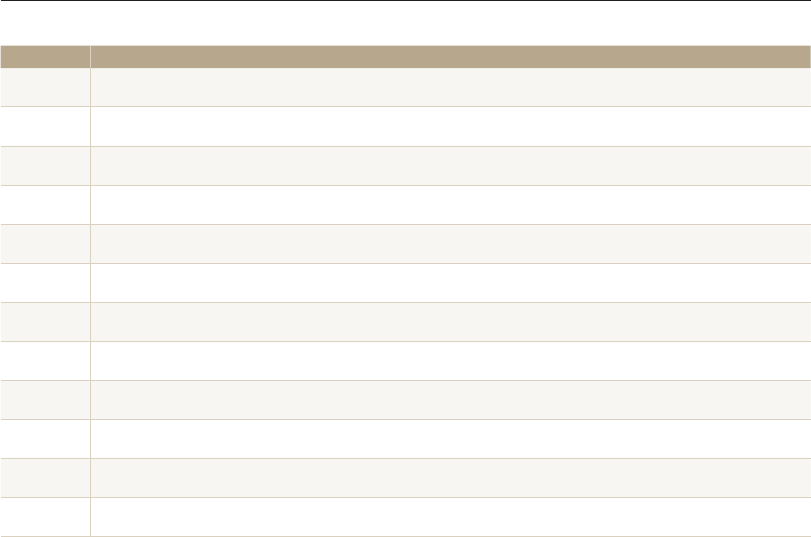
Appendixes
151
Declaration sentence in official languages
Nation Declaration
Cesky
Samsung Electronics tímto prohlašuje, že tento digitální fotoaparát je ve shodě se základními požadavky a dalšími
příslušnými ustanoveními směrnice 1999/5/ES.
Dansk Samsung Electronics erklærer herved, at digitale kameraer overholder de væsentlige krav og øvrige relevante krav i direktiv
1999/5/EF.
Deutsch Hiermit erklärt Samsung Electronic, dass sich die Digitalkamera in Übereinstimmung mit den grundlegenden Anforderungen und den
übrigen einschlägigen Bestimmungen der Richtlinie 1999/5/EG befindet.
Eesti Käesolevaga kinnitab Samsung Electronics digitaalkaamera vastavust direktiivi 1999/5/EÜ põhinõuetele ja nimetatud direktiivist
tulenevatele teistele asjakohastele sätetele.
English Hereby, Samsung Electronics declares that this digital camera is in compliance with the essential requirements and other relevant
provisions of Directive 1999/5/EC.
Español Por medio de la presente Samsung Electronics declara que la cámara digital cumple con los requisitos esenciales y cualesquiera
otras disposiciones aplicables o exigibles de la Directiva 1999/5/CE.
Ελληνική ΜΕ ΤΗΝ ΠΑΡΟΥΣΑ η Samsung Electronics ΔΗΛΩΝΕΙ ΟΤΙ η ψηφιακή φωτογραφική μηχανή ΣΥΜΜΟΡΦΩΝΕΤΑΙ ΠΡΟΣ ΤΙΣ
ΟΥΣΙΩΔΕΙΣ ΑΠΑΙΤΗΣΕΙΣ ΚΑΙ ΤΙΣ ΛΟΙΠΕΣ ΣΧΕΤΙΚΕΣ ΔΙΑΤΑΞΕΙΣ ΤΗΣ ΟΔΗΓΙΑΣ 1999/5/ΕΚ.
Français Par la présente Samsung Electronic déclare que l'appareil photo numérique est conforme aux exigences essentielles et aux autres
dispositions pertinentes de la directive 1999/5/CE.
Italiano Con la presente Samsung Electronicsdichiara che questa fotocamera digitale è conforme ai requisiti essenziali e alle altre disposizioni
stabilite dalla Direttiva 1999/5/CE.
Latviski Ar šo Samsung Electronics deklarē, ka digitālā kamera atbilst Direktīvas 1999/5/EK būtiskajām prasībām un citiem ar to saistītajiem
noteikumiem.
LietuviųŠiuo Samsung Electronics deklaruoja, kad šis skaitmeninis fotoaparatas, atitinka esminius reikalavimus ir kitas 1999/5/EB Direktyvos
nuostatas.
Nederlands Hierbij verklaart Samsung Electronics dat de digitale camera in overeenstemming is met de essentiële eisen en de andere relevante
bepalingen van richtlijn 1999/5/EG.
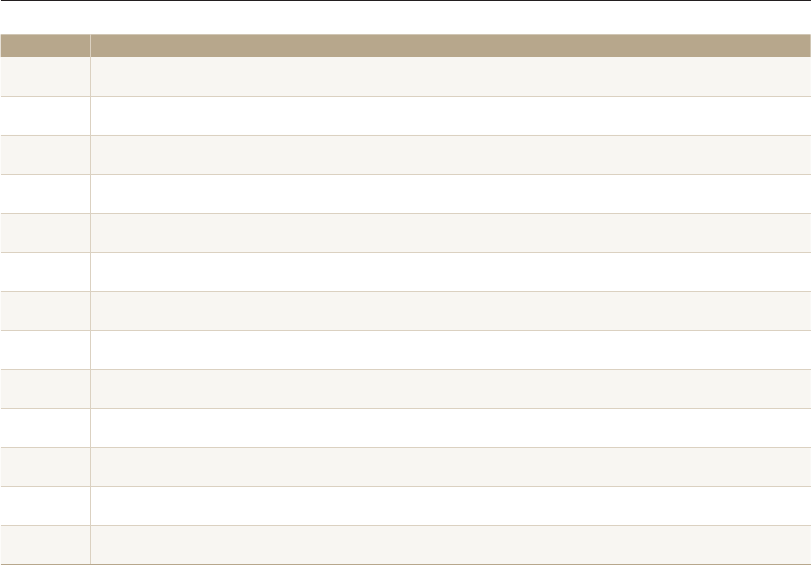
Appendixes
152
Declaration sentence in official languages
Nation Declaration
Malti Hawnhekk, Samsung Electronics, tiddikjara li din il-kamera diġitali hi konformi mar-rekwiżiti essenzjali u ma' dispożizzjonijiet rilevanti
oħrajn ta' Direttiva 1999/5/KE.
Magyar A Samsung Electronics kijelenti, hogy ez a digitális fényképezőgép megfelel az 1999/5/EK irányelv alapvetõ követelményeinek és
egyéb vonatkozó elõírásainak.
Polski Niniejszym firma Samsung Electronics oświadcza, że ten aparat cyfrowy jest zgodny z zasadniczymi wymogami oraz pozostałymi
stosownymi postanowieniami Dyrektywy 1999/5/WE.
Português Samsung Electronics declara que esta câmera digital está conforme os requisitos essenciais e outras disposições da Directiva
1999/5/CE.
Slovensko Samsung Electronics izjavlja, da je ta digitalni fotoaparat v skladu z bistvenimi zahtevami in ostalimi relevantnimi določili direktive
1999/5/ES.
Slovensky Samsung Electronics týmto vyhlasuje, že tento digitálny fotoaparát spĺňa základné požiadavky a všetky príslušné ustanovenia
Smernice 1999/5/ES.
Suomi Samsung Electronics vakuuttaa täten että tämä digitaalikamera on direktiivin 1999/5/EY oleellisten vaatimusten ja sitä koskevien
direktiivin muiden ehtojen mukainen.
Svenska Härmed intygar Samsung Electronicsatt dessa digitalkameror står i överensstämmelse med de väsentliga egenskapskrav och övriga
relevanta bestämmelser som framgår av direktiv 1999/5/EG.
Български С настоящото Samsung Electronics декларира, че този цифров фотоапарат е в съответствие със съществените изисквания и
другите приложими разпоредби на Директива 1999/5/ЕК.
RomânăPrin prezenta, Samsung Electronics, declară că această cameră foto digitală este în conformitate cu cerinţele esenţiale şi alte
prevederi relevante ale Directivei 1999/5/CE.
Norsk Samsung Electronicserklærer herved at dette digitalkameraet er i samsvar med de grunnleggende krav og øvrige relevante krav i
direktiv 1999/5/EF.
Türkiye Bu belge ile, Samsung Electronics bu dijital kameranın 1999/5/EC Yönetmeliginin temel gerekliliklerine ve ilgili hükümlerine uygun
olduğunu beyan eder.
Íslenska Hér með lýsir Samsung Electronics því yfir að þessi stafræna myndavél sé í samræmi við grunnkröfur og önnur ákvæði tilskipunar
1999/5/EB.

Please refer to the warranty that came with your product or
visit our website, www.samsung.com, for after-sales service or inquiries.

